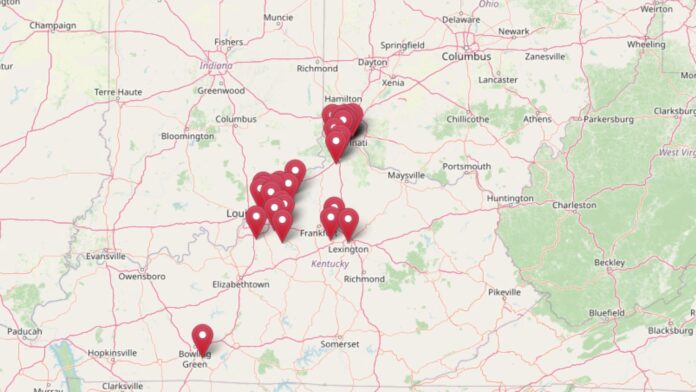Using the latest Zillow Home Value Index data, we’ve ranked the 30 most expensive towns in Kentucky based on current home prices. These communities represent Kentucky’s premium real estate markets, reflecting decades of growth, strategic locations, and strong local economies. Most have experienced remarkable appreciation, with several towns more than doubling their values since 2010.
From Oldham County’s luxury enclaves to Northern Kentucky’s upscale Cincinnati suburbs, each town on this list offers unique advantages that justify premium pricing. Whether you’re exploring investment opportunities, considering relocation, or simply curious about Kentucky’s housing landscape, this comprehensive analysis reveals where the state’s highest property values are concentrated and why they continue climbing.
30. Lexington – 95% Home Price Increase Since 2010
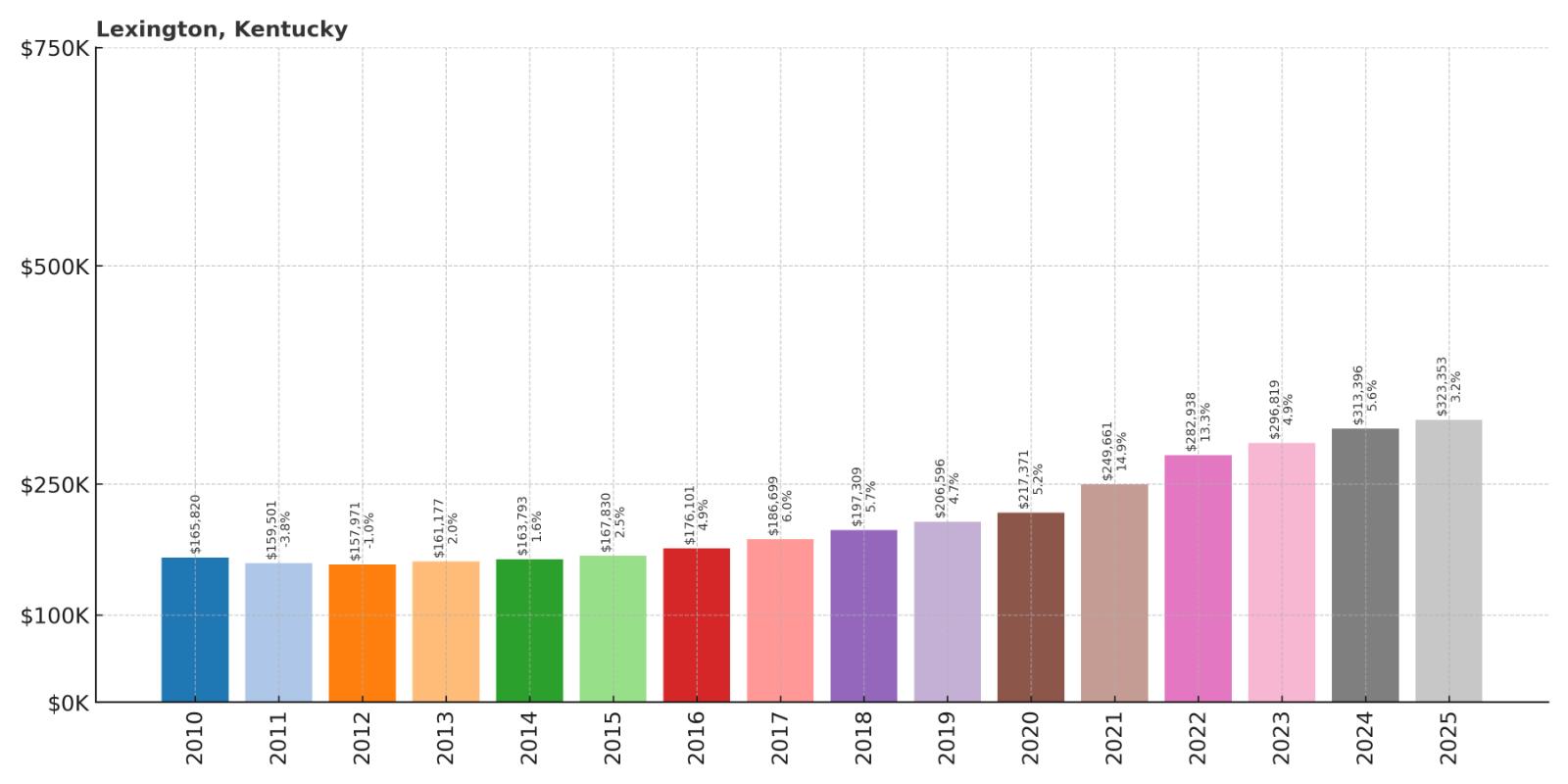
- 2010: $165,820
- 2011: $159,501
- 2012: $157,971
- 2013: $161,177
- 2014: $163,793
- 2015: $167,830
- 2016: $176,101
- 2017: $186,699
- 2018: $197,309
- 2019: $206,596
- 2020: $217,371
- 2021: $249,661
- 2022: $282,938
- 2023: $296,819
- 2024: $313,396
- 2025: $323,353
Lexington has achieved steady growth since hitting a low point in 2012, climbing nearly 95% from its 2010 baseline. The most dramatic acceleration occurred during the 2021-2022 surge when values jumped over $33,000 in just one year. By July 2025, median home prices reached $323,353, reflecting the area’s strong job market and educational institutions.
Why Lexington?
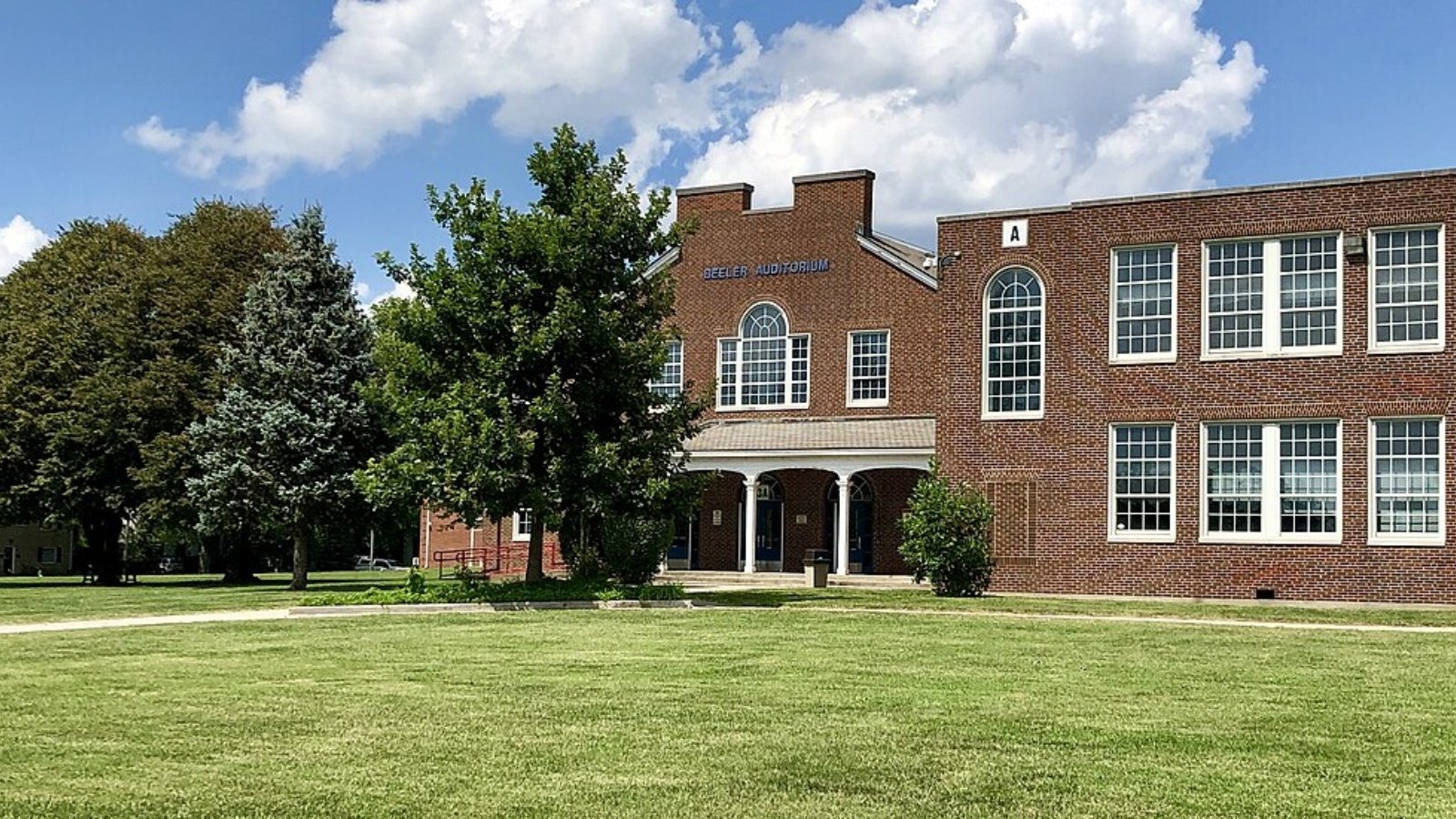
Why Are People Willing to Pay So Much to Live Here? What’s Special About It?
Lexington offers a rare combination of university town culture and economic opportunity as Kentucky’s second-largest city. Home to the University of Kentucky and surrounded by world-famous horse farms, the city provides excellent schools, healthcare facilities, and a thriving downtown district. The presence of major employers like Toyota and Lexmark, combined with the university’s research facilities, creates diverse career opportunities.
💼🏠 When the CEO of the biggest real estate brokerage on the planet speaks about buying or selling, it’s worth listening. Hear what Robert Refkin has to say.
Unlike many college towns, Lexington maintains year-round economic stability through its healthcare sector, government jobs, and equine industry. The city’s compact size makes commuting manageable while offering big-city amenities including restaurants, cultural venues, and professional sports. The historic Bluegrass region setting adds natural beauty and recreational opportunities that enhance quality of life.
How Lexington Rose to Prominence
Founded in 1775, Lexington earned the nickname “Athens of the West” for its early emphasis on education and culture. The city’s strategic location in the heart of Kentucky’s fertile Bluegrass region made it a natural hub for agriculture, particularly hemp and tobacco production. The establishment of Transylvania University in 1780 cemented its reputation as an educational center.
The 20th century brought diversification as the University of Kentucky expanded and major corporations relocated operations here. Toyota’s decision to build a massive manufacturing plant nearby in Georgetown during the 1980s created thousands of high-paying jobs and attracted suppliers. Meanwhile, the thoroughbred horse industry evolved from traditional farming into a sophisticated global business, anchoring luxury real estate demand in surrounding areas.
3 Interesting Tidbits
1. Horse Capital Heritage – Lexington sits at the center of Kentucky’s $4 billion equine industry, with over 450 horse farms within a 30-mile radius producing champion thoroughbreds.
2. Bourbon Trail Hub – The city serves as a gateway to Kentucky’s famous Bourbon Trail, with several world-renowned distilleries located within an hour’s drive.
3. Innovation District – Lexington’s downtown core features a growing technology and healthcare innovation district, attracting startups and established companies seeking to tap into university research.
29. Crestview Hills – 81% Home Price Increase Since 2010
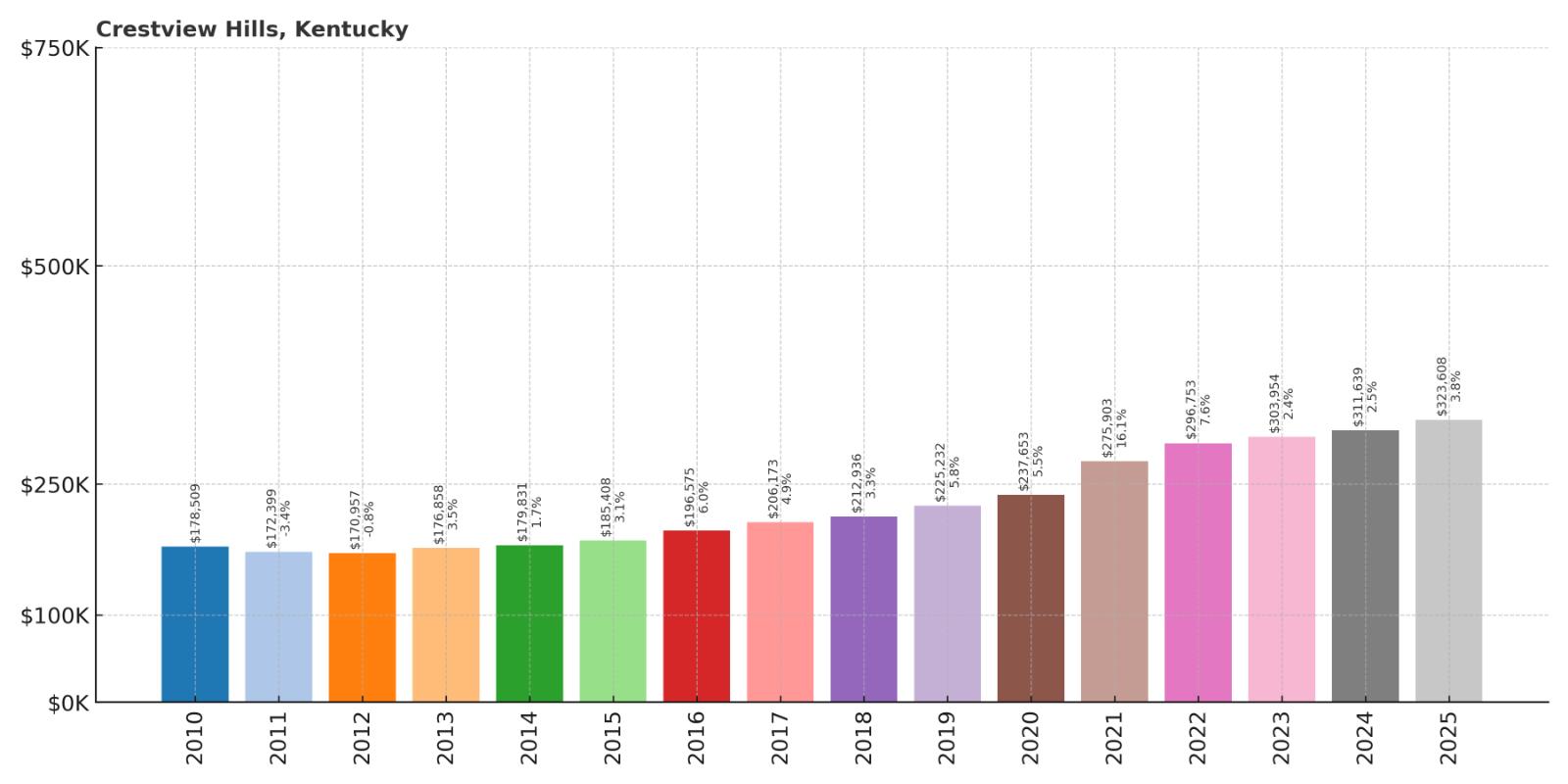
- 2010: $178,509
- 2011: $172,399
- 2012: $170,957
- 2013: $176,858
- 2014: $179,831
- 2015: $185,408
- 2016: $196,575
- 2017: $206,173
- 2018: $212,936
- 2019: $225,232
- 2020: $237,653
- 2021: $275,903
- 2022: $296,753
- 2023: $303,954
- 2024: $311,639
- 2025: $323,608
Crestview Hills has shown resilient growth despite early-2010s market challenges, ultimately gaining 81% since 2010. The community experienced its strongest appreciation during the pandemic years, with values jumping over $70,000 between 2020 and 2022. Current median prices of $323,608 reflect sustained demand for this Northern Kentucky location.
Why Crestview Hills?
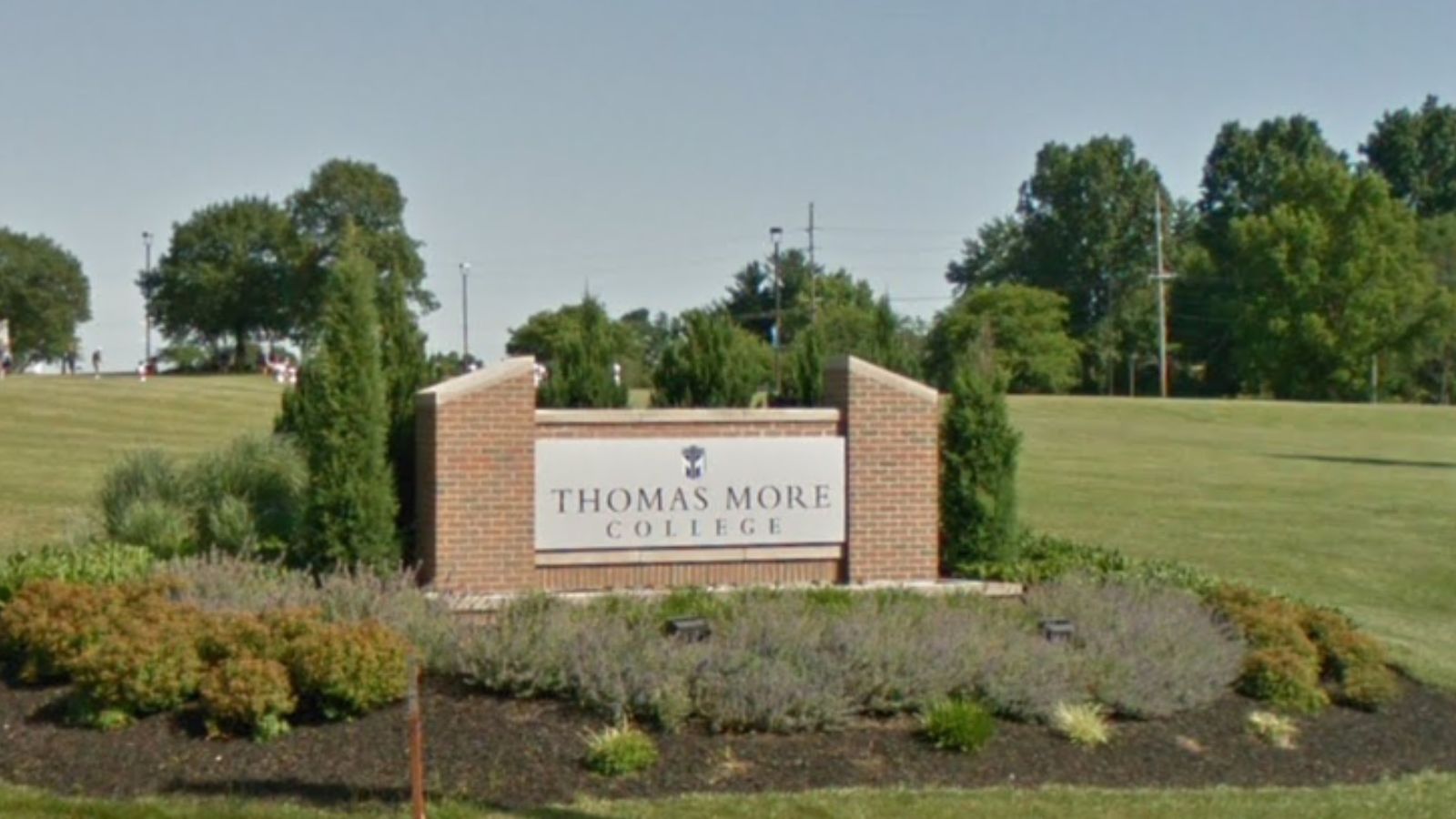
Why Are People Willing to Pay So Much to Live Here? What’s Special About It?
Crestview Hills attracts residents seeking upscale suburban living with easy access to Cincinnati’s job market and cultural amenities. The community features the popular Crestview Hills Town Center, providing high-end shopping and dining options within walking distance. Families value the excellent schools, well-maintained neighborhoods, and abundant green space.
The strategic location offers the best of both worlds – suburban tranquility with urban convenience. Residents enjoy short commutes to downtown Cincinnati via Interstate 275 while living in a community known for low crime rates and strong property maintenance standards. The area’s rolling hills and mature trees create an attractive setting that enhances property values.
How Crestview Hills Rose to Prominence
Originally rural farmland in Kenton County, Crestview Hills began developing in the 1960s as Cincinnati’s suburbs expanded southward across the Ohio River. The community was officially incorporated in 1979, establishing strict zoning and development standards that preserved its upscale character. Early development focused on large-lot single-family homes that attracted affluent professionals.
The construction of Crestview Hills Town Center in the early 2000s transformed the community into a regional destination, adding retail and dining options that enhanced livability. Thomas More University’s presence nearby contributed to the area’s educated population and cultural amenities. Strategic infrastructure investments, including improved highway access, have maintained the community’s appeal to Cincinnati commuters.
3 Interesting Tidbits
1. Shopping Destination – Crestview Hills Town Center features over 80 stores and restaurants, making it Northern Kentucky’s premier retail destination.
2. Corporate Neighbors – The community sits near several major corporate headquarters, including Fidelity Investments and Toyota Motor Sales, providing high-paying employment opportunities.
3. Education Hub – Thomas More University’s campus adds cultural and educational opportunities while contributing to the area’s reputation for learning and innovation.
28. Pendleton – 98% Home Price Increase Since 2010
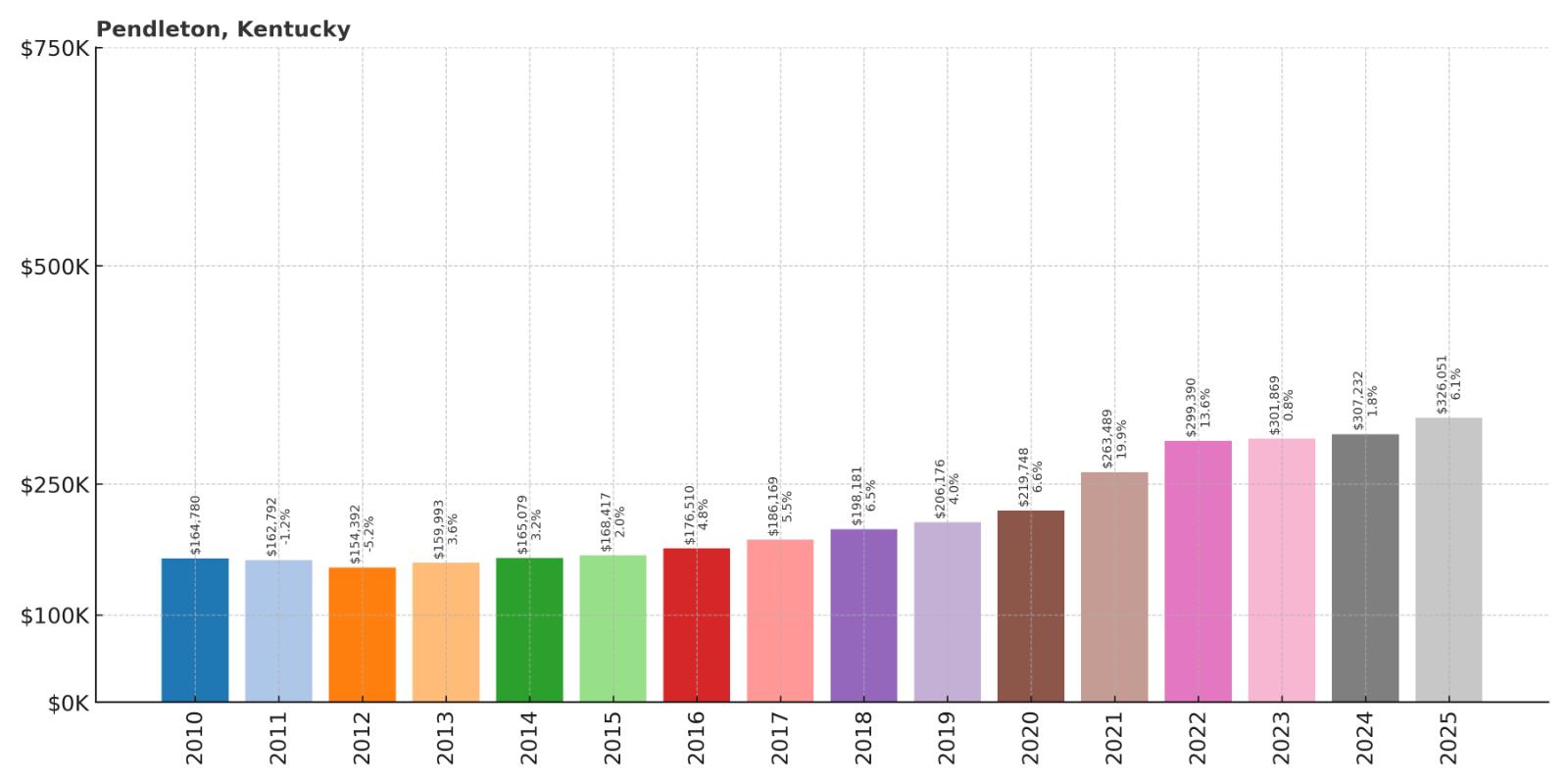
- 2010: $164,780
- 2011: $162,792
- 2012: $154,392
- 2013: $159,993
- 2014: $165,079
- 2015: $168,417
- 2016: $176,510
- 2017: $186,169
- 2018: $198,181
- 2019: $206,176
- 2020: $219,748
- 2021: $263,489
- 2022: $299,390
- 2023: $301,869
- 2024: $307,232
- 2025: $326,051
Pendleton has nearly doubled in value since 2010, with particularly strong momentum after 2020 when prices climbed from $219,748 to $326,051. After struggling through the early 2010s recession, the market found its footing and delivered consistent appreciation. The 98% total increase demonstrates the community’s growing appeal in Northern Kentucky’s competitive market.
Why Pendleton?
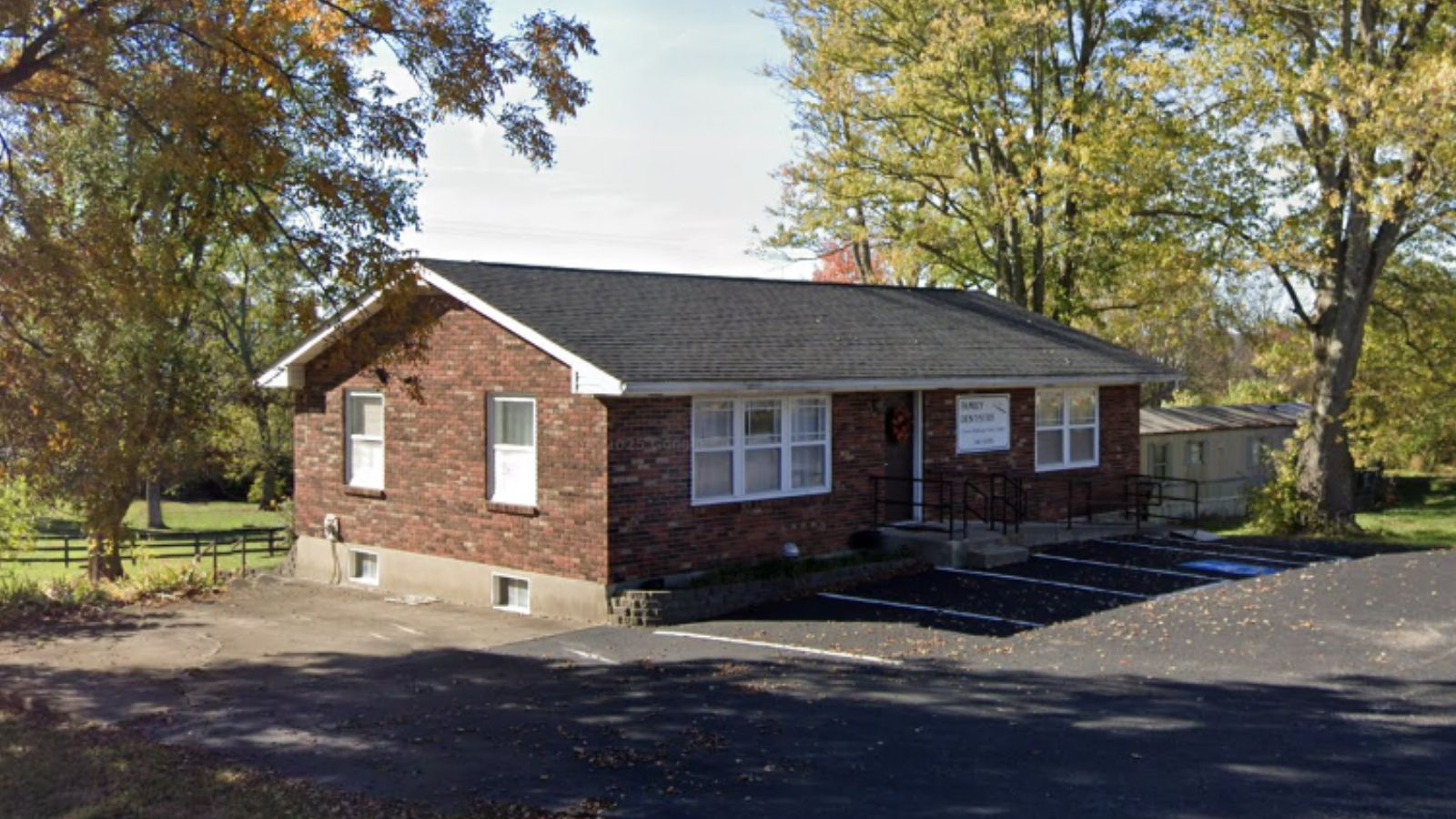
Why Are People Willing to Pay So Much to Live Here? What’s Special About It?
Pendleton offers small-town charm with big-city access, positioned perfectly for Cincinnati commuters who want space and tranquility. The community features historic architecture, tree-lined streets, and a walkable downtown district with local shops and restaurants. Residents appreciate the strong sense of community fostered by annual festivals and civic organizations.
The area provides excellent value compared to similar communities closer to Cincinnati, offering larger lots and more affordable housing while maintaining quality schools and low crime rates. Pendleton’s location along major transportation corridors ensures easy access to employment centers without the congestion of urban living. The surrounding countryside offers recreational opportunities including hiking, fishing, and outdoor sports.
How Pendleton Rose to Prominence
Established in 1820, Pendleton began as an agricultural center serving the fertile farmland of Campbell County. The community’s location along major travel routes between Cincinnati and Lexington made it a natural stopping point for commerce and settlement. The arrival of railroad service in the late 1800s boosted economic development and population growth.
Throughout the 20th century, Pendleton maintained its agricultural roots while gradually attracting suburban residents seeking country living near urban employment. The completion of Interstate 275 in the 1970s dramatically improved access to Cincinnati, triggering residential development. Recent decades have seen careful growth that preserves the community’s historic character while adding modern amenities and services.
3 Interesting Tidbits
1. Festival Hub – Pendleton hosts several annual festivals, including the popular Fall Festival that draws thousands of visitors each October.
2. Historic Charm – The downtown area features numerous buildings listed on the National Register of Historic Places, preserving 19th-century architecture.
3. Outdoor Recreation – The nearby Licking River provides opportunities for fishing, kayaking, and waterfront recreation just minutes from residential areas.
27. Verona – 88% Home Price Increase Since 2010
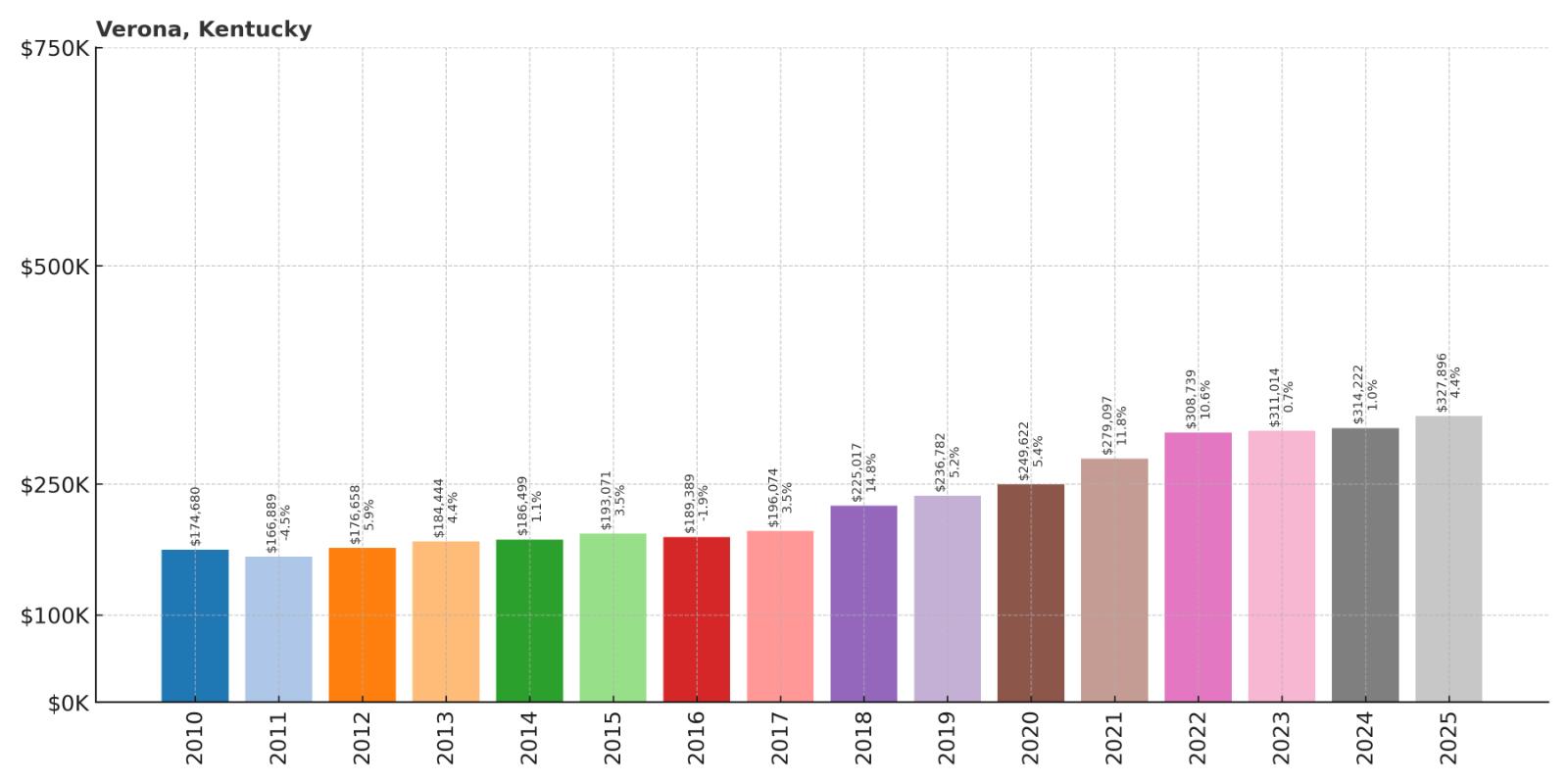
- 2010: $174,680
- 2011: $166,889
- 2012: $176,658
- 2013: $184,444
- 2014: $186,499
- 2015: $193,071
- 2016: $189,389
- 2017: $196,074
- 2018: $225,017
- 2019: $236,782
- 2020: $249,622
- 2021: $279,097
- 2022: $308,739
- 2023: $311,014
- 2024: $314,222
- 2025: $327,896
Verona has delivered solid appreciation with an 88% increase since 2010, showing particular strength after 2017 when values began accelerating rapidly. The community weathered a brief dip in 2016 before resuming upward momentum that continues today. With median prices now at $327,896, Verona represents one of Northern Kentucky’s more affordable entry points to premium suburban living.
Why Verona?
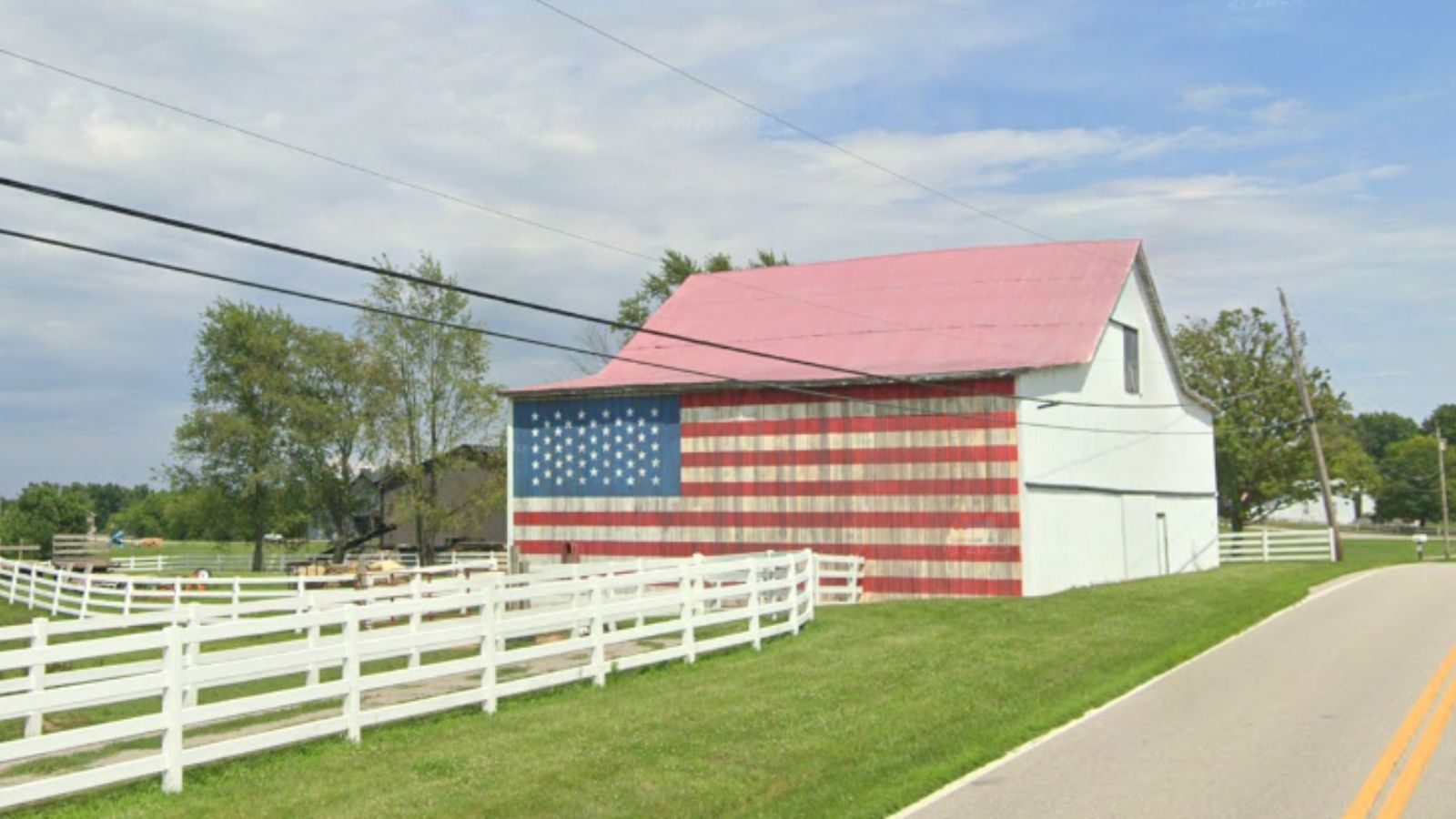
Why Are People Willing to Pay So Much to Live Here? What’s Special About It?
Verona appeals to families seeking quality schools, safe neighborhoods, and convenient access to both Cincinnati and Louisville metropolitan areas. The community offers newer housing developments with modern amenities while maintaining reasonable price points compared to similar suburbs. Local parks and recreation facilities provide excellent opportunities for outdoor activities and youth sports.
The area’s strategic location near major highways makes commuting manageable to multiple employment centers. Verona provides a suburban lifestyle with growing retail and dining options, reducing the need to travel for daily necessities. The strong local school system and active community organizations create an environment focused on family life and long-term stability.
How Verona Rose to Prominence
Originally a small farming community in Boone County, Verona remained largely agricultural until the late 20th century. The construction of Interstate 71/75 and the development of Cincinnati/Northern Kentucky International Airport nearby transformed the area’s accessibility and economic prospects. Suburban expansion from Cincinnati gradually reached Verona during the 1980s and 1990s.
Strategic planning and zoning helped Verona manage its growth while preserving community character. The development of family-oriented subdivisions and the expansion of local schools attracted young professionals and growing families. Recent commercial development has added shopping and dining options, creating a more complete suburban environment that supports continued residential demand.
3 Interesting Tidbits
1. Airport Access – Verona sits just minutes from Cincinnati/Northern Kentucky International Airport, making it popular with frequent travelers and airline employees.
2. Growth Management – The community has successfully balanced rapid growth with infrastructure development, maintaining quality services as population increased.
3. Recreation Focus – Verona features multiple parks and sports complexes, including facilities for baseball, soccer, and youth activities that strengthen community bonds.
26. Midway – 49% Home Price Increase Since 2010
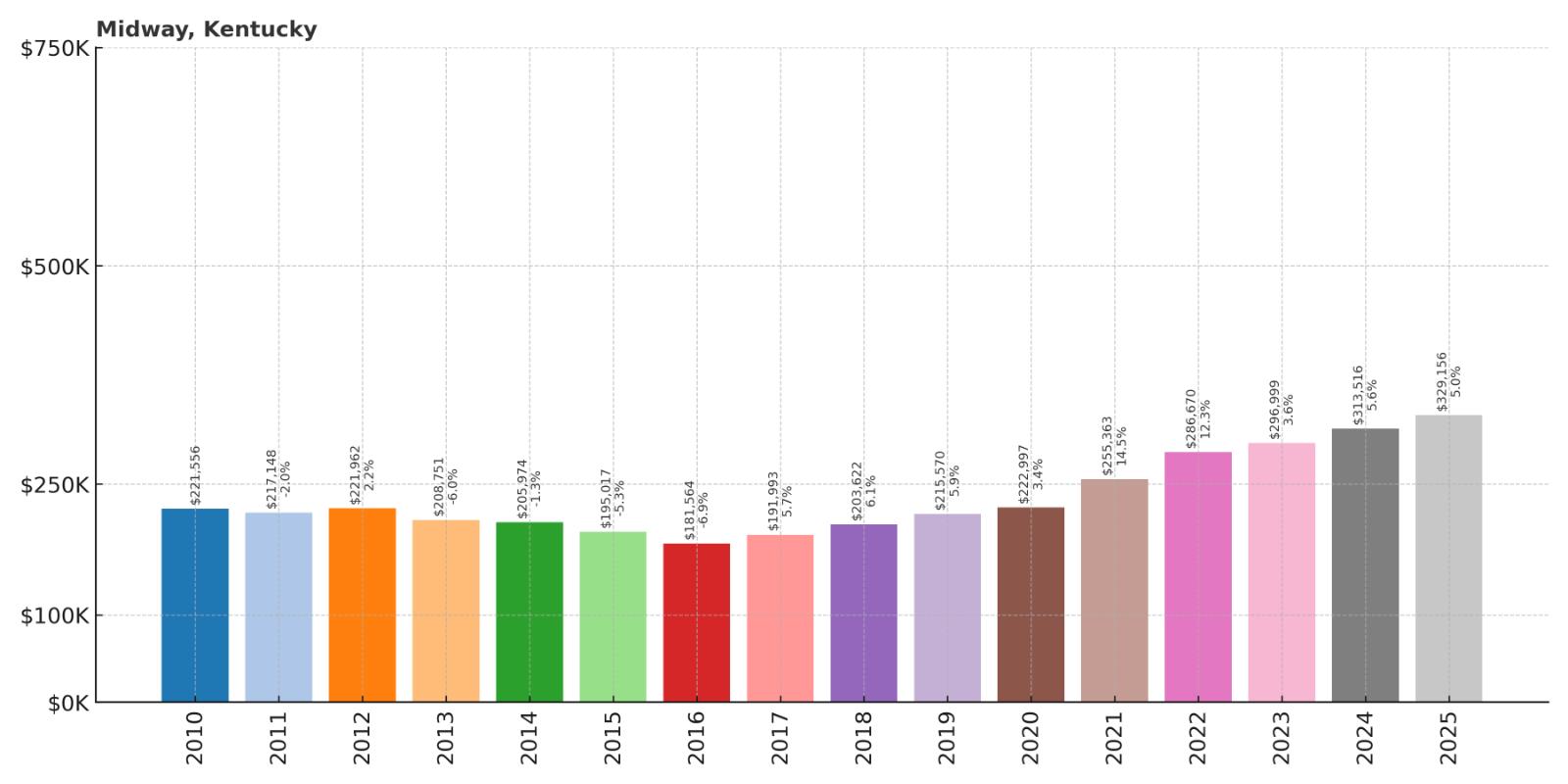
- 2010: $221,556
- 2011: $217,148
- 2012: $221,962
- 2013: $208,751
- 2014: $205,974
- 2015: $195,017
- 2016: $181,564
- 2017: $191,993
- 2018: $203,622
- 2019: $215,570
- 2020: $222,997
- 2021: $255,363
- 2022: $286,670
- 2023: $296,999
- 2024: $313,516
- 2025: $329,156
Midway has experienced a roller-coaster journey, declining significantly through 2016 before staging a remarkable recovery. The 49% overall increase masks the volatility, with values falling as low as $181,564 in 2016 before surging 81% to current levels of $329,156. This recovery demonstrates the underlying strength of Kentucky’s historic horse country.
Why Midway?

Why Are People Willing to Pay So Much to Live Here? What’s Special About It?
Midway offers an authentic Kentucky horse country experience, surrounded by some of the world’s most prestigious thoroughbred farms and rolling Bluegrass countryside. The historic downtown district features antique shops, local restaurants, and venues that host events and festivals throughout the year. Residents value the small-town atmosphere combined with proximity to Lexington’s amenities and employment opportunities.
The community provides a unique lifestyle centered around equestrian activities and rural living. Many properties feature acreage suitable for horses and hobby farming, appealing to affluent buyers seeking a country estate atmosphere. The area’s natural beauty and connection to Kentucky’s signature industry create a distinctive character that commands premium pricing.
How Midway Rose to Prominence
Founded in 1835 at the midpoint of the railroad line between Frankfort and Lexington, Midway earned its name from this strategic location. The community quickly became a shipping point for local agricultural products and a transportation hub for the emerging Bluegrass region. The arrival of the railroad brought prosperity and established Midway as a significant commercial center.
The 20th century saw Midway evolve into the heart of Kentucky’s thoroughbred industry as horse farms expanded throughout the surrounding countryside. The community’s Victorian architecture and railroad heritage attracted preservation efforts and tourism development. Recent decades have seen Midway capitalize on its historic charm and equestrian connections to attract affluent residents and visitors seeking an authentic Kentucky experience.
3 Interesting Tidbits
1. Railroad Heritage – Midway is home to one of Kentucky’s few remaining active railroad depots, celebrating its transportation history with regular train excursions.
2. Thoroughbred Central – The community sits surrounded by legendary horse farms including Darley and WinStar Farm, home to multiple Kentucky Derby winners.
3. Festival Destination – Midway’s Fall Meet festival draws thousands of visitors annually, celebrating the area’s railroad history and equestrian culture.
25. Fort Wright – 92% Home Price Increase Since 2010
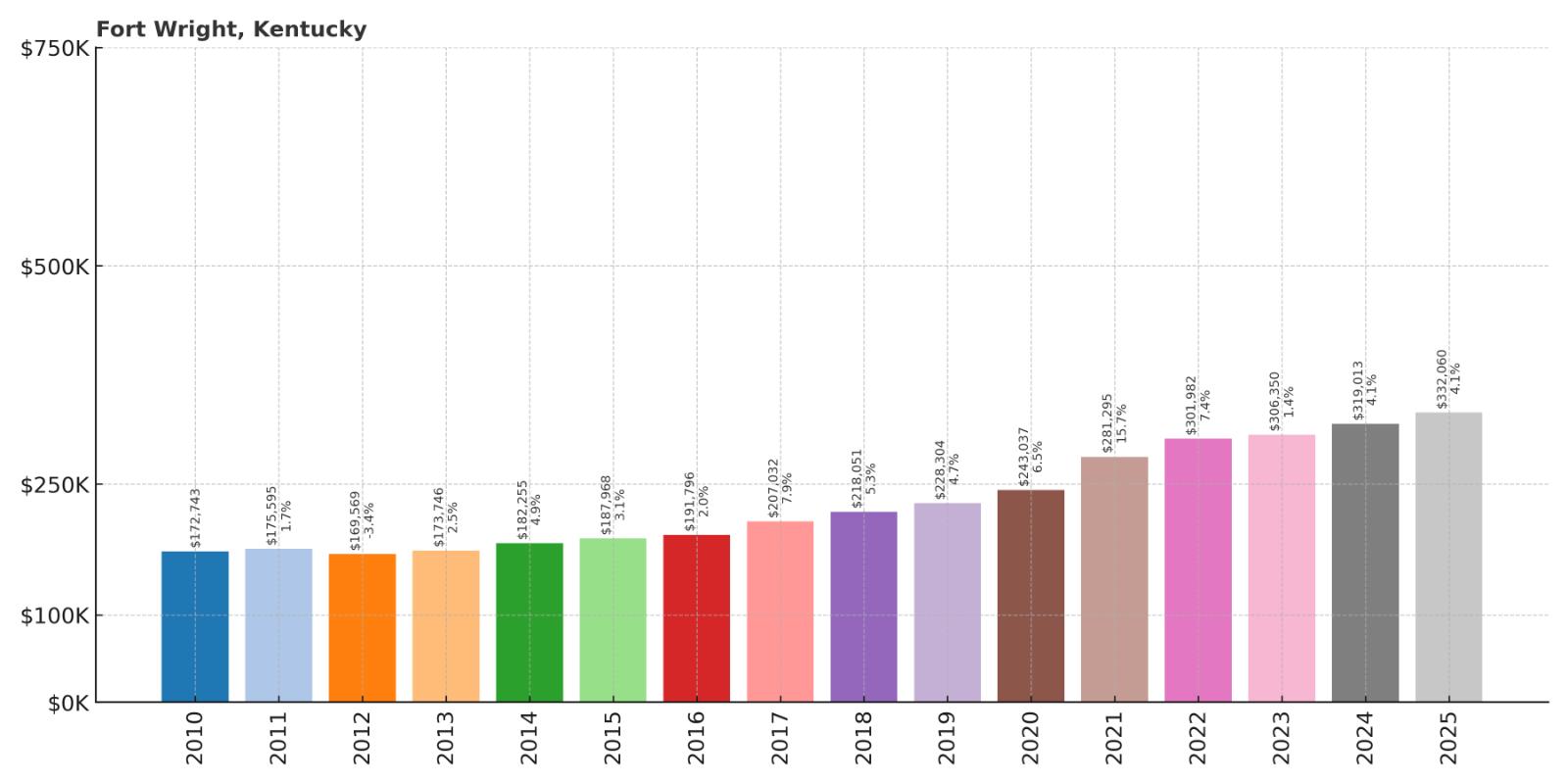
- 2010: $172,743
- 2011: $175,595
- 2012: $169,569
- 2013: $173,746
- 2014: $182,255
- 2015: $187,968
- 2016: $191,796
- 2017: $207,032
- 2018: $218,051
- 2019: $228,304
- 2020: $243,037
- 2021: $281,295
- 2022: $301,982
- 2023: $306,350
- 2024: $319,013
- 2025: $332,060
Fort Wright has achieved steady growth with a 92% increase since 2010, showing particular acceleration after 2020 when values jumped from $243,037 to current levels of $332,060. The consistent upward trajectory reflects the community’s desirable location and well-maintained character. This Northern Kentucky suburb has proven resilient through various market cycles.
Why Fort Wright?
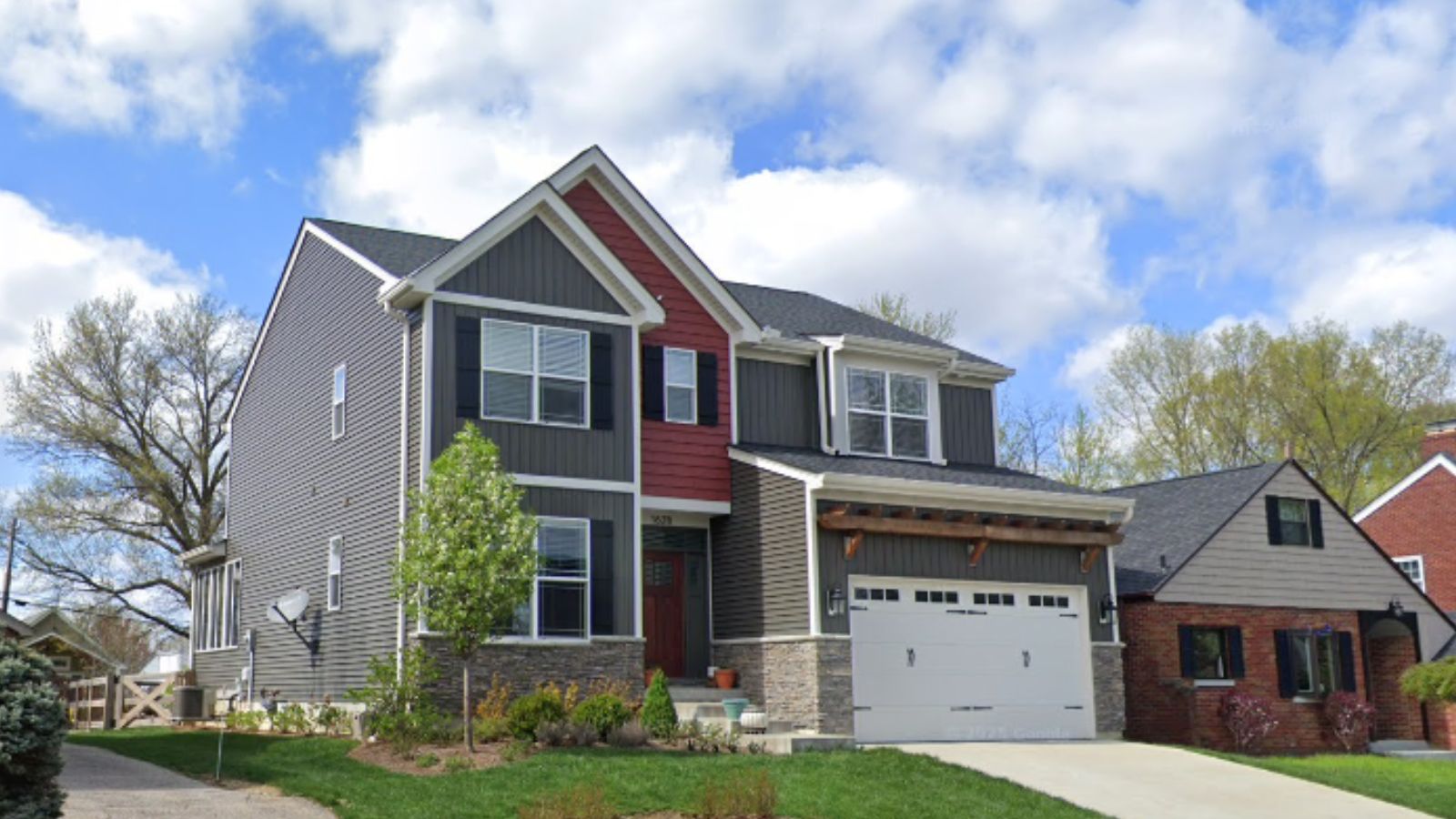
Why Are People Willing to Pay So Much to Live Here? What’s Special About It?
Fort Wright offers an established suburban community with tree-lined streets, well-maintained homes, and excellent access to Cincinnati employment centers. The area features quality schools, numerous parks, and recreational facilities that support family-oriented living. Residents appreciate the community’s stability and the mature neighborhood character that comes with decades of careful development.
The location provides convenient access to major highways while maintaining a residential atmosphere removed from commercial corridors. Fort Wright’s proximity to Cincinnati allows residents to enjoy big-city amenities including professional sports, cultural venues, and diverse employment opportunities. The community’s established infrastructure and services create a comfortable living environment that attracts long-term residents.
How Fort Wright Rose to Prominence
Named after a Civil War fort that once occupied the area, Fort Wright was incorporated in 1962 as Cincinnati’s suburban expansion reached across the Ohio River into Northern Kentucky. The community developed as a planned residential area with strict zoning and architectural standards that preserved its suburban character. Early development focused on single-family homes for middle and upper-middle-class families.
The completion of Interstate 275 in the 1970s enhanced Fort Wright’s accessibility to Cincinnati and other regional employment centers. The community successfully maintained its residential character while adding parks, recreational facilities, and services needed by growing families. Strategic planning has preserved green space and prevented overdevelopment, maintaining property values and quality of life.
3 Interesting Tidbits
1. Historic Namesake – The community takes its name from a Civil War fortification that protected Cincinnati from Confederate raids during the 1860s.
2. Park System – Fort Wright maintains an extensive network of parks and green spaces, including the popular Beechwood Park with walking trails and sports facilities.
3. Strategic Location – The community sits at the intersection of major highways, providing quick access to Cincinnati, the airport, and other Northern Kentucky destinations.
24. Walton – 101% Home Price Increase Since 2010
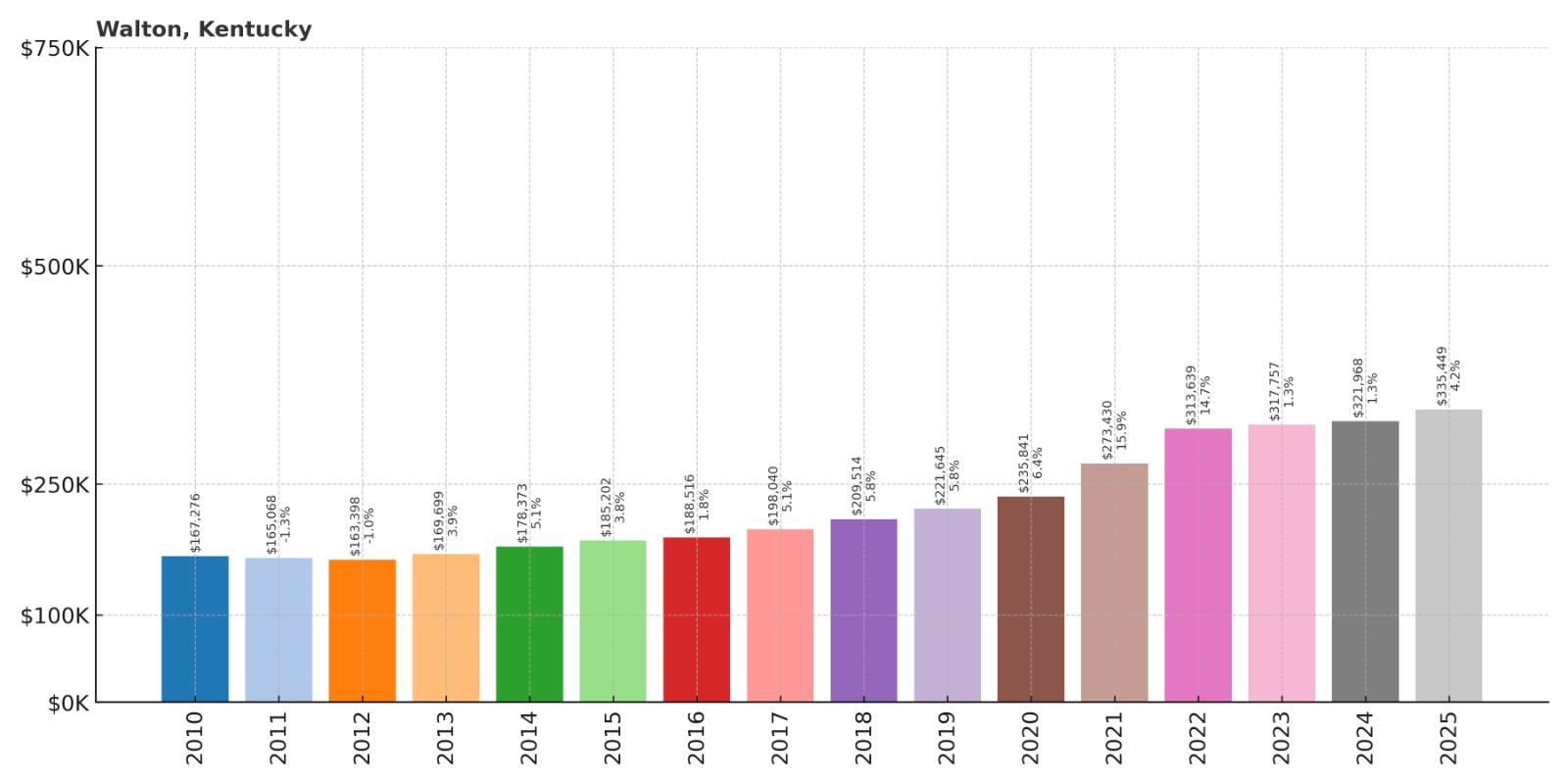
- 2010: $167,276
- 2011: $165,068
- 2012: $163,398
- 2013: $169,699
- 2014: $178,373
- 2015: $185,202
- 2016: $188,516
- 2017: $198,040
- 2018: $209,514
- 2019: $221,645
- 2020: $235,841
- 2021: $273,430
- 2022: $313,639
- 2023: $317,757
- 2024: $321,968
- 2025: $335,449
Walton’s home values have nearly doubled since 2011, jumping from $160,166 to $317,980 in 2025. After bottoming out in 2012, the community has shown remarkable resilience with a 101% increase that now reaches $335,449. The most dramatic acceleration occurred during 2021-2022 when values jumped over $40,000 in just one year.
Why Walton?
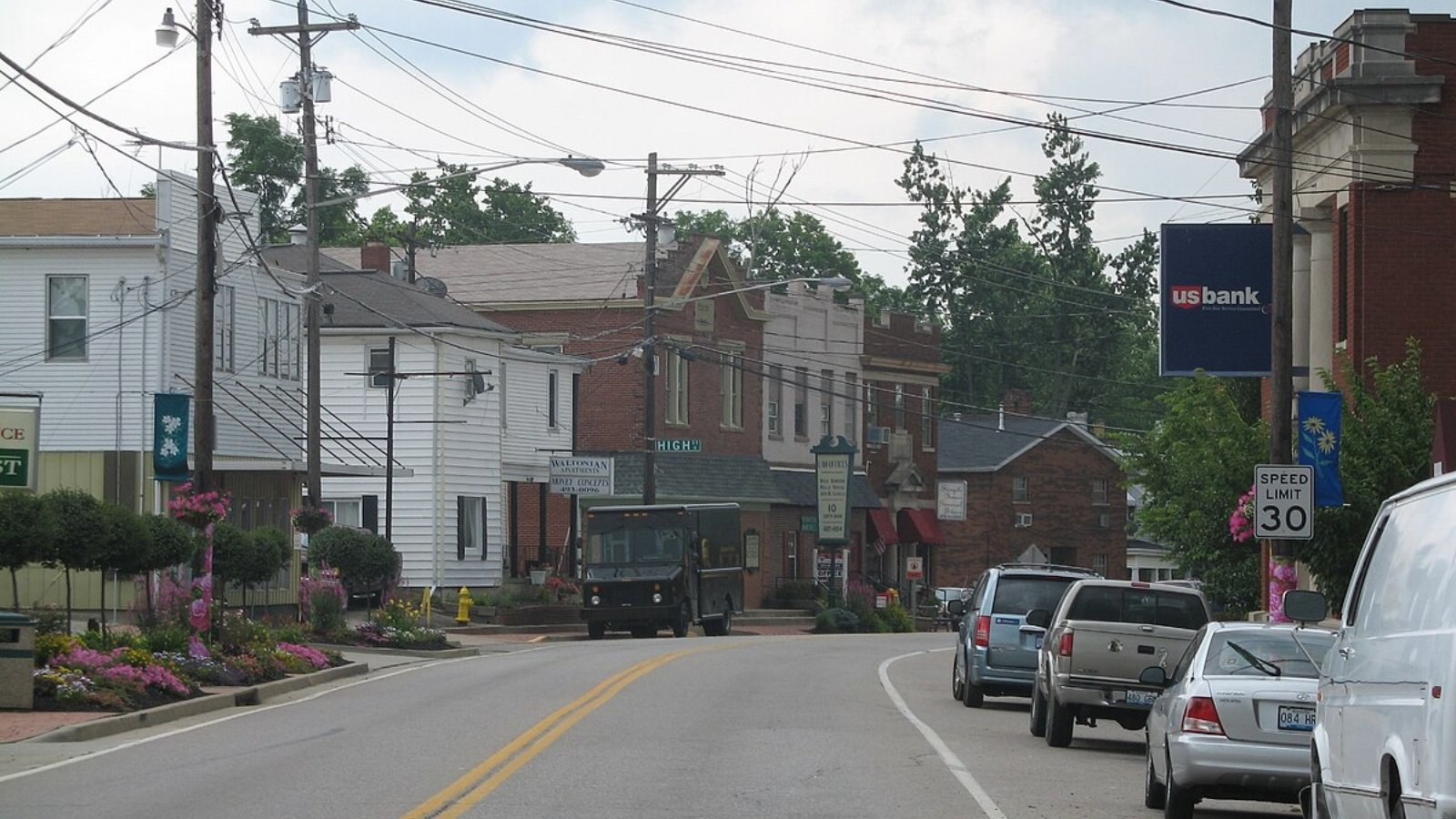
Why Are People Willing to Pay So Much to Live Here? What’s Special About It?
Walton sits in the northern part of Kentucky, within Boone County which borders the Ohio River and Cincinnati metropolitan area. This strategic location offers residents small-town charm with easy access to big-city amenities, explaining its consistent growth trajectory. Families are drawn to the community’s excellent schools, safe neighborhoods, and abundance of new construction offering modern amenities and energy efficiency.
The area provides an attractive alternative to urban living while maintaining reasonable commute times to Cincinnati and Northern Kentucky employment centers. Walton’s growing commercial district includes shopping, dining, and services that reduce dependence on travel to larger cities. The community’s rapid development has been managed to preserve quality of life while providing modern infrastructure and services.
How Walton Rose to Prominence
Originally a small farming community in Boone County, Walton remained largely rural until the late 20th century when suburban expansion from Cincinnati reached the area. The construction of major highways and the development of the Cincinnati/Northern Kentucky International Airport dramatically improved accessibility and economic prospects. This infrastructure development attracted residential and commercial growth.
Strategic planning during the 1990s and 2000s helped Walton manage rapid population growth while maintaining community character. The development of family-oriented subdivisions, the expansion of schools, and the addition of retail centers created a comprehensive suburban environment. The community’s location advantages and quality development standards have sustained strong demand from home buyers seeking modern suburban living.
3 Interesting Tidbits
1. Growth Boom – Walton has been one of Kentucky’s fastest-growing communities, with population increasing over 300% since 1990.
2. Modern Infrastructure – The community features new schools, roads, and utilities designed to support continued growth while maintaining high service standards.
3. Shopping Destination – Walton’s commercial development includes major retail centers that serve both local residents and surrounding communities.
23. Fort Thomas – 70% Home Price Increase Since 2010
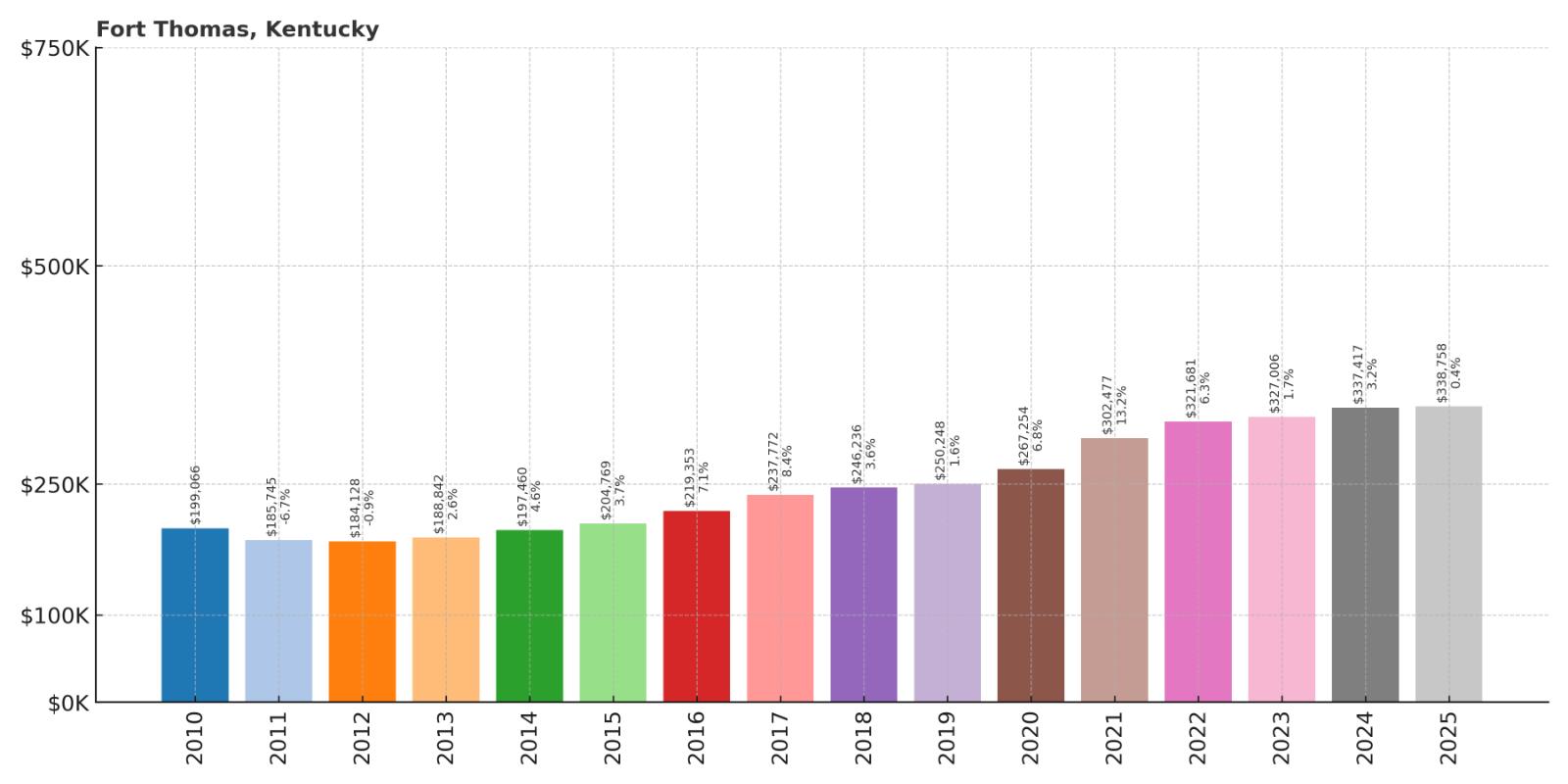
- 2010: $199,066
- 2011: $185,745
- 2012: $184,128
- 2013: $188,842
- 2014: $197,460
- 2015: $204,769
- 2016: $219,353
- 2017: $237,772
- 2018: $246,236
- 2019: $250,248
- 2020: $267,254
- 2021: $302,477
- 2022: $321,681
- 2023: $327,006
- 2024: $337,417
- 2025: $338,758
Fort Thomas has demonstrated steady appreciation with a 70% increase since 2010, recovering from early-decade declines to achieve current median values of $338,758. The community showed consistent growth momentum after 2015, with particularly strong gains during 2021 when values jumped over $35,000. This established Northern Kentucky community continues attracting buyers seeking historic charm and Cincinnati access.
Why Fort Thomas?
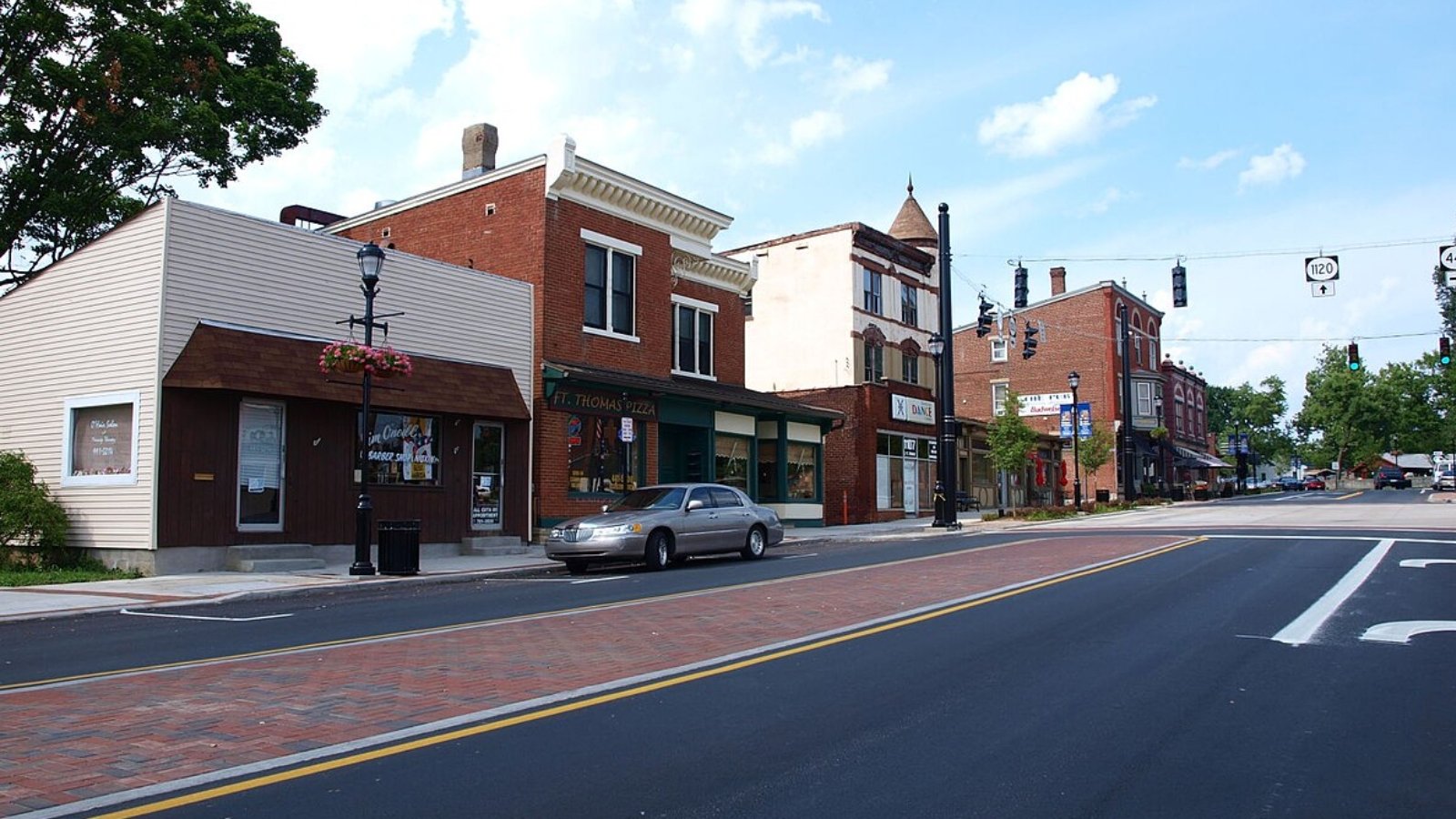
Why Are People Willing to Pay So Much to Live Here? What’s Special About It?
Fort Thomas offers a unique combination of historic character and modern amenities in one of Northern Kentucky’s most established communities. The area features beautiful tree-lined streets, well-preserved architecture, and the scenic Tower Park with its landmark water tower providing panoramic views of the Ohio River valley. Residents value the excellent schools, walkable neighborhoods, and strong community traditions.
The community provides easy access to Cincinnati while maintaining a distinct small-town identity with local shops, restaurants, and cultural venues. Fort Thomas Independent School District is consistently ranked among Kentucky’s best, attracting families willing to pay premium prices for educational quality. The area’s recreational facilities, including parks and sports complexes, support an active lifestyle and community engagement.
How Fort Thomas Rose to Prominence
Established as a military post in 1890, Fort Thomas began as home to the U.S. Army Infantry School before evolving into a residential community. The fort’s strategic location on bluffs overlooking the Ohio River provided both defensive advantages and scenic beauty that attracted permanent residents. When the military departed in the 1940s, the community incorporated and began developing as a Cincinnati suburb.
The preservation of historic military buildings and the development of Tower Park created a distinctive community character that differentiated Fort Thomas from typical suburban developments. The establishment of the highly regarded school district and the careful planning of residential areas attracted middle and upper-middle-class families. The community’s commitment to preserving its historic character while adding modern amenities has maintained its appeal through multiple generations.
3 Interesting Tidbits
1. Military Heritage – Fort Thomas was home to the U.S. Army Infantry School, with many historic military buildings now serving community functions.
2. Tower Park Icon – The community’s landmark water tower offers spectacular views and serves as a symbol of Fort Thomas visible from miles away.
3. School Excellence – Fort Thomas Independent Schools consistently rank among Kentucky’s highest-performing districts, attracting families from across the region.
22. Lakeside Park – 83% Home Price Increase Since 2010
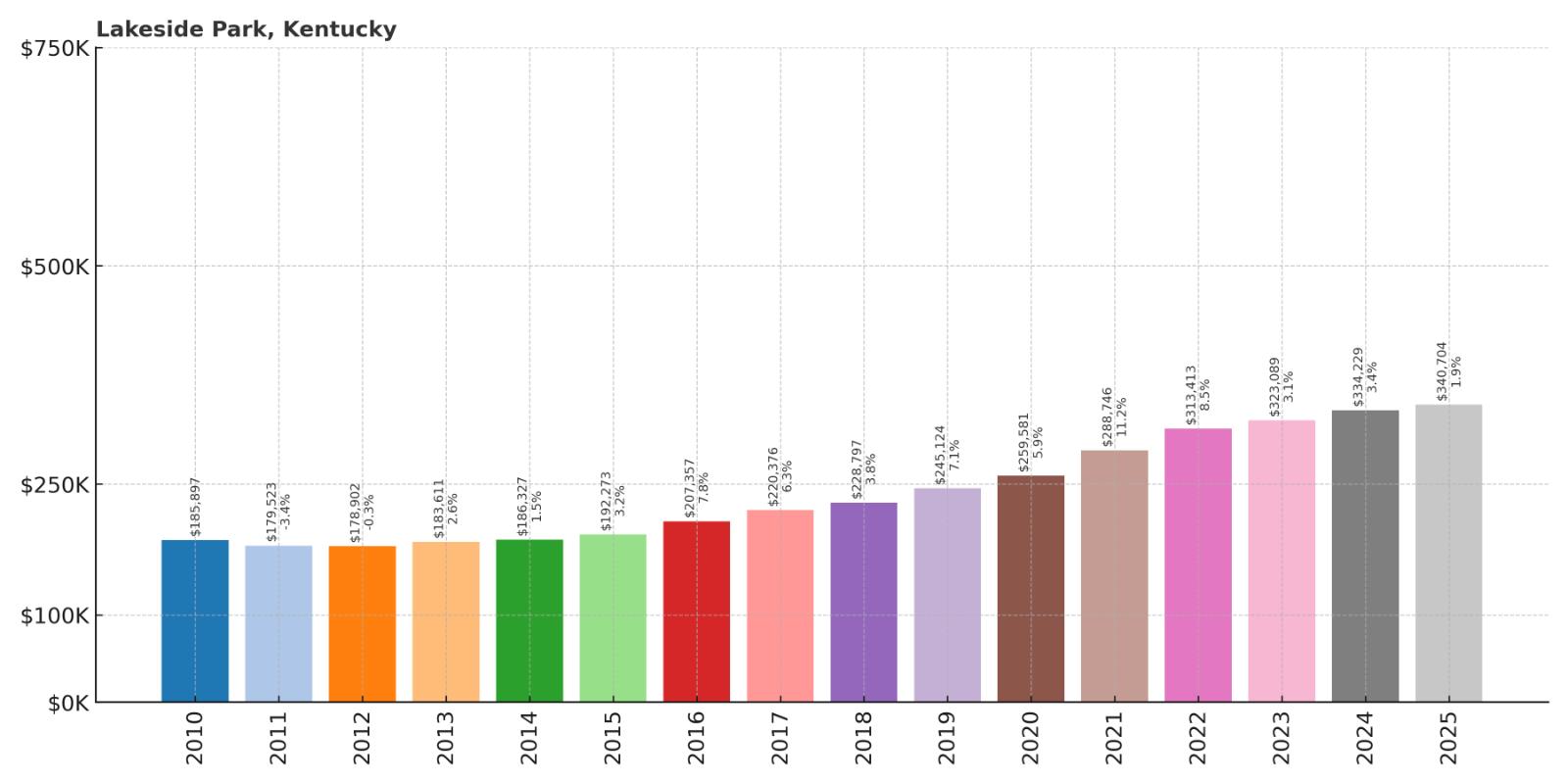
- 2010: $185,897
- 2011: $179,523
- 2012: $178,902
- 2013: $183,611
- 2014: $186,327
- 2015: $192,273
- 2016: $207,357
- 2017: $220,376
- 2018: $228,797
- 2019: $245,124
- 2020: $259,581
- 2021: $288,746
- 2022: $313,413
- 2023: $323,089
- 2024: $334,229
- 2025: $340,704
Lakeside Park has achieved an impressive 83% appreciation since 2010, with steady momentum accelerating after 2015. Current median values of $340,704 reflect the community’s desirable lakefront location and established residential character. The consistent upward trajectory demonstrates sustained demand for this Northern Kentucky community’s unique amenities and Cincinnati accessibility.
Why Lakeside Park?
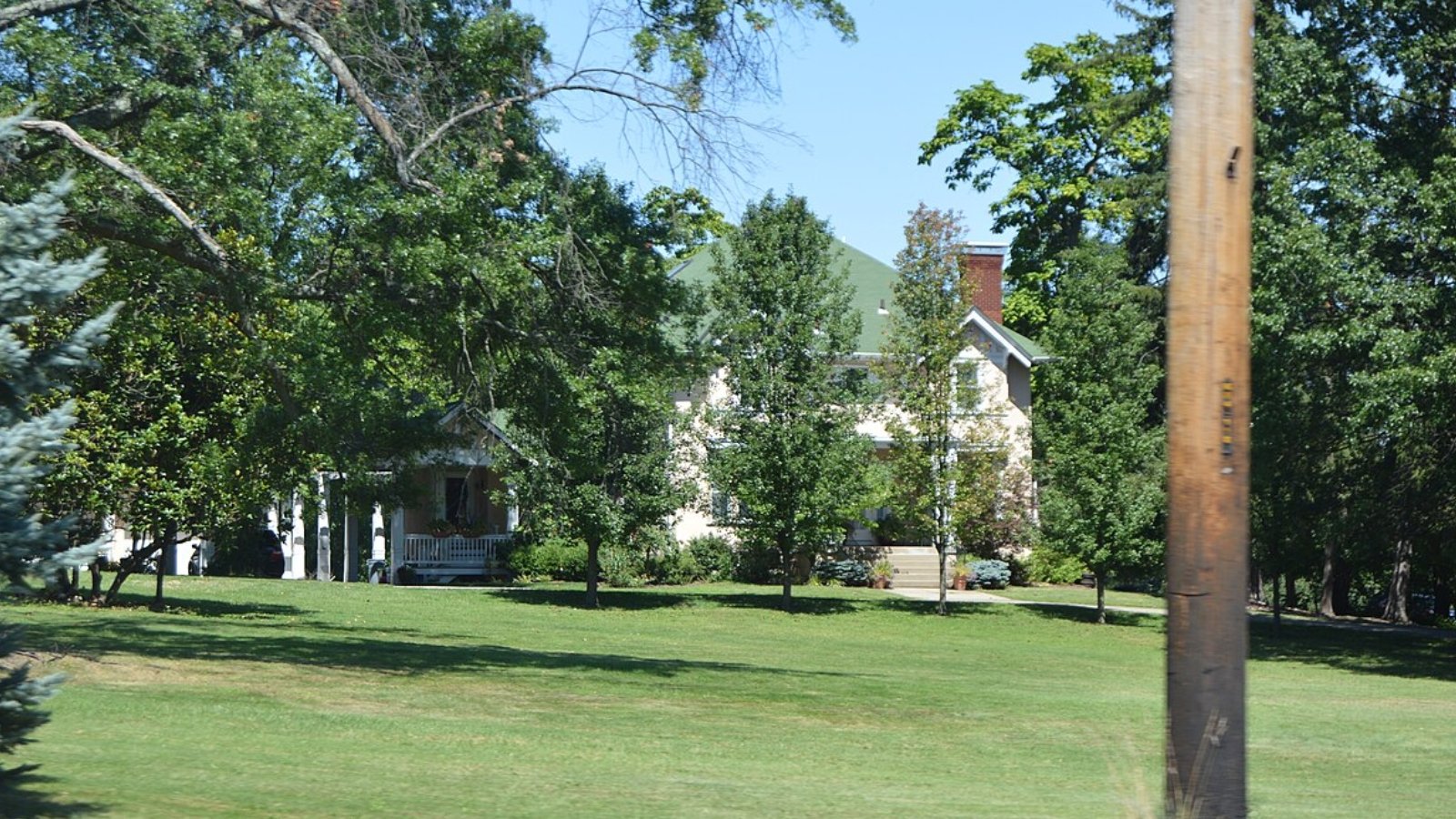
Why Are People Willing to Pay So Much to Live Here? What’s Special About It?
Lakeside Park offers waterfront living in a well-established community with mature trees and scenic lake views. The area features upscale homes on larger lots than many suburban developments, providing privacy and space for outdoor activities. Residents enjoy access to the lake for recreation while maintaining easy commutes to Cincinnati employment centers.
The community combines natural beauty with suburban convenience, offering both tranquil lakeside living and proximity to shopping, dining, and cultural amenities. Lakeside Park’s location provides the benefits of waterfront property without the isolation often associated with rural lake communities. The established neighborhood character and quality construction standards attract buyers seeking long-term stability and appreciation potential.
How Lakeside Park Rose to Prominence
Developed as a planned lakeside community in the mid-20th century, Lakeside Park was designed to take advantage of its scenic location while providing suburban amenities. The community attracted affluent residents seeking waterfront property within commuting distance of Cincinnati. Early development focused on custom homes and larger lots that preserved the natural lakeside setting.
The completion of regional highway systems enhanced Lakeside Park’s accessibility while the community maintained its exclusive character through careful zoning and development standards. The preservation of green space and lake access helped maintain property values through various market cycles. The area’s combination of natural amenities and suburban convenience has sustained demand from buyers seeking unique residential opportunities.
3 Interesting Tidbits
1. Waterfront Lifestyle – Many properties feature direct lake access, providing residents with opportunities for boating, fishing, and water sports.
2. Mature Community – Lakeside Park’s established neighborhood features mature landscaping and custom architecture that creates a distinctive residential character.
3. Natural Preservation – The community has successfully balanced development with environmental conservation, maintaining the lake’s water quality and surrounding ecosystem.
21. Versailles – 113% Home Price Increase Since 2010
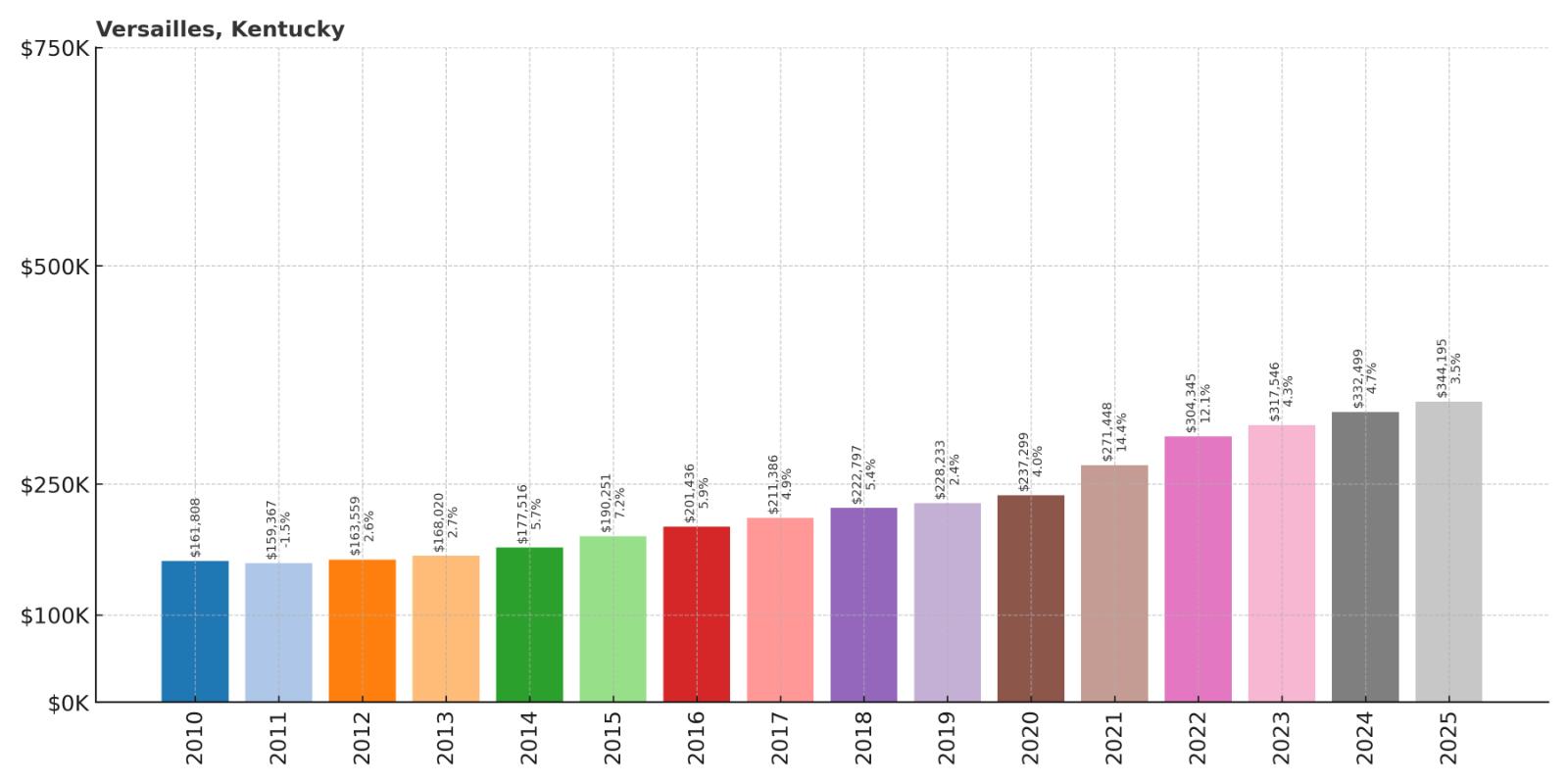
- 2010: $161,808
- 2011: $159,367
- 2012: $163,559
- 2013: $168,020
- 2014: $177,516
- 2015: $190,251
- 2016: $201,436
- 2017: $211,386
- 2018: $222,797
- 2019: $228,233
- 2020: $237,299
- 2021: $271,448
- 2022: $304,345
- 2023: $317,546
- 2024: $332,499
- 2025: $344,195
Versailles has more than doubled in value with a stunning 113% increase since 2010, climbing from $161,808 to $344,195. The growth trajectory shows remarkable consistency with acceleration during pandemic years when values jumped over $75,000 between 2020 and 2022. This Bluegrass region community now represents one of Kentucky’s most appreciating markets outside of Louisville metro.
Why Versailles?
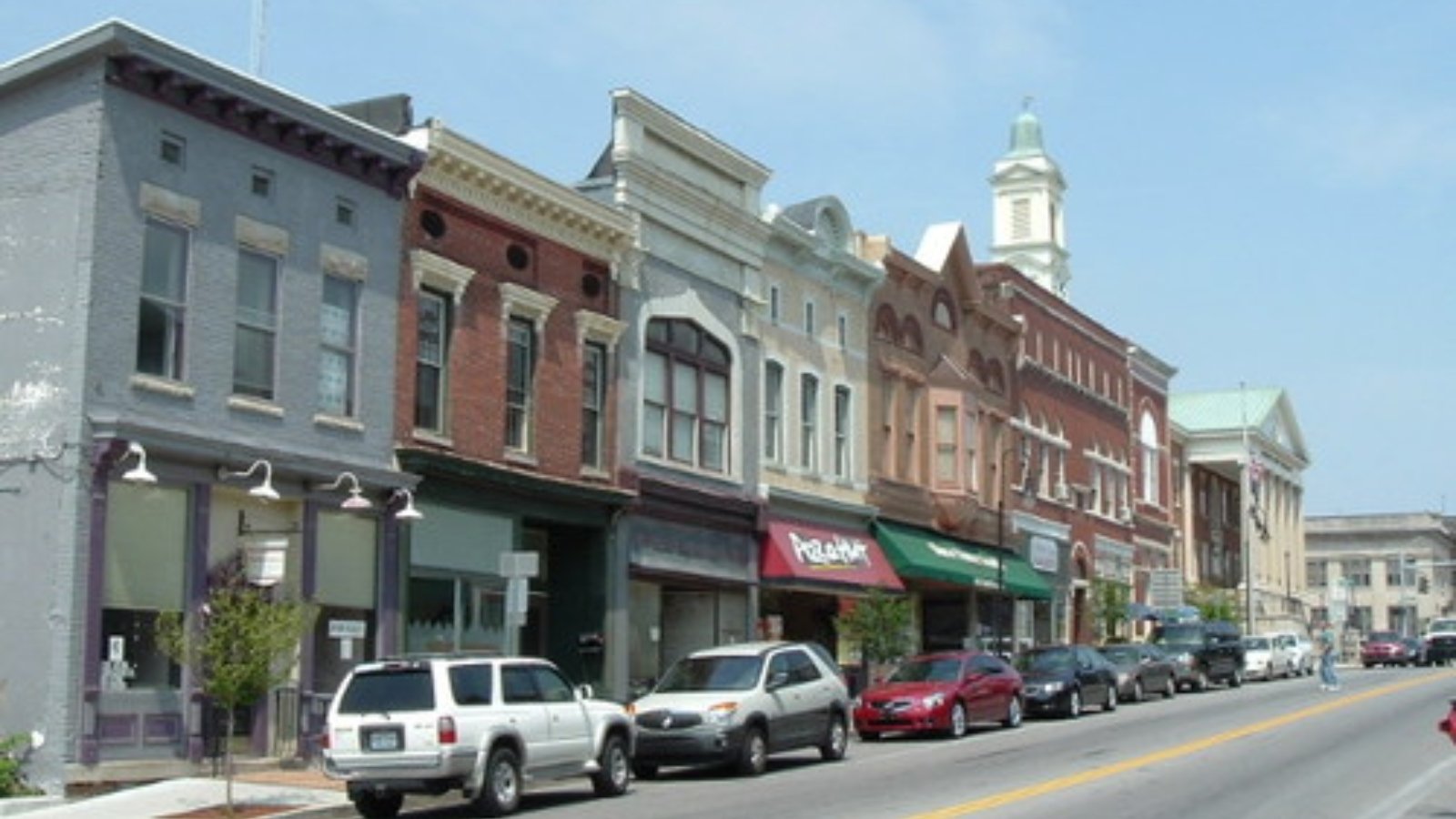
Why Are People Willing to Pay So Much to Live Here? What’s Special About It?
Versailles sits in the heart of Kentucky’s legendary Bluegrass region, surrounded by world-famous horse farms and bourbon distilleries that define the state’s cultural identity. The town offers authentic Kentucky charm with a historic downtown, local festivals, and deep connections to the thoroughbred industry. Residents enjoy small-town living with easy access to both Lexington and Frankfort employment centers.
The area provides a unique lifestyle centered around Kentucky’s signature industries and rural beauty. Many properties offer acreage suitable for horses and country living, appealing to buyers seeking an authentic Bluegrass experience. Versailles maintains its historic character while providing modern amenities and services, creating a distinctive community that commands premium pricing for those seeking genuine Kentucky heritage.
How Versailles Rose to Prominence
Founded in 1792 and named after the French palace, Versailles became the county seat of Woodford County and a center of Kentucky’s emerging agricultural economy. The fertile Bluegrass soil proved ideal for livestock and crop production, establishing the area’s agricultural foundation. The community’s location along major transportation routes made it a natural hub for commerce and government.
The 20th century saw Versailles evolve into the heart of Kentucky’s thoroughbred industry as horse farms expanded throughout Woodford County. The town’s historic courthouse square and Victorian architecture attracted preservation efforts and tourism development. Recent decades have seen Versailles capitalize on its authentic Kentucky character and proximity to major urban centers to attract affluent residents seeking country living with urban access.
3 Interesting Tidbits
1. Bourbon Heritage – Versailles is home to Woodford Reserve Distillery, one of Kentucky’s most prestigious bourbon producers located on a historic site dating to 1812.
2. Horse Farm Capital – The surrounding countryside features some of Kentucky’s most famous thoroughbred farms, including several that have produced Kentucky Derby winners.
3. Historic Courthouse – The town square features a beautiful courthouse built in 1901, serving as the architectural centerpiece of downtown Versailles.
20. Park Hills – 82% Home Price Increase Since 2010
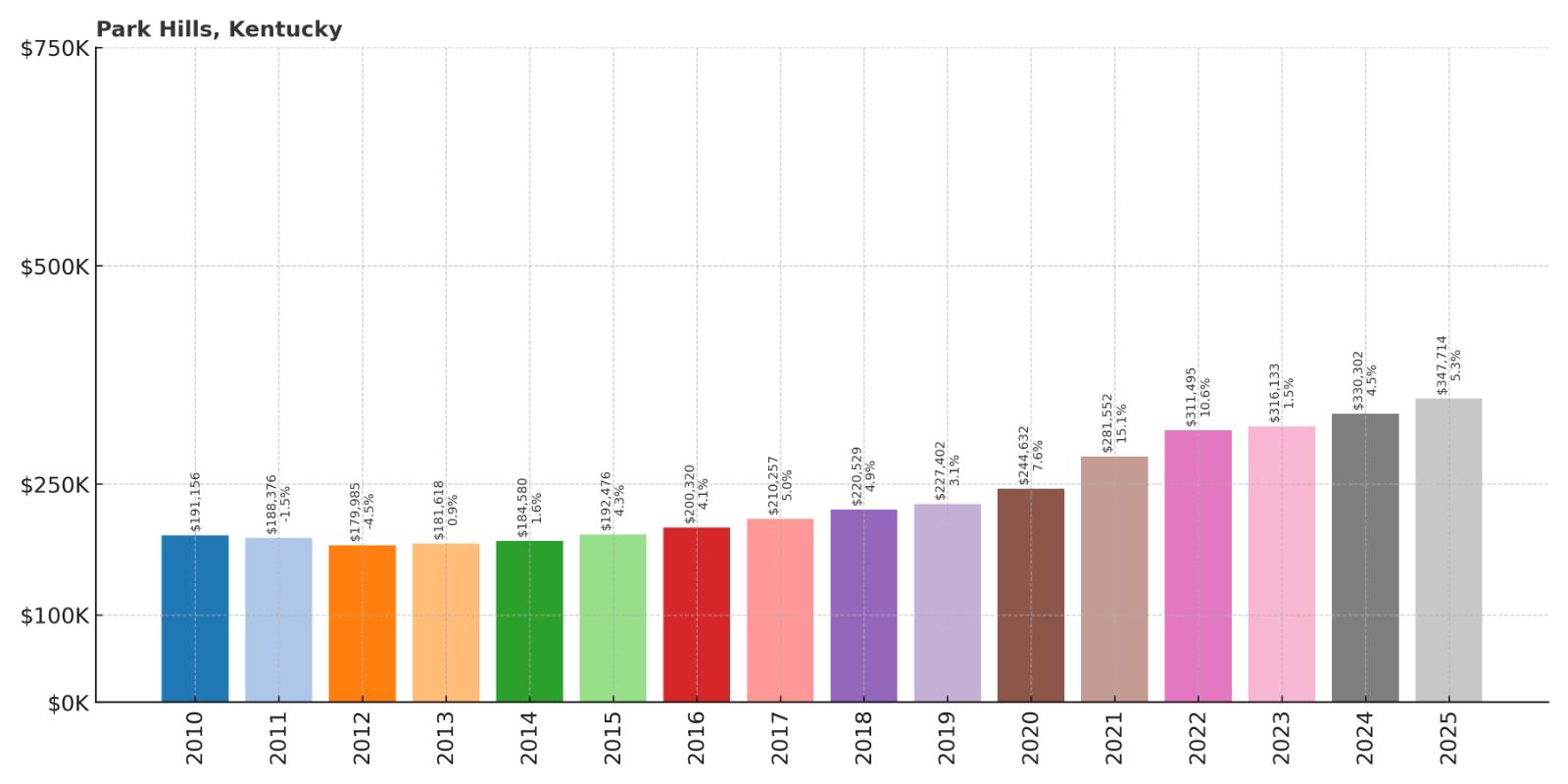
- 2010: $191,156
- 2011: $188,376
- 2012: $179,985
- 2013: $181,618
- 2014: $184,580
- 2015: $192,476
- 2016: $200,320
- 2017: $210,257
- 2018: $220,529
- 2019: $227,402
- 2020: $244,632
- 2021: $281,552
- 2022: $311,495
- 2023: $316,133
- 2024: $330,302
- 2025: $347,714
Park Hills has achieved solid appreciation with an 82% increase since 2010, recovering from early-decade weakness to reach current values of $347,714. The community showed impressive resilience with particularly strong momentum after 2020 when values jumped from $244,632 to current levels. This Northern Kentucky location continues attracting buyers seeking established suburban living with Cincinnati access.
Why Park Hills?
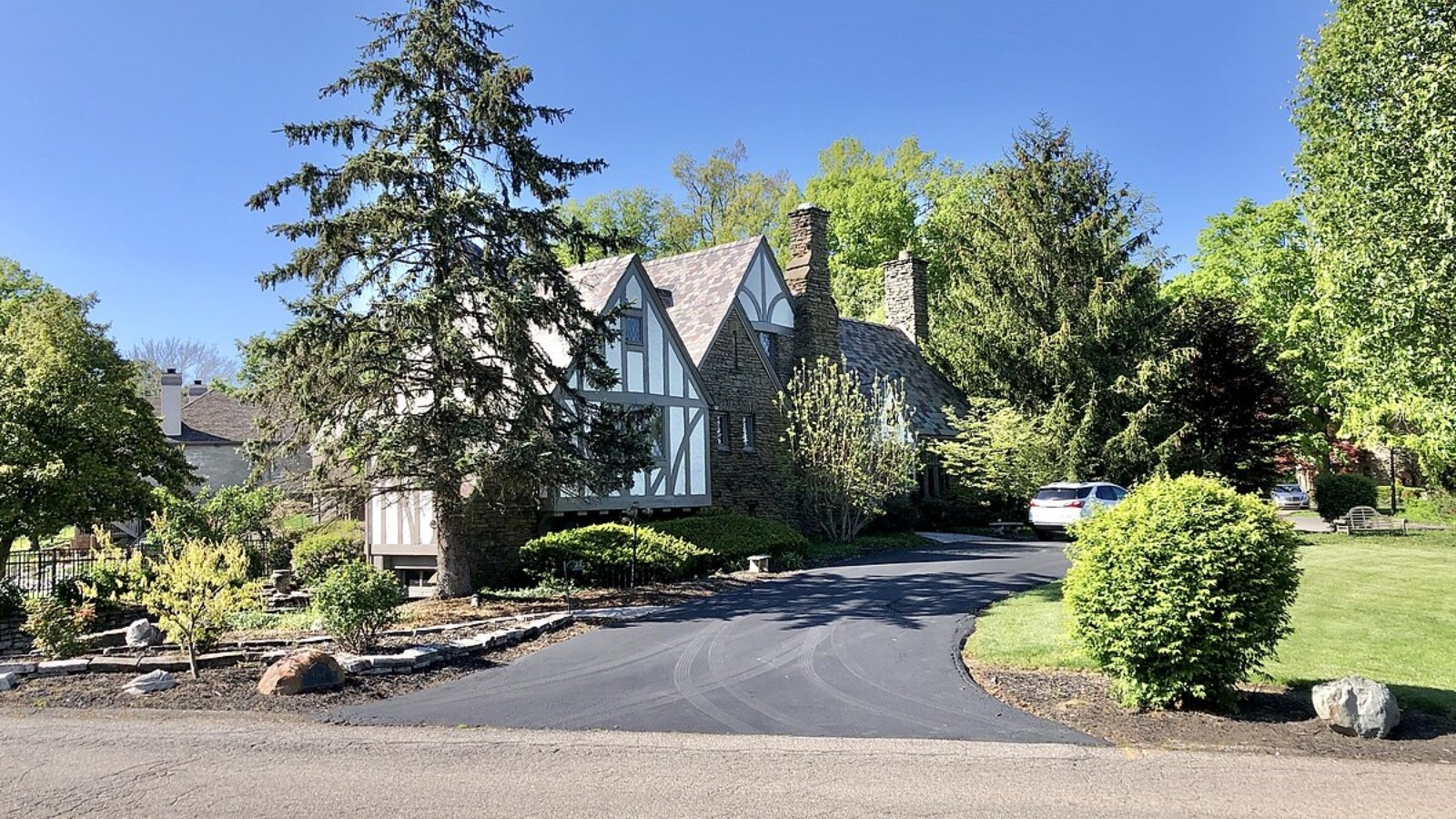
Why Are People Willing to Pay So Much to Live Here? What’s Special About It?
Park Hills offers an established suburban community with tree-lined streets, well-maintained homes, and excellent schools that attract families seeking stability and quality education. The area features mature neighborhoods with architectural character and larger lots than many newer developments. Residents appreciate the community’s central location providing easy access to Cincinnati employment and cultural opportunities.
The location provides suburban tranquility while maintaining convenient access to major highways and urban amenities. Park Hills’ established infrastructure and services create a comfortable living environment that supports long-term residents and property appreciation. The community’s commitment to maintaining neighborhood standards and green spaces enhances quality of life and property values.
How Park Hills Rose to Prominence
Incorporated in 1927, Park Hills developed as one of Northern Kentucky’s earliest planned suburban communities, designed to provide residential alternatives to urban Cincinnati living. The community attracted middle and upper-middle-class families seeking suburban homes with city convenience. Early development emphasized larger lots and quality construction standards that created lasting neighborhood character.
The post-World War II suburban boom brought significant growth to Park Hills as returning veterans and young families sought modern suburban living. The community successfully managed this growth while preserving its residential character through careful zoning and planning. The establishment of quality schools and the maintenance of parks and recreational facilities helped Park Hills maintain its appeal through multiple generations of residents.
3 Interesting Tidbits
1. Planned Community – Park Hills was one of Northern Kentucky’s first planned suburban developments, setting standards for community design and quality.
2. Educational Focus – The community has long been known for its commitment to quality education, with schools that consistently rank among the region’s best.
3. Green Spaces – Park Hills maintains numerous parks and green spaces that provide recreation opportunities and enhance the community’s residential character.
19. Smithfield – 112% Home Price Increase Since 2010
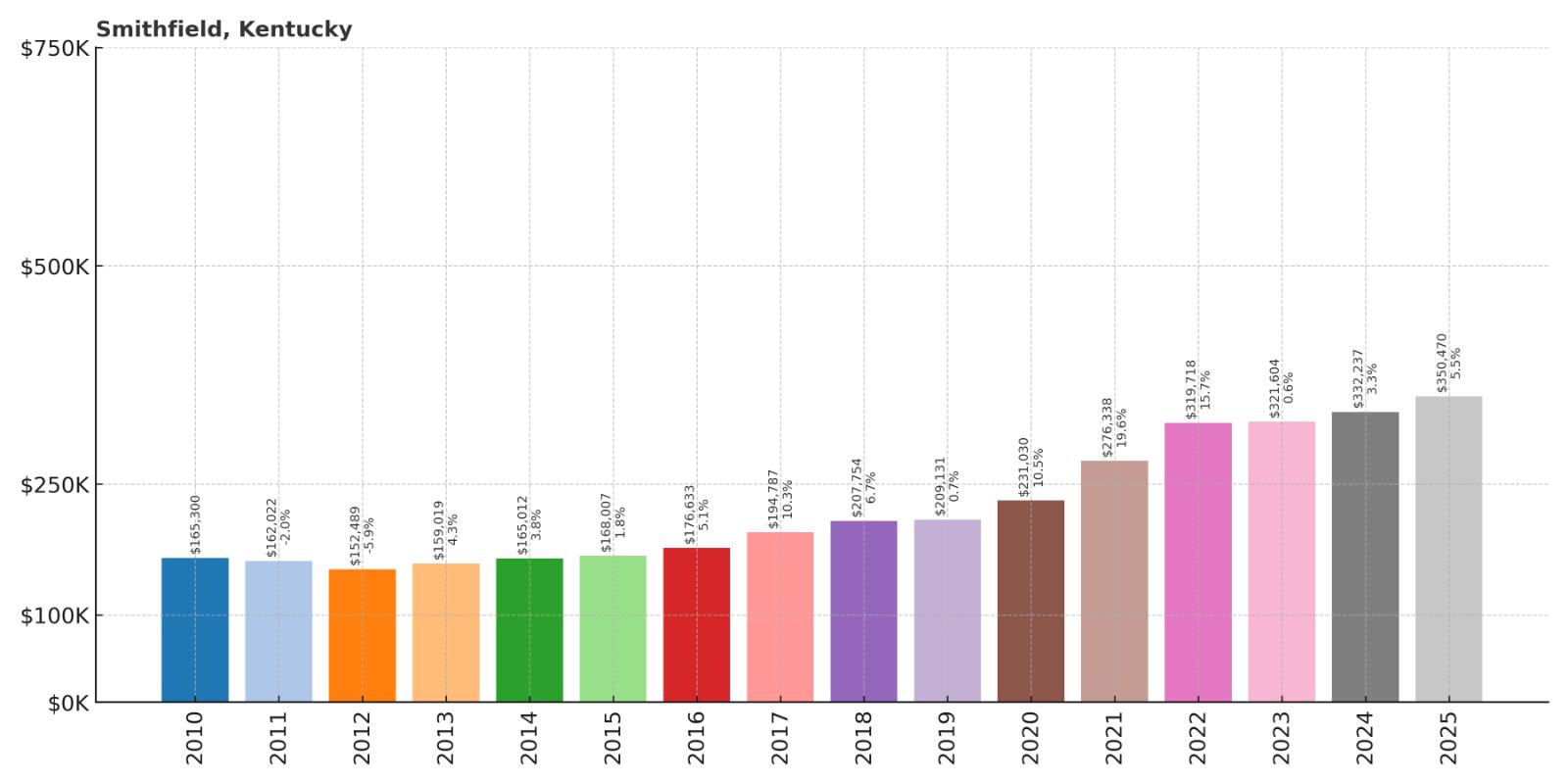
- 2010: $165,300
- 2011: $162,022
- 2012: $152,489
- 2013: $159,019
- 2014: $165,012
- 2015: $168,007
- 2016: $176,633
- 2017: $194,787
- 2018: $207,754
- 2019: $209,131
- 2020: $231,030
- 2021: $276,338
- 2022: $319,718
- 2023: $321,604
- 2024: $332,237
- 2025: $350,470
Smithfield has delivered explosive growth with a remarkable 112% increase since 2010, more than doubling from $165,300 to $350,470. After struggling through the early 2010s recession, the market found momentum after 2017 and accelerated dramatically during pandemic years. The 56% growth since 2020 represents one of Kentucky’s strongest recent appreciation rates.
Why Smithfield?

Why Are People Willing to Pay So Much to Live Here? What’s Special About It?
Smithfield offers rural charm and pastoral beauty in Henry County, appealing to buyers seeking country living with reasonable access to both Louisville and Cincinnati metropolitan areas. The community provides larger properties and agricultural opportunities while maintaining proximity to major employment centers. Residents enjoy the peaceful lifestyle and natural beauty of Kentucky’s countryside.
The area attracts those seeking to escape urban congestion without sacrificing career opportunities, as remote work options have made rural living more viable. Smithfield’s location approximately halfway between Louisville and Cincinnati provides flexibility for commuters to either city. The community’s agricultural heritage and scenic setting create a distinctive lifestyle that commands premium pricing from buyers seeking authentic rural experiences.
How Smithfield Rose to Prominence
Established in the early 1800s as a small farming community in Henry County, Smithfield remained primarily agricultural through most of its history. The town served local farmers and provided basic services to the surrounding rural area. Its location along transportation routes between Louisville and Cincinnati made it a natural stopping point for commerce and travel.
Recent decades have seen Smithfield benefit from suburbanization trends as buyers seek rural properties within reasonable commuting distance of urban employment. The community’s agricultural character and natural beauty attract those seeking country estates and hobby farms. The growth of remote work opportunities has further enhanced Smithfield’s appeal to professionals who can work from rural locations while accessing urban amenities when needed.
3 Interesting Tidbits
1. Agricultural Heritage – Smithfield remains an active agricultural community with working farms producing crops and livestock throughout Henry County.
2. Strategic Location – The community sits approximately halfway between Louisville and Cincinnati, providing access to two major metropolitan markets.
3. Rural Lifestyle – Many properties offer acreage and agricultural opportunities, appealing to buyers seeking country living and hobby farming.
18. Hebron – 85% Home Price Increase Since 2010
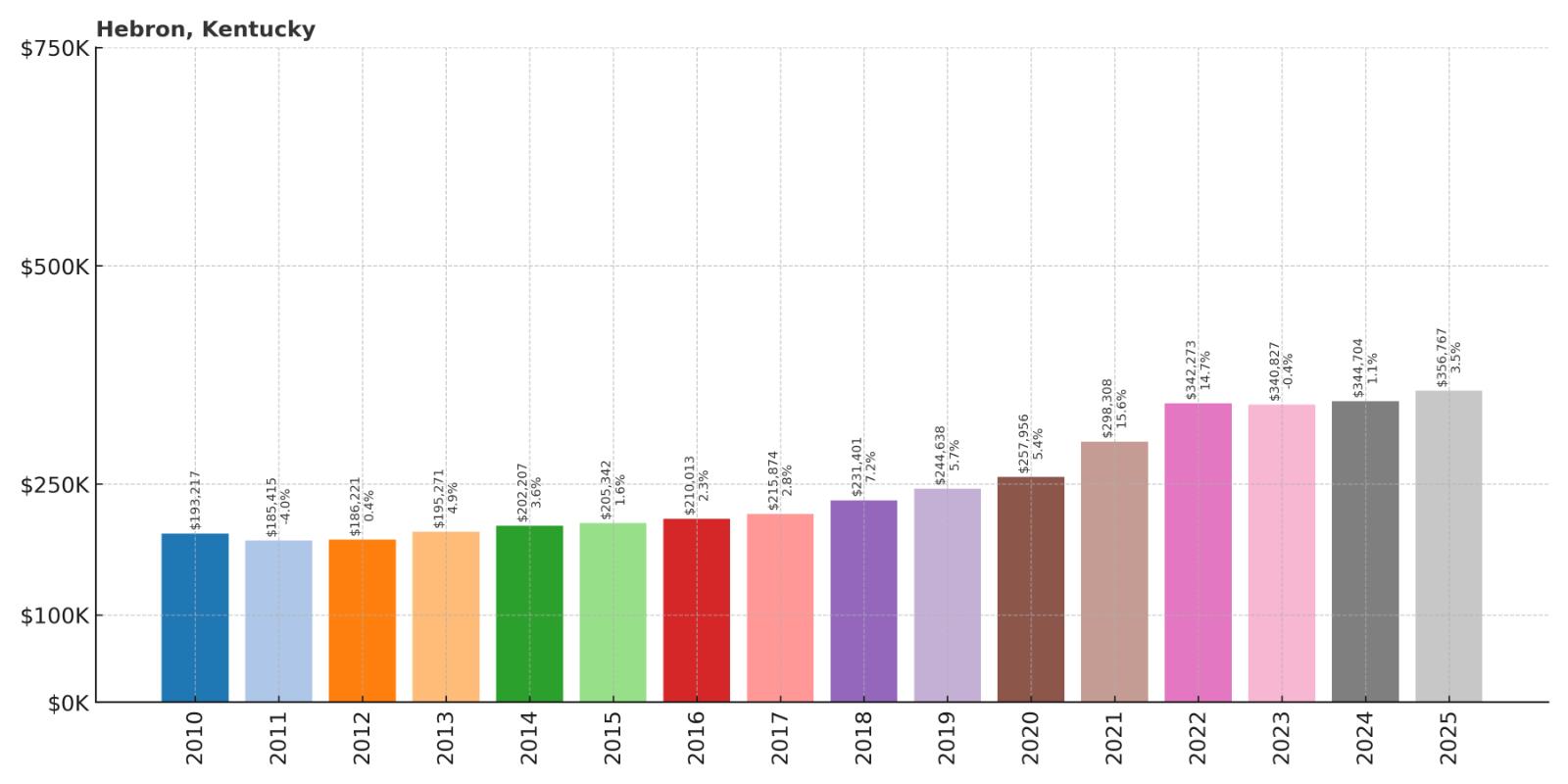
- 2010: $193,217
- 2011: $185,415
- 2012: $186,221
- 2013: $195,271
- 2014: $202,207
- 2015: $205,342
- 2016: $210,013
- 2017: $215,874
- 2018: $231,401
- 2019: $244,638
- 2020: $257,956
- 2021: $298,308
- 2022: $342,273
- 2023: $340,827
- 2024: $344,704
- 2025: $356,767
Hebron has achieved solid growth with an 85% increase since 2010, climbing steadily from $193,217 to current values of $356,767. The community showed consistent appreciation with acceleration during pandemic years when values jumped from $257,956 to over $340,000. This Boone County location benefits from its strategic position near major transportation infrastructure and employment centers.
Why Hebron?
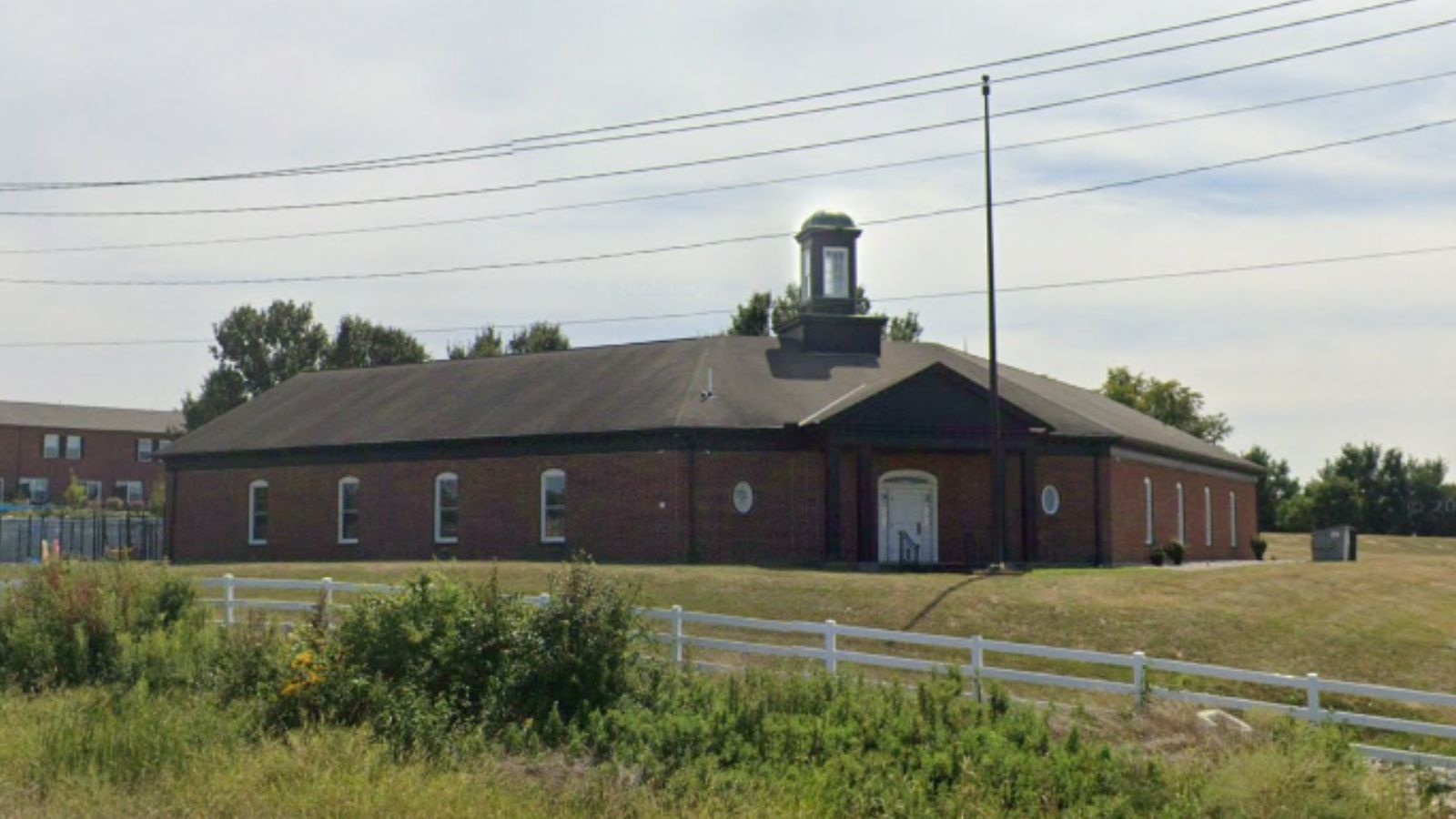
Why Are People Willing to Pay So Much to Live Here? What’s Special About It?
Hebron benefits from its prime location in Boone County near Cincinnati/Northern Kentucky International Airport, making it especially desirable for frequent travelers and airport employees. The community offers newer housing developments with larger lots than many similarly-priced areas, appealing to families seeking space within the Cincinnati metropolitan region. Residents enjoy modern amenities while maintaining access to employment centers.
The area provides excellent value for buyers seeking new construction and modern infrastructure while staying within reasonable commuting distance of Cincinnati. Hebron’s rapid development has included quality schools, shopping centers, and recreational facilities that support family living. The community’s growth has been managed to maintain suburban character while providing urban conveniences.
How Hebron Rose to Prominence
Originally a small farming community in Boone County, Hebron remained largely rural until the development of Cincinnati/Northern Kentucky International Airport transformed the area’s economic prospects. The airport’s construction brought significant employment opportunities and attracted related businesses and services. This infrastructure development triggered residential and commercial growth throughout the surrounding area.
Strategic planning during the 1990s and 2000s helped Hebron manage rapid population growth while maintaining community character. The development of family-oriented subdivisions, the expansion of schools, and the addition of retail centers created a comprehensive suburban environment. The community’s proximity to major transportation infrastructure and employment centers has sustained strong demand from homebuyers seeking modern suburban living.
3 Interesting Tidbits
1. Airport Hub – Hebron sits adjacent to Cincinnati/Northern Kentucky International Airport, one of the region’s major economic drivers and transportation hubs.
2. Rapid Growth – The community has experienced dramatic population growth, transforming from rural farmland to suburban development in just a few decades.
3. Modern Infrastructure – Hebron features new schools, roads, and utilities designed to support continued growth while maintaining high service standards.
17. Edgewood – 81% Home Price Increase Since 2010
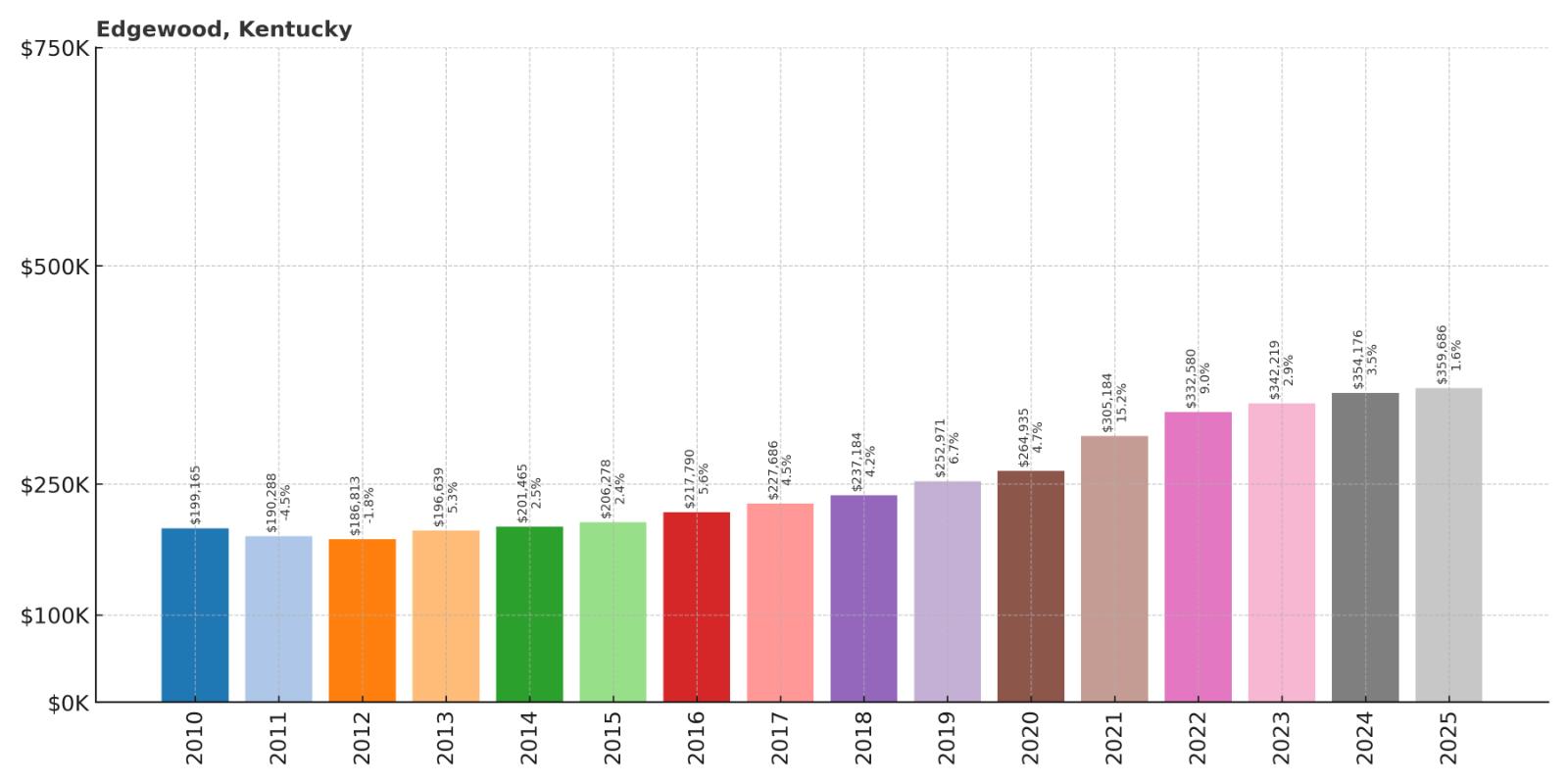
- 2010: $199,165
- 2011: $190,288
- 2012: $186,813
- 2013: $196,639
- 2014: $201,465
- 2015: $206,278
- 2016: $217,790
- 2017: $227,686
- 2018: $237,184
- 2019: $252,971
- 2020: $264,935
- 2021: $305,184
- 2022: $332,580
- 2023: $342,219
- 2024: $354,176
- 2025: $359,686
Edgewood has shown steady appreciation with an 81% increase since 2010, recovering from early-decade declines to reach $359,686 in current values. The community demonstrated consistent growth momentum after 2015, with particularly strong gains during 2021 when values jumped over $40,000. This established Northern Kentucky suburb continues attracting buyers seeking quality suburban living with Cincinnati access.
Why Edgewood?
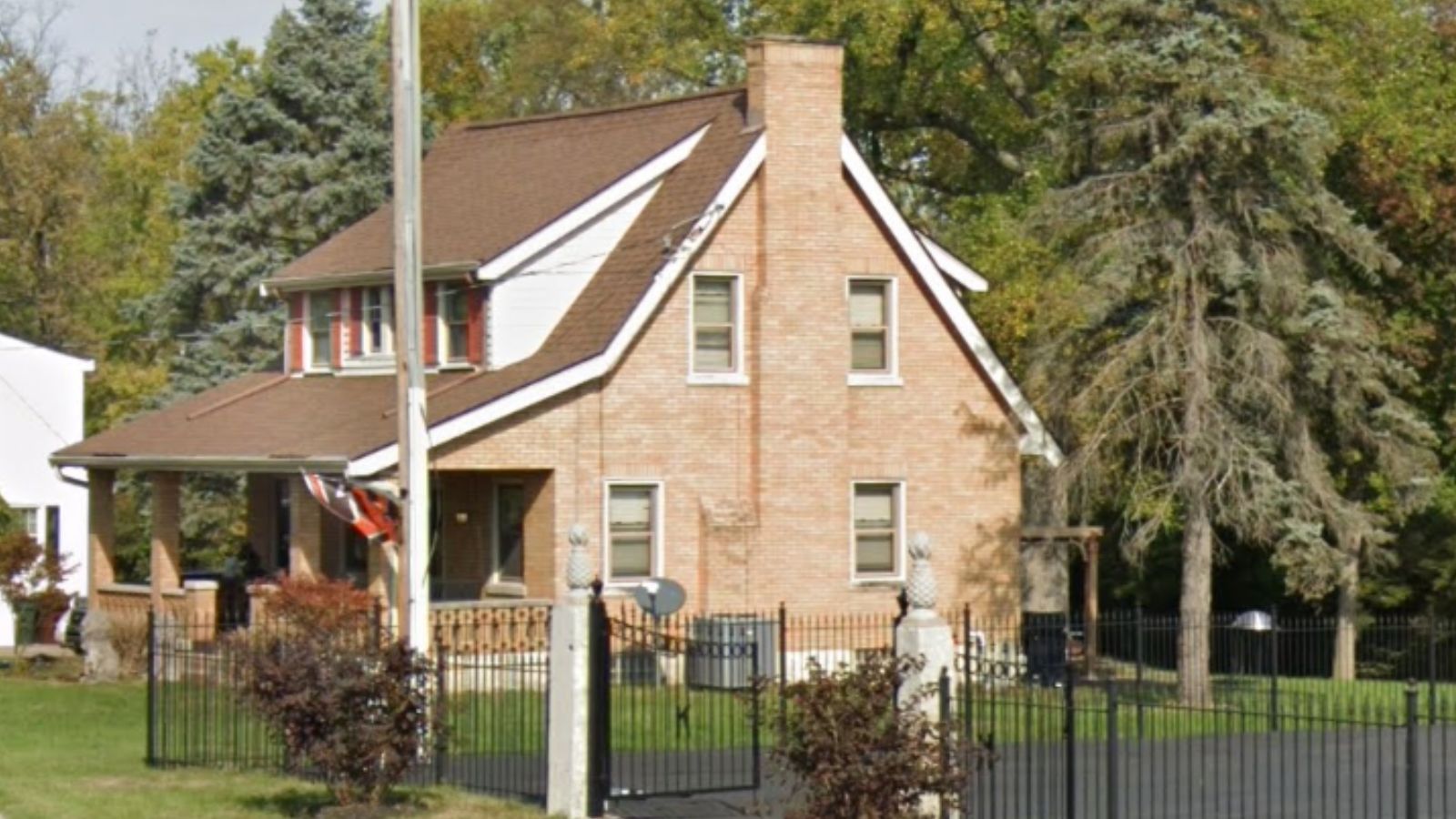
Why Are People Willing to Pay So Much to Live Here? What’s Special About It?
Edgewood offers an established suburban community with excellent schools, well-maintained neighborhoods, and convenient access to Cincinnati employment centers. The area features mature trees, quality homes, and recreational facilities that create an attractive living environment. Families are drawn to the community’s stability, safety, and commitment to maintaining high neighborhood standards.
The location provides suburban tranquility while ensuring easy access to urban amenities and job opportunities. Edgewood’s established infrastructure and services support long-term residents seeking community stability and property appreciation. The area’s combination of residential character and strategic location maintains strong appeal to homebuyers across various life stages.
How Edgewood Rose to Prominence
Incorporated in 1962, Edgewood developed as part of Cincinnati’s suburban expansion into Northern Kentucky during the post-World War II housing boom. The community attracted middle-class families seeking suburban homes with access to Cincinnati employment and cultural opportunities. Early development emphasized single-family neighborhoods with quality construction standards.
The completion of regional highway systems enhanced Edgewood’s accessibility while the community maintained its suburban character through careful planning and zoning. The establishment of quality schools and recreational facilities helped attract and retain families through multiple generations. Strategic infrastructure investments have maintained the community’s appeal while supporting continued residential demand.
3 Interesting Tidbits
1. Suburban Pioneer – Edgewood was among the early planned suburban communities in Northern Kentucky, establishing development patterns for the region.
2. Family Focus – The community has consistently emphasized family-oriented amenities including parks, schools, and recreational programs.
3. Strategic Access – Edgewood’s location provides convenient access to multiple highways, making commuting to various employment centers manageable.
16. Pewee Valley – 96% Home Price Increase Since 2010
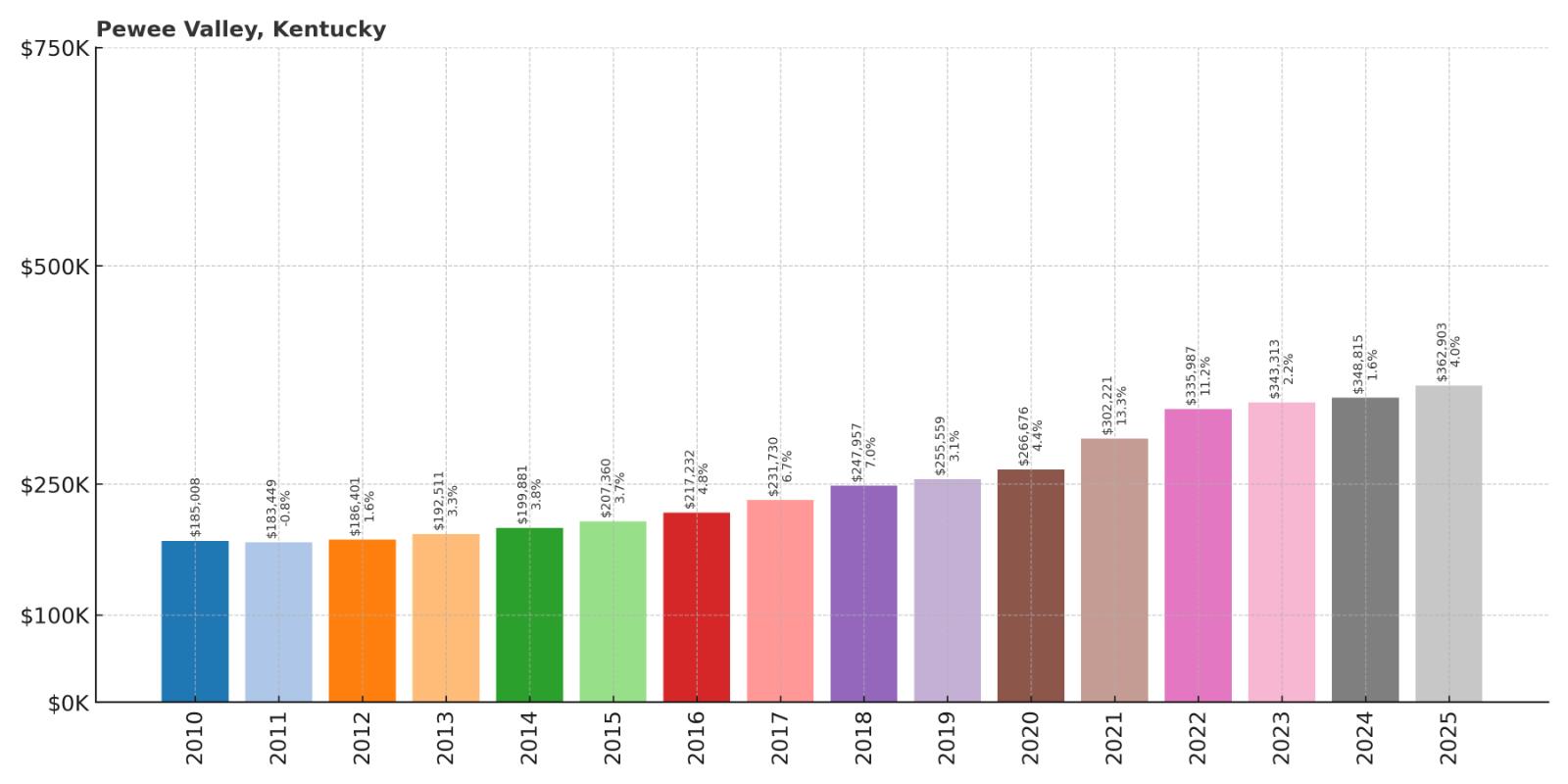
- 2010: $185,008
- 2011: $183,449
- 2012: $186,401
- 2013: $192,511
- 2014: $199,881
- 2015: $207,360
- 2016: $217,232
- 2017: $231,730
- 2018: $247,957
- 2019: $255,559
- 2020: $266,676
- 2021: $302,221
- 2022: $335,987
- 2023: $343,313
- 2024: $348,815
- 2025: $362,903
Pewee Valley has nearly doubled in value with an impressive 96% increase since 2010, climbing from $185,008 to $362,903. The community showed remarkable consistency with steady appreciation throughout the period and significant acceleration during 2021-2022. This historic Oldham County community represents one of Kentucky’s most successful appreciation stories outside metro Louisville.
Why Pewee Valley?
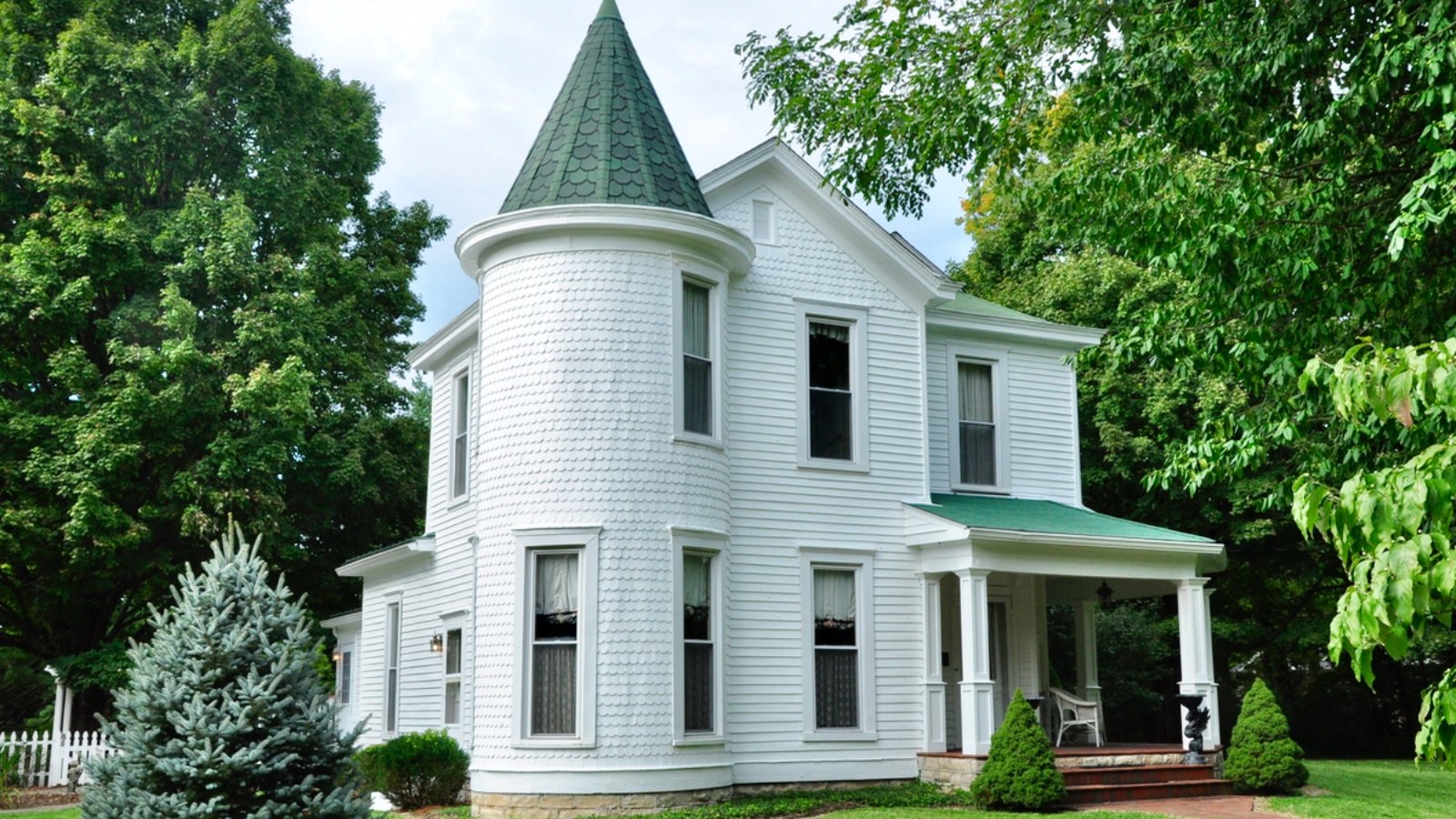
Why Are People Willing to Pay So Much to Live Here? What’s Special About It?
Pewee Valley offers Victorian-era charm and small-town character just 20 minutes from Louisville, creating a unique blend of historic ambiance and modern convenience. The community features tree-lined streets, historic homes, and cultural significance as the setting for the famous “Little Colonel” books. Residents enjoy the peaceful atmosphere while maintaining easy access to Louisville’s employment and cultural opportunities.
The area provides a distinctive lifestyle centered around historic preservation and community traditions. Many properties feature architectural character and mature landscaping that create an exceptional residential environment. Pewee Valley’s location in prestigious Oldham County adds to its appeal among buyers seeking authentic character combined with suburban amenities and urban access.
How Pewee Valley Rose to Prominence
Founded in the 1850s as a railroad suburb of Louisville, Pewee Valley became known for its Victorian architecture and genteel lifestyle. The community attracted affluent Louisville residents seeking country estates within commuting distance of the city. The famous “Little Colonel” books by Annie Fellows Johnston, set in Pewee Valley, brought national attention to the community’s charm and character.
The 20th century saw Pewee Valley successfully preserve its historic character while adapting to modern suburban living. The community’s commitment to historic preservation and architectural standards maintained its distinctive appeal through various economic cycles. Recent decades have seen renewed appreciation for Pewee Valley’s authentic character and convenient Louisville access, driving strong demand and property appreciation.
3 Interesting Tidbits
1. Literary Fame – Pewee Valley was immortalized in the “Little Colonel” books, which brought national attention to the community’s Southern charm.
2. Victorian Heritage – The community features numerous well-preserved Victorian homes and buildings that create a distinctive architectural character.
3. Railroad History – Pewee Valley developed as one of Kentucky’s first railroad suburbs, establishing patterns of suburban living that preceded automobile-based development.
15. Taylorsville – 111% Home Price Increase Since 2010

- 2010: $172,709
- 2011: $161,207
- 2012: $166,124
- 2013: $173,553
- 2014: $181,471
- 2015: $190,686
- 2016: $205,881
- 2017: $219,689
- 2018: $231,922
- 2019: $245,456
- 2020: $256,205
- 2021: $302,786
- 2022: $335,858
- 2023: $339,757
- 2024: $348,081
- 2025: $363,962
Taylorsville has achieved remarkable growth with a 111% increase since 2010, more than doubling from $172,709 to $363,962. After a challenging start in 2011, the community showed consistent momentum with acceleration during pandemic years when values jumped from $256,205 to current levels. This Spencer County seat demonstrates the appreciation potential in Kentucky’s smaller communities.
Why Taylorsville?
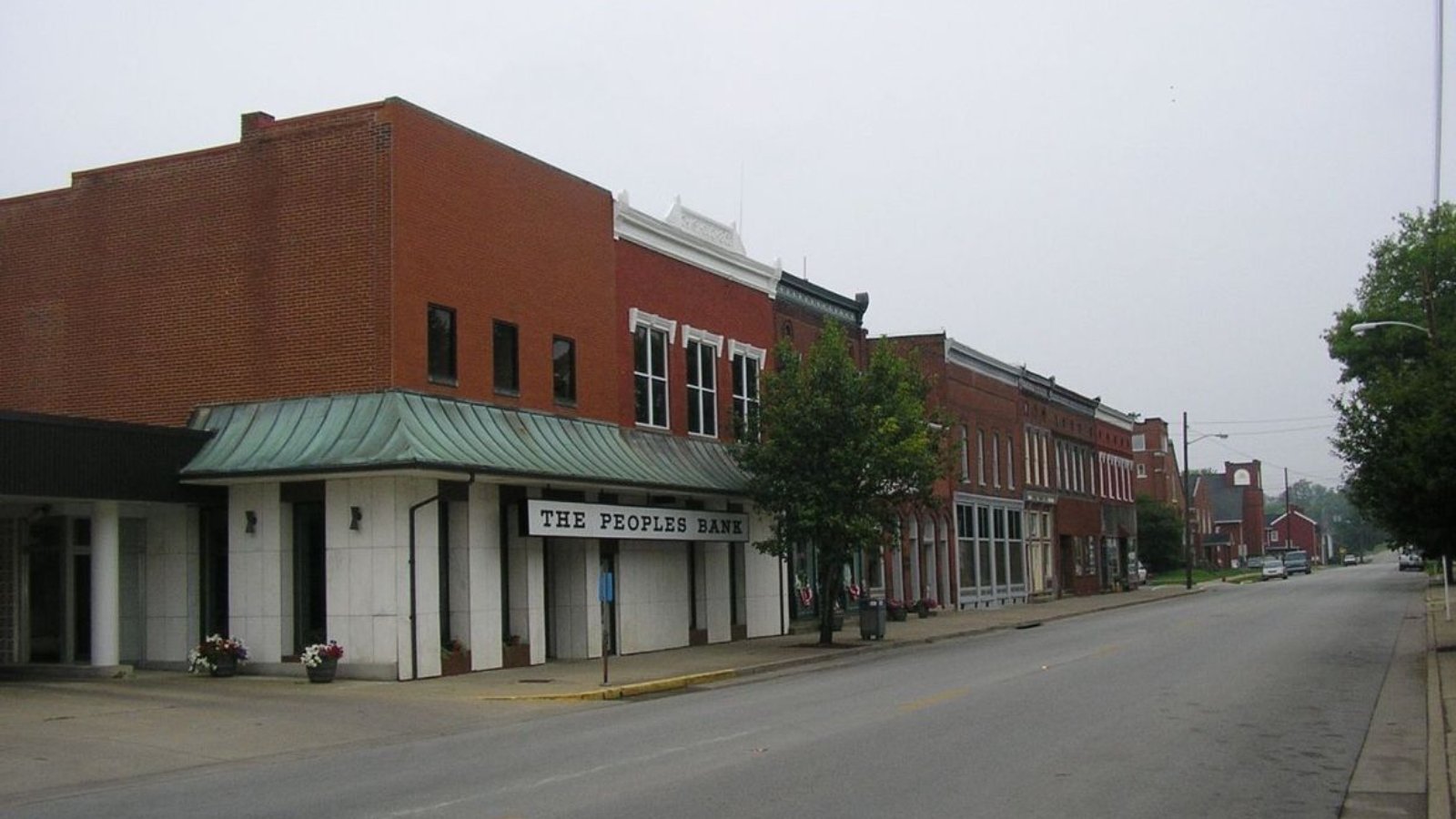
Why Are People Willing to Pay So Much to Live Here? What’s Special About It?
Taylorsville offers small-town charm as the county seat of Spencer County, providing government services and community amenities while maintaining rural character. The area features Taylorsville Lake State Park, offering recreational opportunities including boating, fishing, and camping that enhance quality of life. Residents enjoy affordable living costs compared to urban areas while maintaining access to Louisville employment markets.
The community provides a peaceful lifestyle with natural beauty and outdoor recreation opportunities that appeal to families and retirees seeking affordable alternatives to urban living. Taylorsville’s location allows residents to enjoy small-town benefits while staying within reasonable commuting distance of Louisville. The area’s growth reflects broader trends toward rural and small-town living accelerated by remote work opportunities.
How Taylorsville Rose to Prominence
Established as the county seat of Spencer County in 1829, Taylorsville served as a regional center for government services and commerce. The community’s location along the Salt River made it a natural hub for transportation and trade in the region. Agricultural prosperity in surrounding Spencer County supported the town’s growth and development.
The construction of Taylorsville Lake in the 1980s transformed the area’s recreational and tourism prospects, attracting visitors and new residents seeking lake access and outdoor recreation. The lake development brought infrastructure improvements and economic diversification that enhanced the community’s appeal. Recent decades have seen Taylorsville benefit from suburban spillover as buyers seek affordable alternatives to urban housing markets.
3 Interesting Tidbits
1. Lake Recreation – Taylorsville Lake offers 3,050 acres of water for boating, fishing, and water sports, making it a popular recreational destination.
2. County Seat – As Spencer County’s government center, Taylorsville provides stability and employment through public sector jobs and services.
3. Natural Beauty – The surrounding countryside features rolling hills, forests, and agricultural land that create an attractive rural setting.
14. Fox Chase – 100% Home Price Increase Since 2013
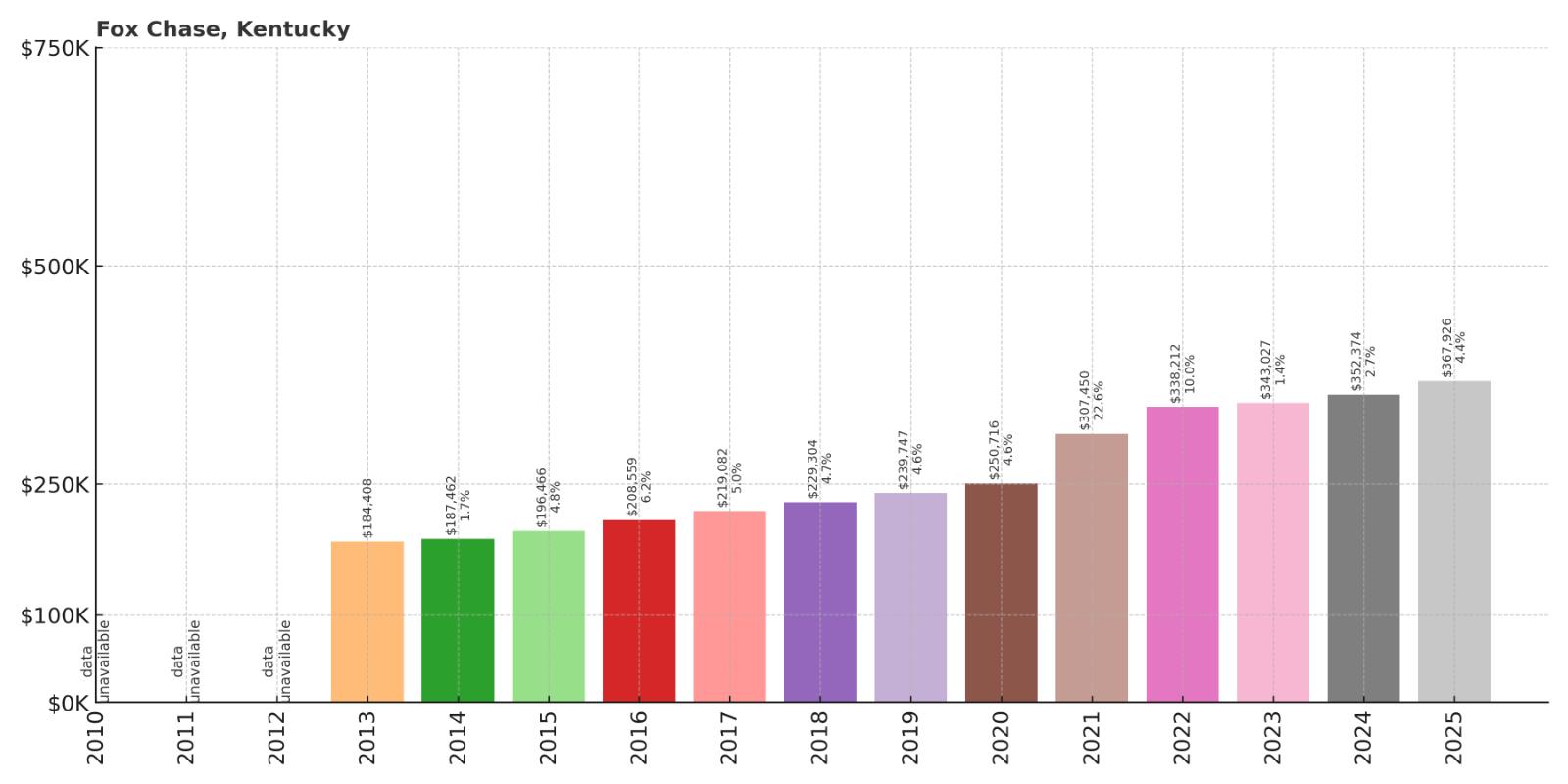
- 2010: N/A
- 2011: N/A
- 2012: N/A
- 2013: $184,408
- 2014: $187,462
- 2015: $196,466
- 2016: $208,559
- 2017: $219,082
- 2018: $229,304
- 2019: $239,747
- 2020: $250,716
- 2021: $307,450
- 2022: $338,212
- 2023: $343,027
- 2024: $352,374
- 2025: $367,926
Fox Chase has exactly doubled in value since data became available in 2013, climbing from $184,408 to $367,926. The community showed consistent appreciation with significant acceleration during 2021 when values jumped over $56,000 in one year. This newer development represents successful suburban growth in Kentucky’s expanding housing market.
Why Fox Chase?
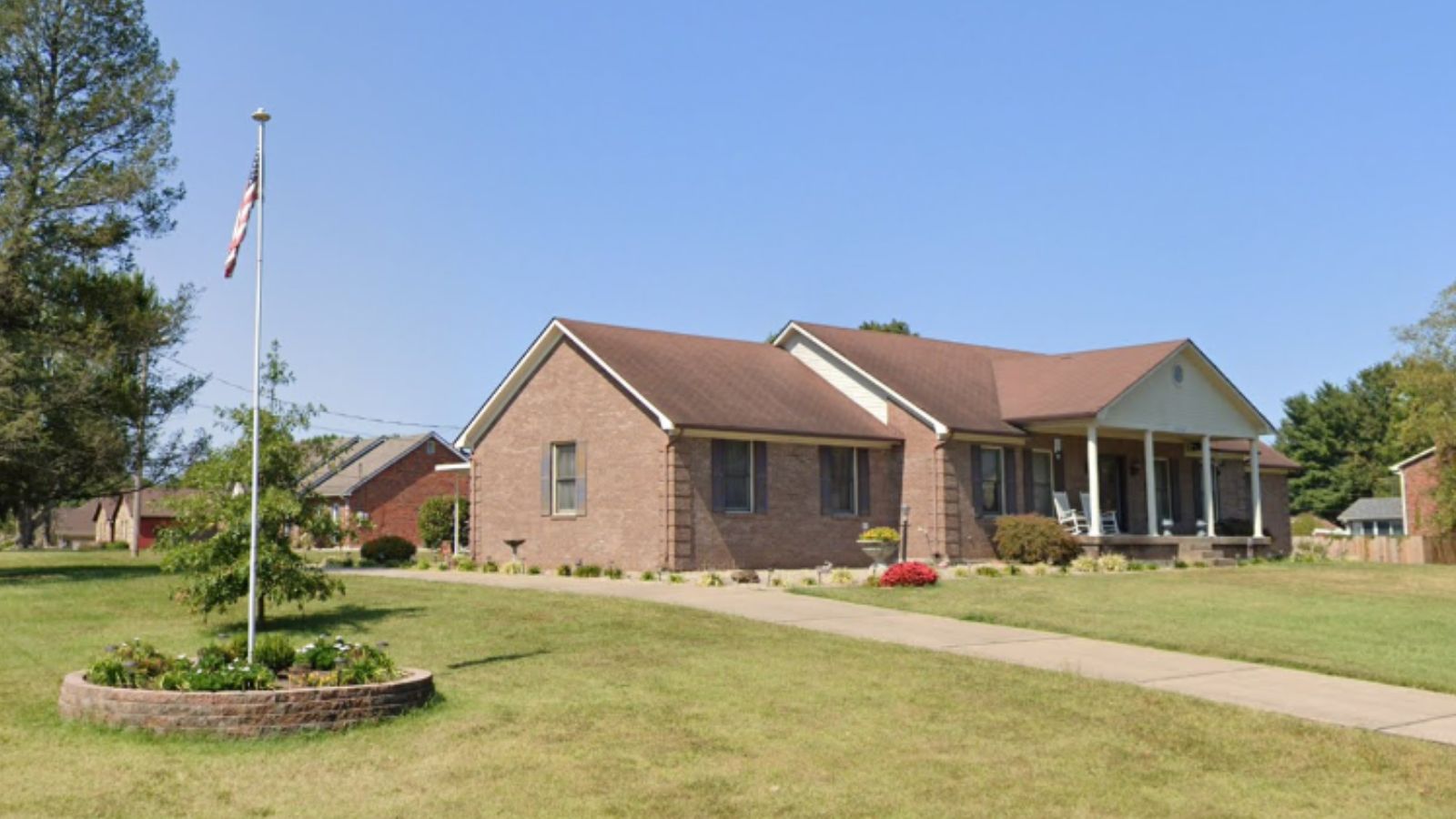
Why Are People Willing to Pay So Much to Live Here? What’s Special About It?
Fox Chase represents newer suburban development with modern homes, planned communities, and contemporary amenities that appeal to today’s homebuyers. The area offers family-friendly neighborhoods with quality construction, larger lots, and access to recreational facilities. Residents appreciate the newer infrastructure and services designed to support growing families and modern lifestyles.
The community provides suburban convenience with access to employment centers and urban amenities while maintaining a residential atmosphere. Fox Chase’s planned development includes parks, walking trails, and community facilities that enhance quality of life. The area’s growth reflects demand for newer housing options that offer modern features and energy efficiency.
How Fox Chase Rose to Prominence
Fox Chase emerged as part of Kentucky’s suburban expansion during the 2000s and 2010s, representing planned residential development designed to meet growing housing demand. The community was developed with modern planning principles emphasizing quality construction, community amenities, and environmental sensitivity. Strategic location and access to employment centers attracted homebuyers seeking contemporary suburban living.
The development incorporated lessons learned from earlier suburban communities, including emphasis on green space, walkability, and community amenities. Fox Chase’s success reflects broader trends toward planned communities that provide comprehensive residential environments. The community’s growth has been supported by quality schools, recreational facilities, and services that attract and retain residents.
3 Interesting Tidbits
1. Modern Planning – Fox Chase represents contemporary suburban design with emphasis on community amenities and environmental sustainability.
2. Family Focus – The development includes parks, playgrounds, and recreational facilities designed to support active family lifestyles.
3. Quality Construction – Newer homes in Fox Chase feature modern building standards, energy efficiency, and contemporary design elements.
13. Villa Hills – 80% Home Price Increase Since 2010
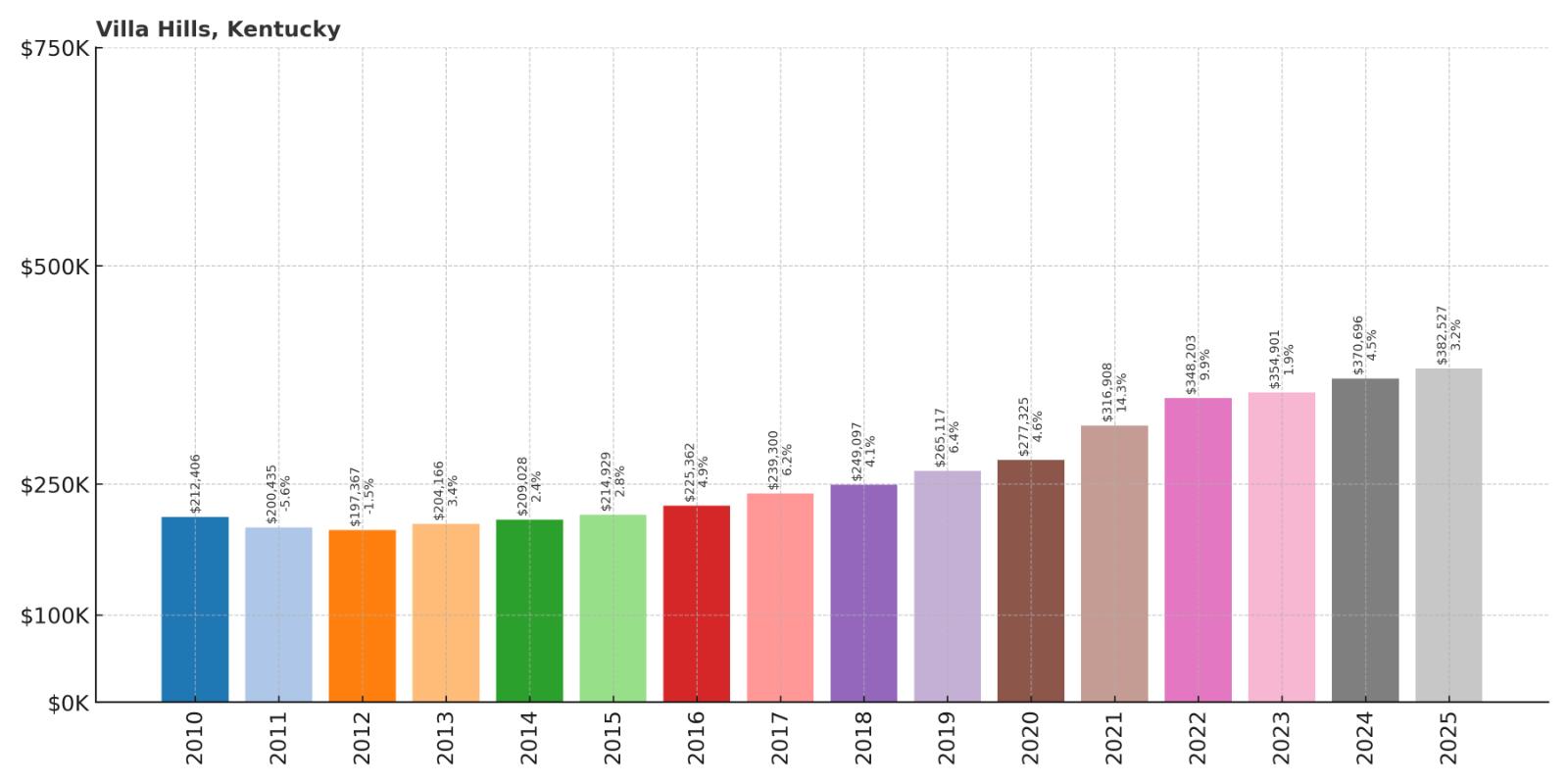
- 2010: $212,406
- 2011: $200,435
- 2012: $197,367
- 2013: $204,166
- 2014: $209,028
- 2015: $214,929
- 2016: $225,362
- 2017: $239,300
- 2018: $249,097
- 2019: $265,117
- 2020: $277,325
- 2021: $316,908
- 2022: $348,203
- 2023: $354,901
- 2024: $370,696
- 2025: $382,527
Villa Hills has achieved solid growth with an 80% increase since 2010, climbing from $212,406 to $382,527. After recovering from early-decade weakness, the community showed consistent appreciation with strong acceleration during pandemic years. Current values reflect Villa Hills’ position as an established Northern Kentucky suburb with excellent access to Cincinnati employment and amenities.
Why Villa Hills?
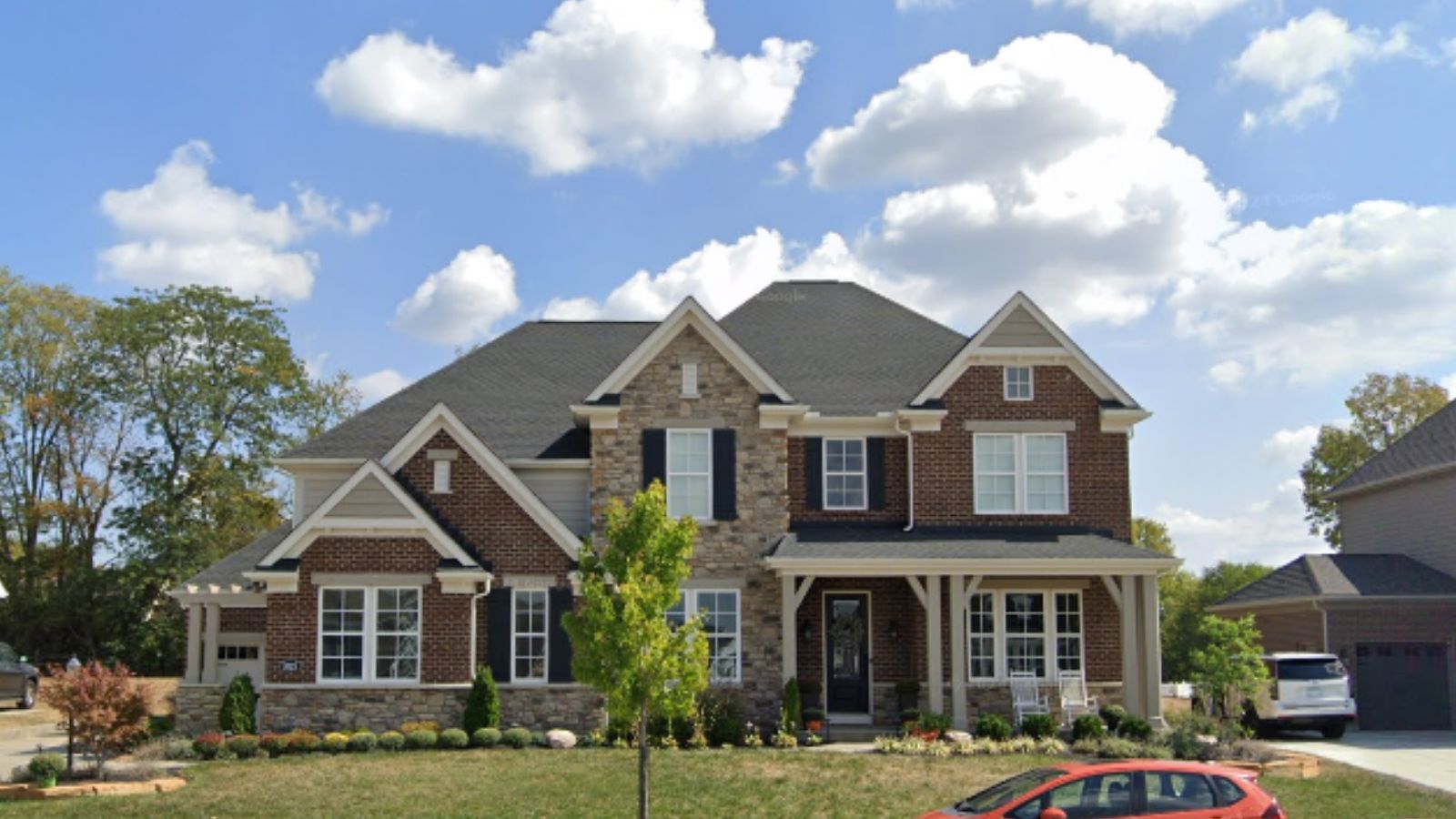
Why Are People Willing to Pay So Much to Live Here? What’s Special About It?
Villa Hills offers upscale suburban living with scenic rolling hills, mature neighborhoods, and excellent schools that attract affluent families. The community features quality construction, larger lots, and well-maintained properties that create an attractive residential environment. Residents enjoy easy access to Cincinnati while living in a peaceful suburban setting with strong community amenities.
The area provides premium suburban living with emphasis on quality of life, including parks, recreational facilities, and community programs. Villa Hills’ established character and strategic location maintain strong appeal among buyers seeking upscale suburban alternatives to urban living. The community’s commitment to maintaining high standards enhances property values and resident satisfaction.
How Villa Hills Rose to Prominence
Incorporated in 1962, Villa Hills developed as an upscale suburban community designed to attract affluent residents seeking quality suburban living near Cincinnati. The community’s hilly terrain and wooded lots created natural advantages that developers utilized to create distinctive residential neighborhoods. Early development emphasized quality construction and larger lots that established the community’s upscale character.
The completion of regional transportation infrastructure enhanced Villa Hills’ accessibility while the community maintained its residential character through careful zoning and planning. The establishment of quality schools and recreational facilities attracted families and supported long-term residential stability. The community’s success reflects strategic development that balanced growth with preservation of neighborhood character.
3 Interesting Tidbits
1. Scenic Topography – Villa Hills’ name reflects its distinctive rolling terrain that creates scenic neighborhoods and natural privacy between properties.
2. Quality Schools – The community is served by highly rated schools that consistently attract families seeking educational excellence for their children.
3. Community Amenities – Villa Hills features parks, recreational facilities, and community programs that enhance quality of life and foster neighborhood connections.
12. La Grange – 95% Home Price Increase Since 2010
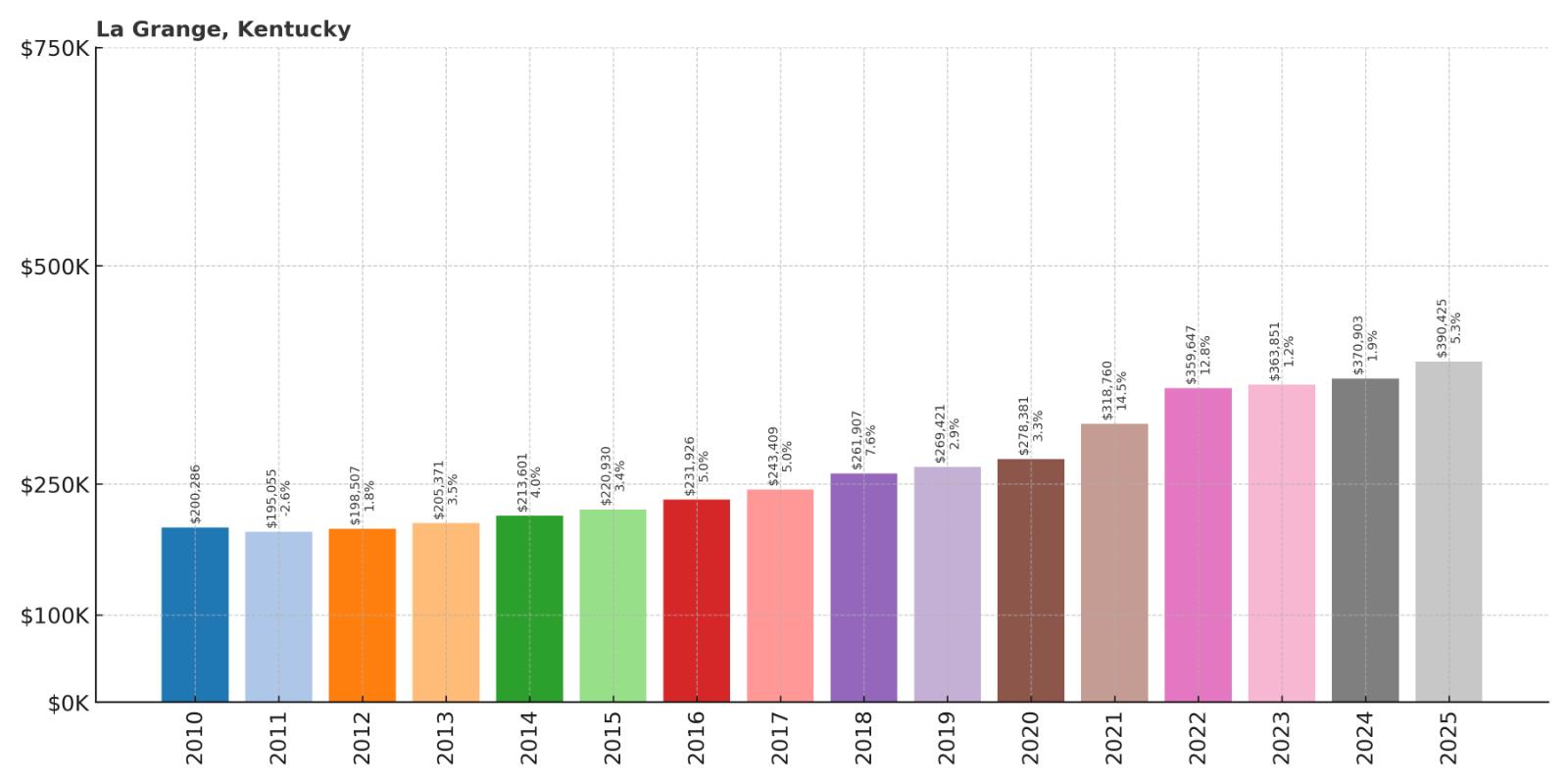
- 2010: $200,286
- 2011: $195,055
- 2012: $198,507
- 2013: $205,371
- 2014: $213,601
- 2015: $220,930
- 2016: $231,926
- 2017: $243,409
- 2018: $261,907
- 2019: $269,421
- 2020: $278,381
- 2021: $318,760
- 2022: $359,647
- 2023: $363,851
- 2024: $370,903
- 2025: $390,425
La Grange has achieved impressive growth with a 95% increase since 2010, climbing from $200,286 to $390,425. The community showed consistent appreciation with dramatic acceleration during pandemic years when values jumped from $278,381 to current levels. This historic Oldham County seat represents one of Kentucky’s most successful small-town markets.
Why La Grange?
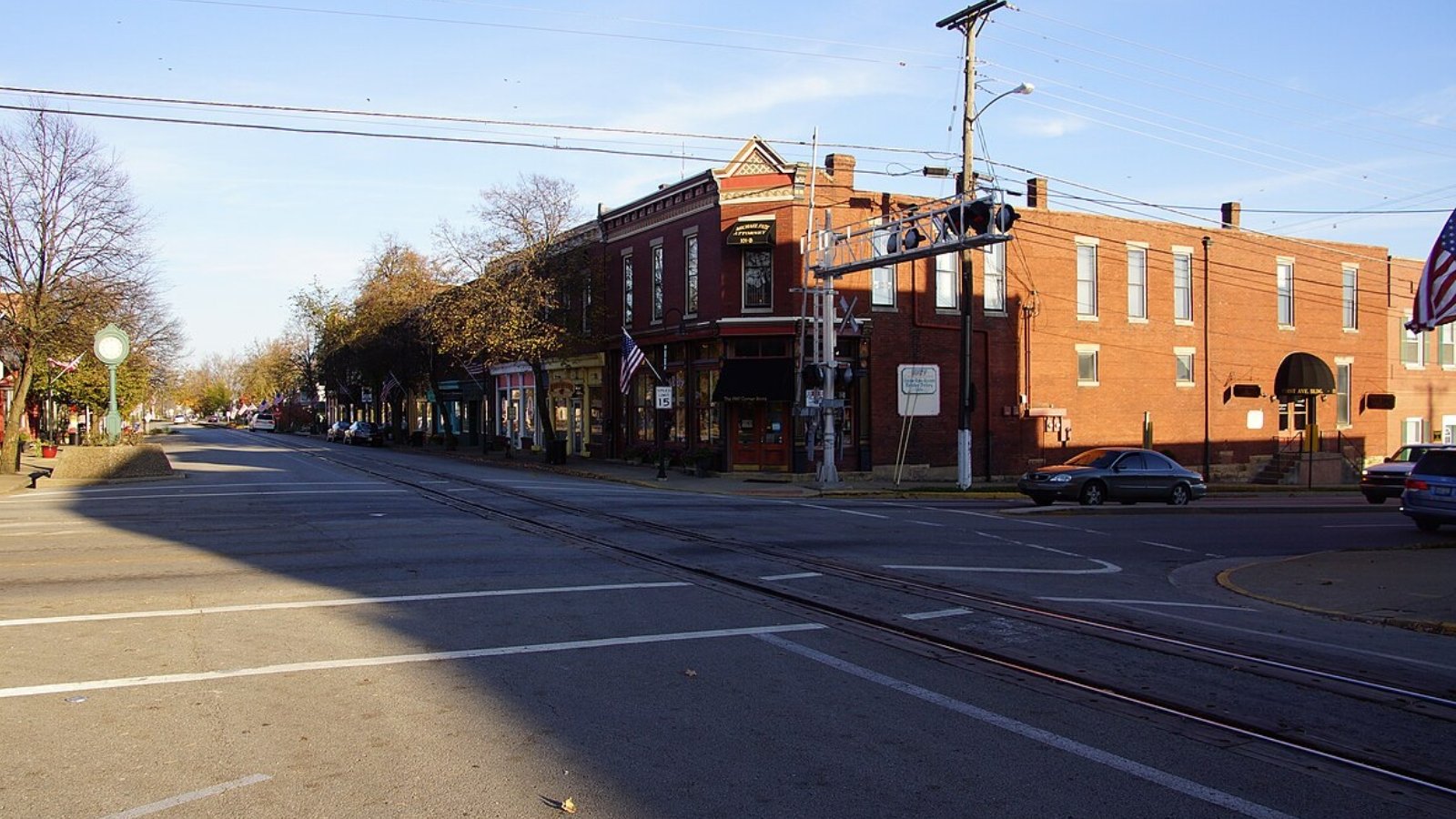
Why Are People Willing to Pay So Much to Live Here? What’s Special About It?
La Grange offers unique charm as a historic county seat where trains still roll down Main Street, creating an authentic small-town experience just 25 miles from Louisville. The community features a vibrant downtown with local shops, restaurants, and cultural events that foster strong community connections. Residents enjoy small-town living with access to Louisville’s employment and cultural opportunities.
The area provides excellent schools, safe neighborhoods, and a lifestyle centered around community traditions and historic preservation. La Grange’s careful balance of development and historic character creates a distinctive environment that appeals to buyers seeking alternatives to suburban sprawl. The community’s location in prestigious Oldham County adds to its desirability among affluent homebuyers.
How La Grange Rose to Prominence
Founded in 1827 and named after the Marquis de Lafayette’s estate, La Grange became the seat of Oldham County and a transportation hub along the Louisville-Lexington railroad. The unique feature of trains running directly through downtown Main Street made La Grange famous and created a distinctive community identity. The town prospered as a shipping point for local agricultural products and a government center.
The 20th century saw La Grange evolve from a rural county seat into an affluent suburban community while preserving its historic downtown and railroad heritage. The community’s proximity to Louisville attracted residents seeking small-town character with urban access. Recent decades have brought careful development that maintains La Grange’s authentic character while adding modern amenities and services.
3 Interesting Tidbits
1. Railroad Main Street – La Grange is one of the few communities where active trains still run directly down the main street, creating a unique and famous sight.
2. Historic Downtown – The community features a well-preserved downtown district with 19th-century architecture and local businesses that maintain small-town character.
3. County Seat Heritage – As Oldham County’s seat, La Grange provides government services and maintains historic courthouse facilities dating to the 1800s.
11. Fort Mitchell – 83% Home Price Increase Since 2010
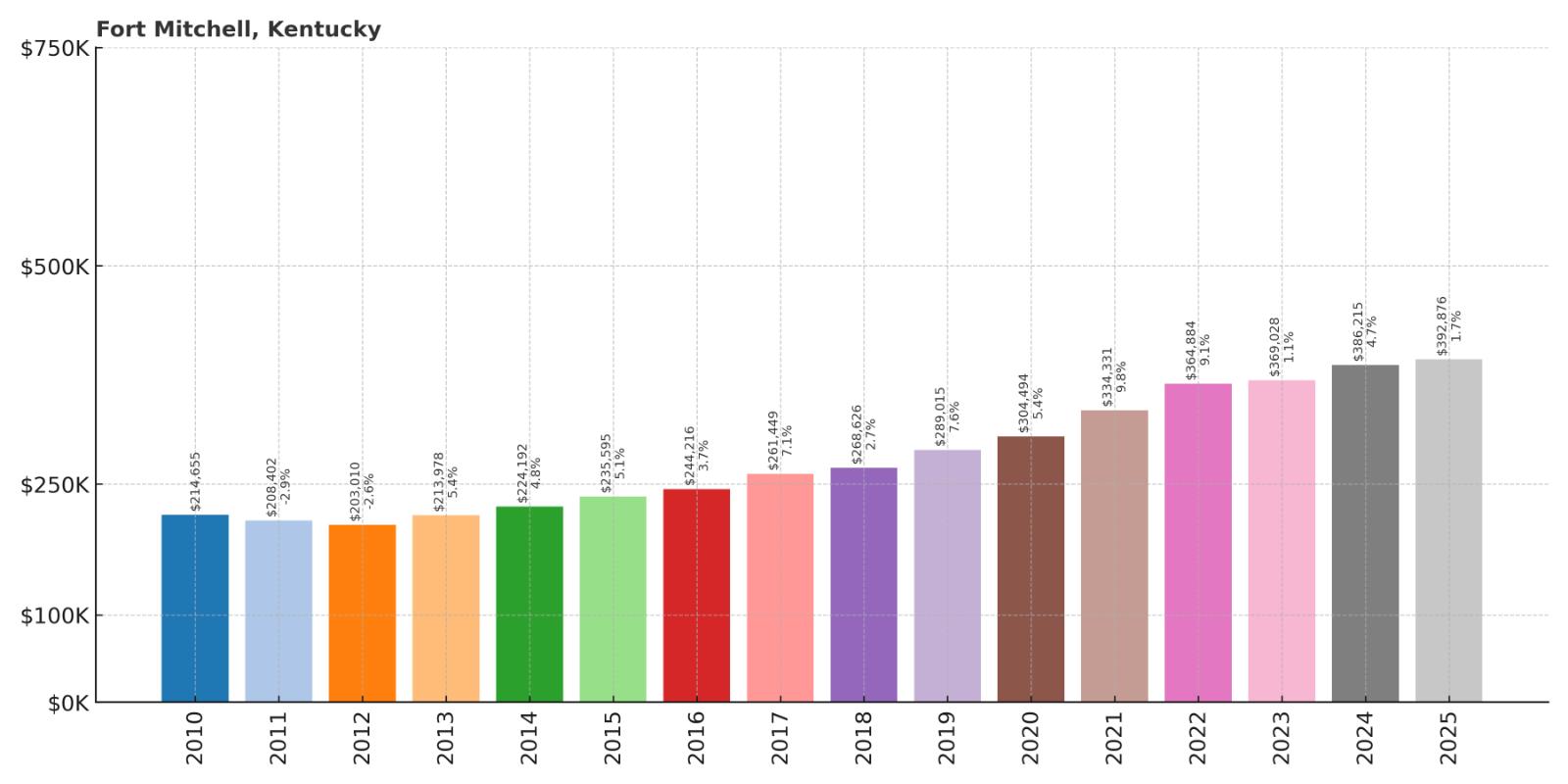
- 2010: $214,655
- 2011: $208,402
- 2012: $203,010
- 2013: $213,978
- 2014: $224,192
- 2015: $235,595
- 2016: $244,216
- 2017: $261,449
- 2018: $268,626
- 2019: $289,015
- 2020: $304,494
- 2021: $334,331
- 2022: $364,884
- 2023: $369,028
- 2024: $386,215
- 2025: $392,876
Fort Mitchell has delivered steady appreciation with an 83% increase since 2010, climbing from $214,655 to $392,876. The community showed consistent growth momentum with acceleration during recent years, particularly during 2019-2022 when values jumped significantly. This established Northern Kentucky suburb continues attracting buyers seeking quality suburban living with Cincinnati access.
Why Fort Mitchell?
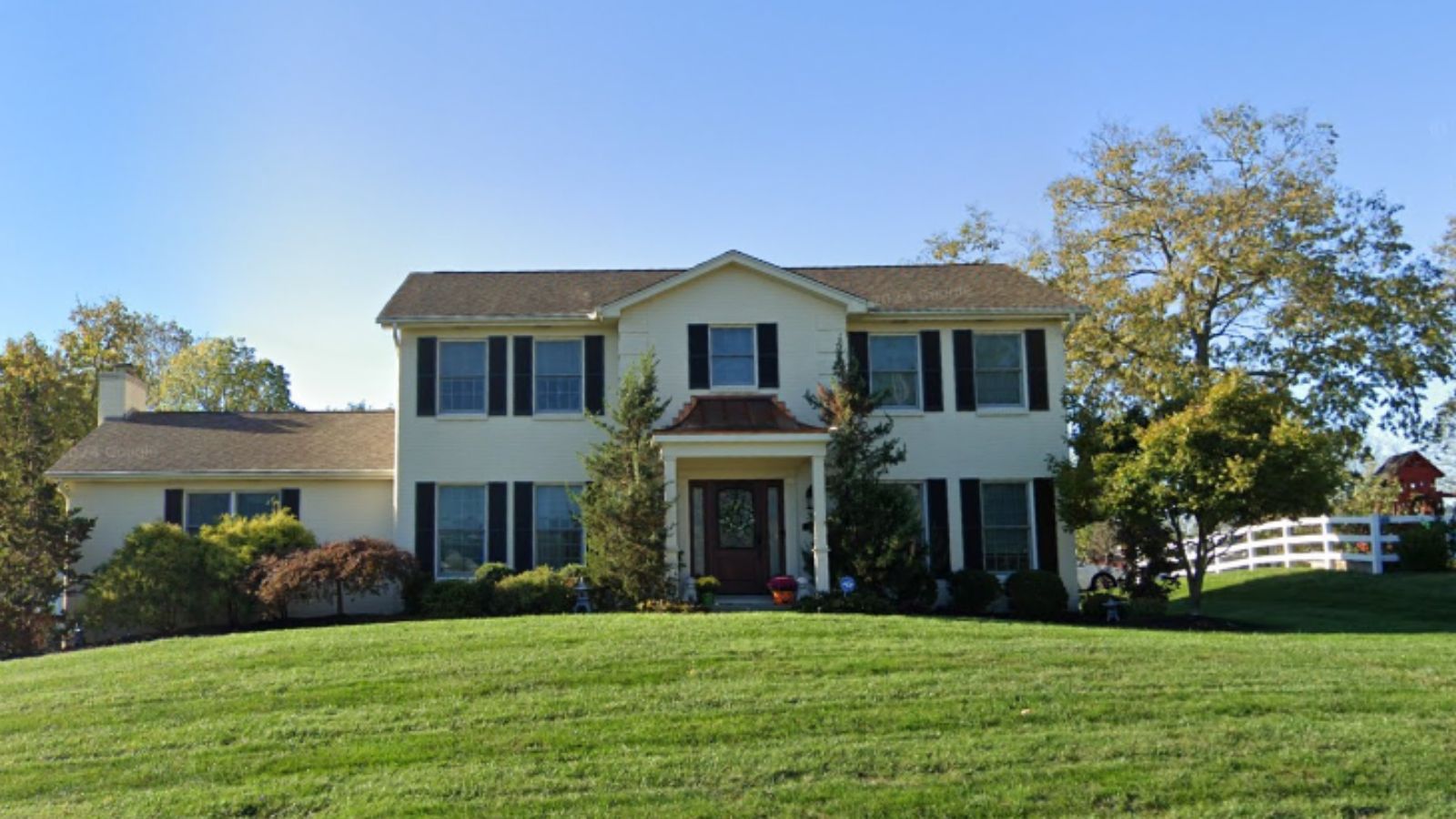
Why Are People Willing to Pay So Much to Live Here? What’s Special About It?
Fort Mitchell represents a strong wealth-building opportunity for homeowners, with property values appreciating significantly while providing steady returns that outperform many traditional investment vehicles. Located just seven miles from downtown Cincinnati, this Northern Kentucky suburb combines established neighborhoods with excellent schools and convenient interstate access. Residents enjoy suburban tranquility while maintaining easy access to urban employment and cultural opportunities.
The community offers mature neighborhoods with quality construction and established amenities that create stable property values. Fort Mitchell’s strategic location provides flexibility for commuters while the established infrastructure and services support long-term residential satisfaction. The area’s combination of accessibility and residential character maintains strong appeal across multiple generations of homebuyers.
How Fort Mitchell Rose to Prominence
Incorporated in 1962, Fort Mitchell developed as part of Cincinnati’s suburban expansion into Northern Kentucky during the post-war housing boom. The community attracted middle and upper-middle-class families seeking suburban alternatives to urban living with access to Cincinnati employment. Early development emphasized quality residential neighborhoods with good schools and community amenities.
The completion of major highway infrastructure enhanced Fort Mitchell’s accessibility while the community maintained its suburban character through careful planning and zoning. The establishment of quality schools and recreational facilities helped attract and retain families through multiple decades. The community’s strategic location and commitment to maintaining neighborhood standards have sustained strong residential demand and property appreciation.
3 Interesting Tidbits
1. Strategic Location – Fort Mitchell sits just seven miles from downtown Cincinnati, providing excellent access to major employment centers and urban amenities.
2. Established Community – The area features mature neighborhoods with quality infrastructure and services developed over several decades of careful planning.
3. Investment Performance – Property values have delivered consistent appreciation that significantly outperforms many traditional investment alternatives.
10. Simpsonville – 80% Home Price Increase Since 2010
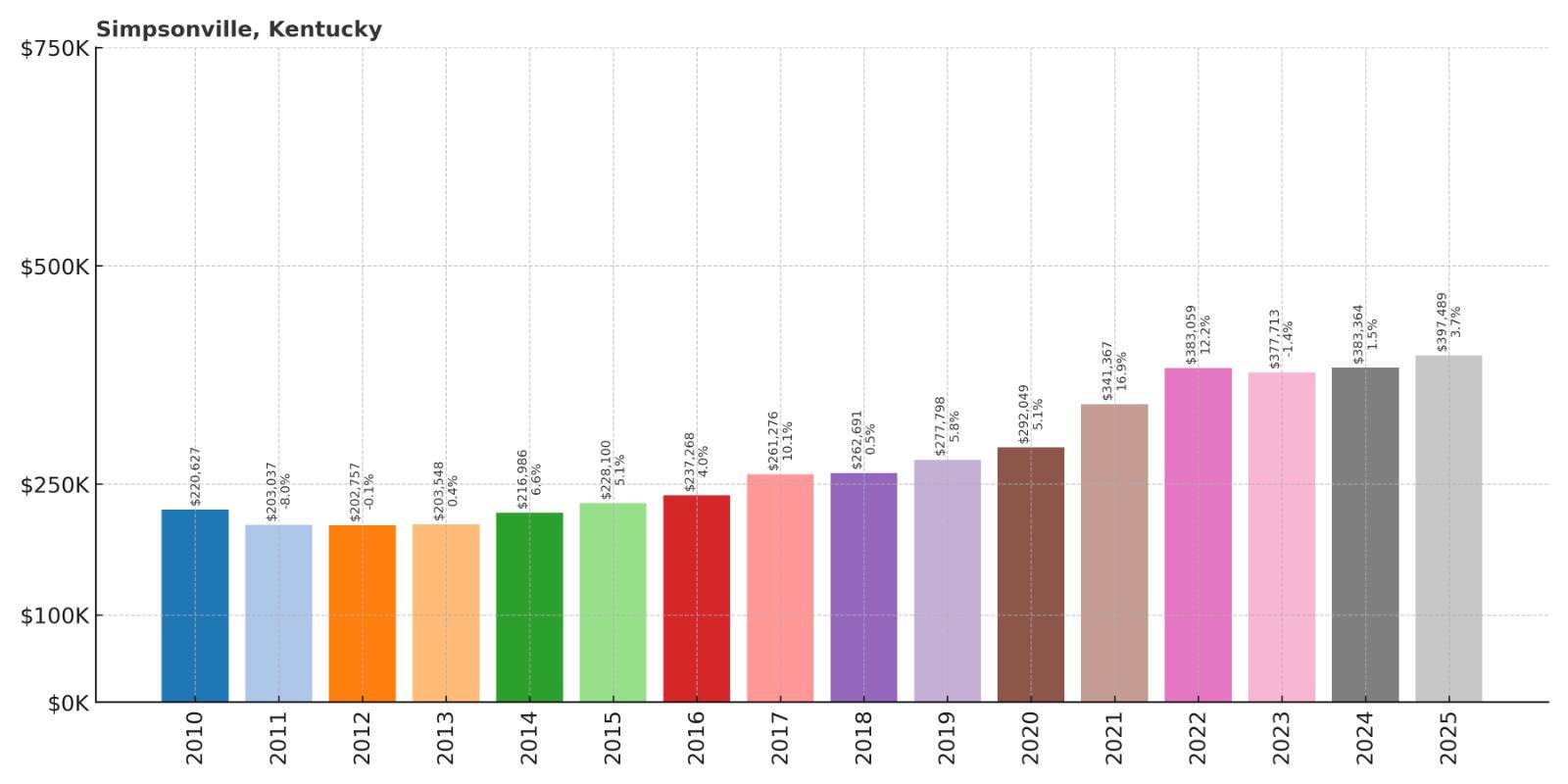
- 2010: $220,627
- 2011: $203,037
- 2012: $202,757
- 2013: $203,548
- 2014: $216,986
- 2015: $228,100
- 2016: $237,268
- 2017: $261,276
- 2018: $262,691
- 2019: $277,798
- 2020: $292,049
- 2021: $341,367
- 2022: $383,059
- 2023: $377,713
- 2024: $383,364
- 2025: $397,489
Simpsonville has achieved solid growth with an 80% increase since 2010, recovering from early-decade challenges to reach $397,489 in current values. The community showed impressive momentum after 2016 with dramatic acceleration during 2021-2022 when values jumped from $292,049 to over $380,000. This Shelby County community demonstrates the appreciation potential in Kentucky’s suburban markets.
Why Simpsonville?
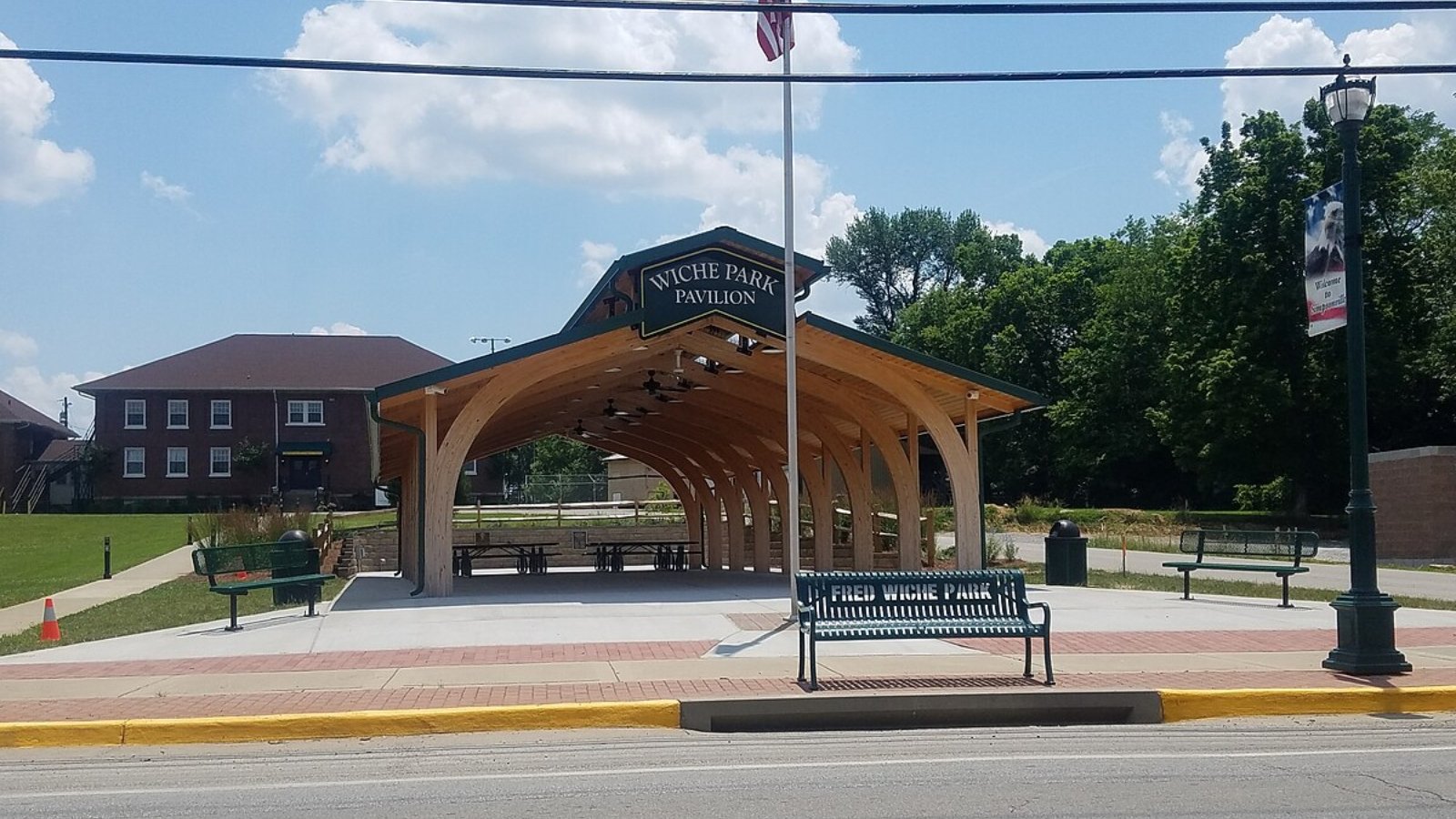
Why Are People Willing to Pay So Much to Live Here? What’s Special About It?
Simpsonville offers suburban living in Shelby County with access to both Louisville and Lexington employment markets, providing flexibility for residents with varying career needs. The community features quality neighborhoods, good schools, and recreational opportunities that support family living. Residents appreciate the balance of suburban amenities with small-town character and natural beauty.
The area provides an attractive alternative to urban living while maintaining reasonable commute times to major employment centers. Simpsonville’s growth reflects broader trends toward suburban communities that offer quality of life advantages including larger properties, newer construction, and family-oriented amenities. The community’s strategic location and development patterns support continued residential demand.
How Simpsonville Rose to Prominence
Established in Shelby County as a small farming community, Simpsonville remained primarily agricultural through much of its history. The community’s location between Louisville and Lexington made it a natural stopping point for transportation and commerce. Suburban expansion from Louisville gradually reached Simpsonville during the late 20th century.
Strategic planning and development during recent decades helped Simpsonville manage growth while preserving community character. The addition of suburban amenities including shopping centers, schools, and recreational facilities created a comprehensive community environment. The area’s natural advantages and strategic location have attracted residents seeking suburban alternatives to urban living with access to multiple metropolitan markets.
3 Interesting Tidbits
1. Dual Access – Simpsonville’s location provides convenient access to both Louisville and Lexington metropolitan areas, offering employment flexibility.
2. Natural Setting – The community features rolling countryside and natural beauty that enhance quality of life and property appeal.
3. Growth Management – Simpsonville has successfully balanced suburban development with preservation of community character and natural amenities.
9. Alvaton – 129% Home Price Increase Since 2010
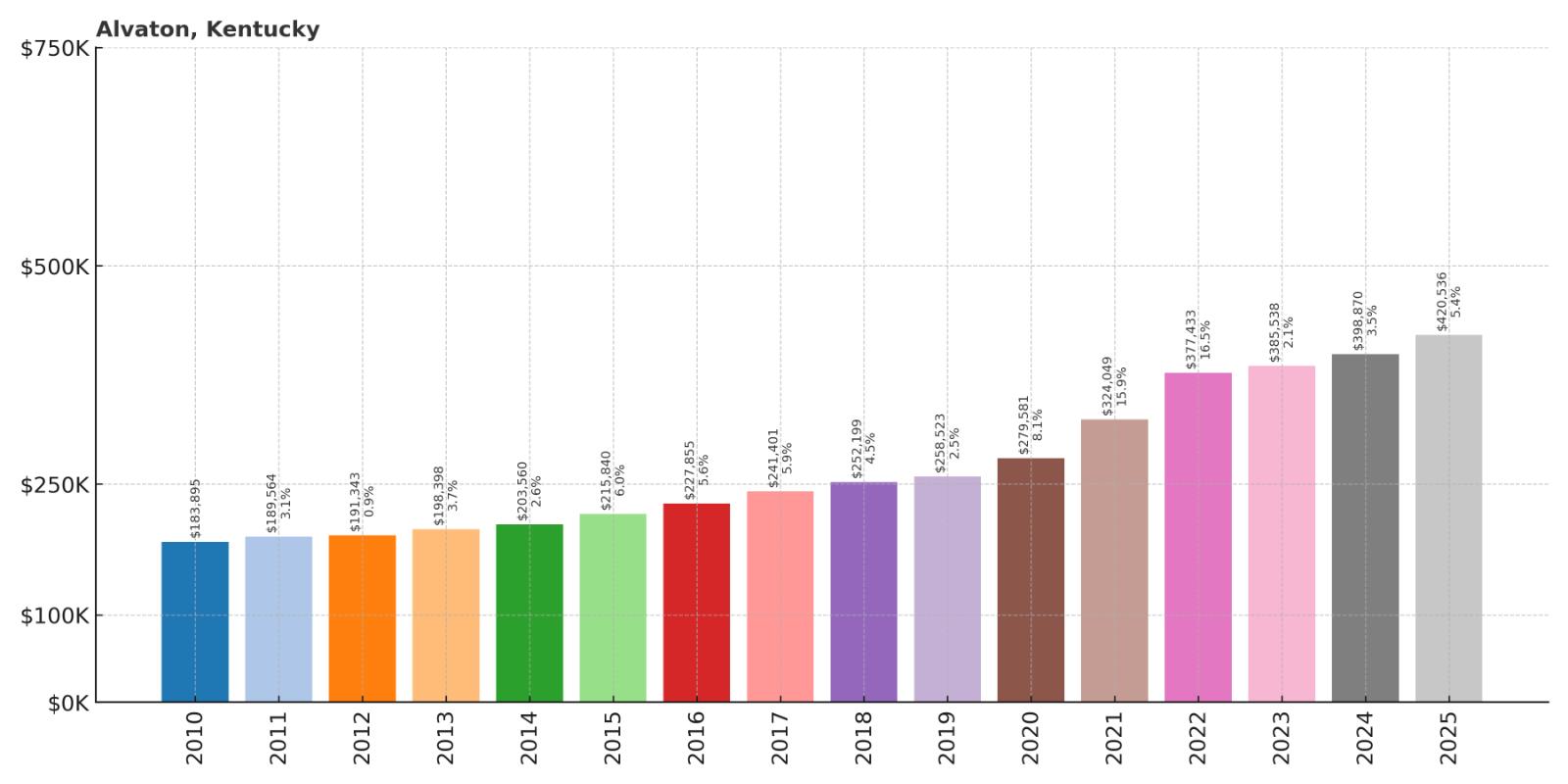
- 2010: $183,895
- 2011: $189,564
- 2012: $191,343
- 2013: $198,398
- 2014: $203,560
- 2015: $215,840
- 2016: $227,855
- 2017: $241,401
- 2018: $252,199
- 2019: $258,523
- 2020: $279,581
- 2021: $324,049
- 2022: $377,433
- 2023: $385,538
- 2024: $398,870
- 2025: $420,536
Alvaton has delivered exceptional growth with a remarkable 129% increase since 2010, more than doubling from $183,895 to $420,536. The community showed consistent momentum with dramatic acceleration during pandemic years when values surged from $279,581 to current levels. This Warren County community represents one of Kentucky’s most impressive appreciation stories outside major metropolitan areas.
Why Alvaton?
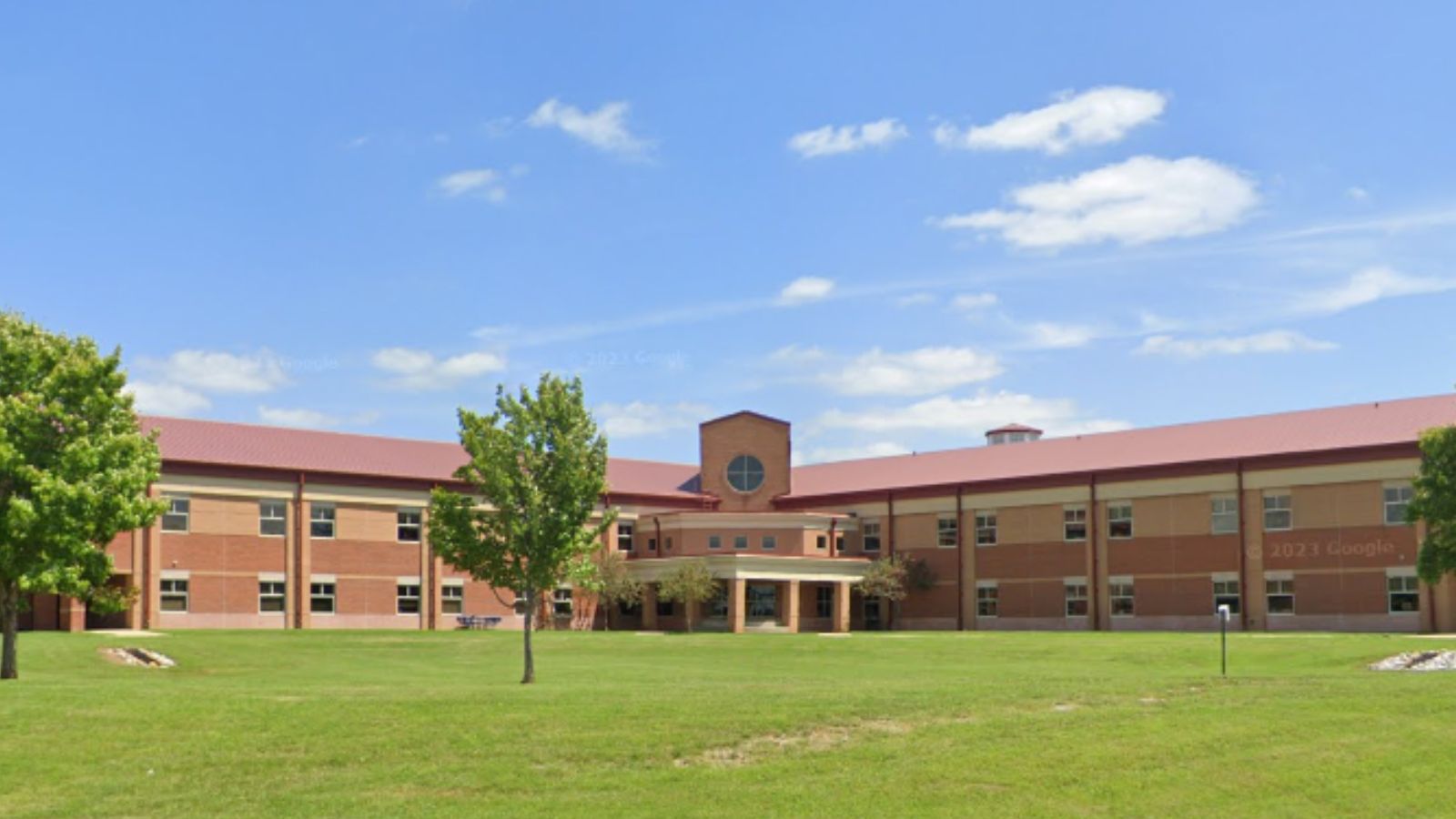
Why Are People Willing to Pay So Much to Live Here? What’s Special About It?
Alvaton offers suburban living near Bowling Green with access to employment opportunities at Western Kentucky University and other regional employers. The community provides newer housing developments with modern amenities while maintaining affordability compared to larger metropolitan markets. Residents enjoy quality schools, recreational facilities, and community services that support family living.
The area benefits from Bowling Green’s economic growth and diversification, including manufacturing, education, and healthcare sectors that provide stable employment opportunities. Alvaton’s strategic location and quality development attract families seeking suburban amenities with reasonable housing costs. The community’s rapid appreciation reflects growing demand for quality suburban alternatives in Kentucky’s secondary markets.
How Alvaton Rose to Prominence
Originally a small farming community in Warren County, Alvaton remained largely rural until recent decades when suburban expansion from Bowling Green reached the area. The community’s proximity to Western Kentucky University and Bowling Green’s growing economy attracted residential development and population growth. Strategic planning helped manage this growth while maintaining community character.
The development of family-oriented subdivisions and the expansion of local services created a suburban environment that appeals to young professionals and growing families. Alvaton’s success reflects broader economic growth in the Bowling Green area and increasing demand for suburban housing options. The community’s continued development and appreciation demonstrate the potential in Kentucky’s emerging suburban markets.
3 Interesting Tidbits
1. University Access – Alvaton’s proximity to Western Kentucky University provides educational and employment opportunities that support community growth.
2. Rapid Development – The community has transformed from rural farmland to suburban development in just a few decades of strategic growth.
3. Economic Diversity – The area benefits from Bowling Green’s diverse economy including manufacturing, healthcare, and education sectors.
8. Wilsonville – 95% Home Price Increase Since 2010
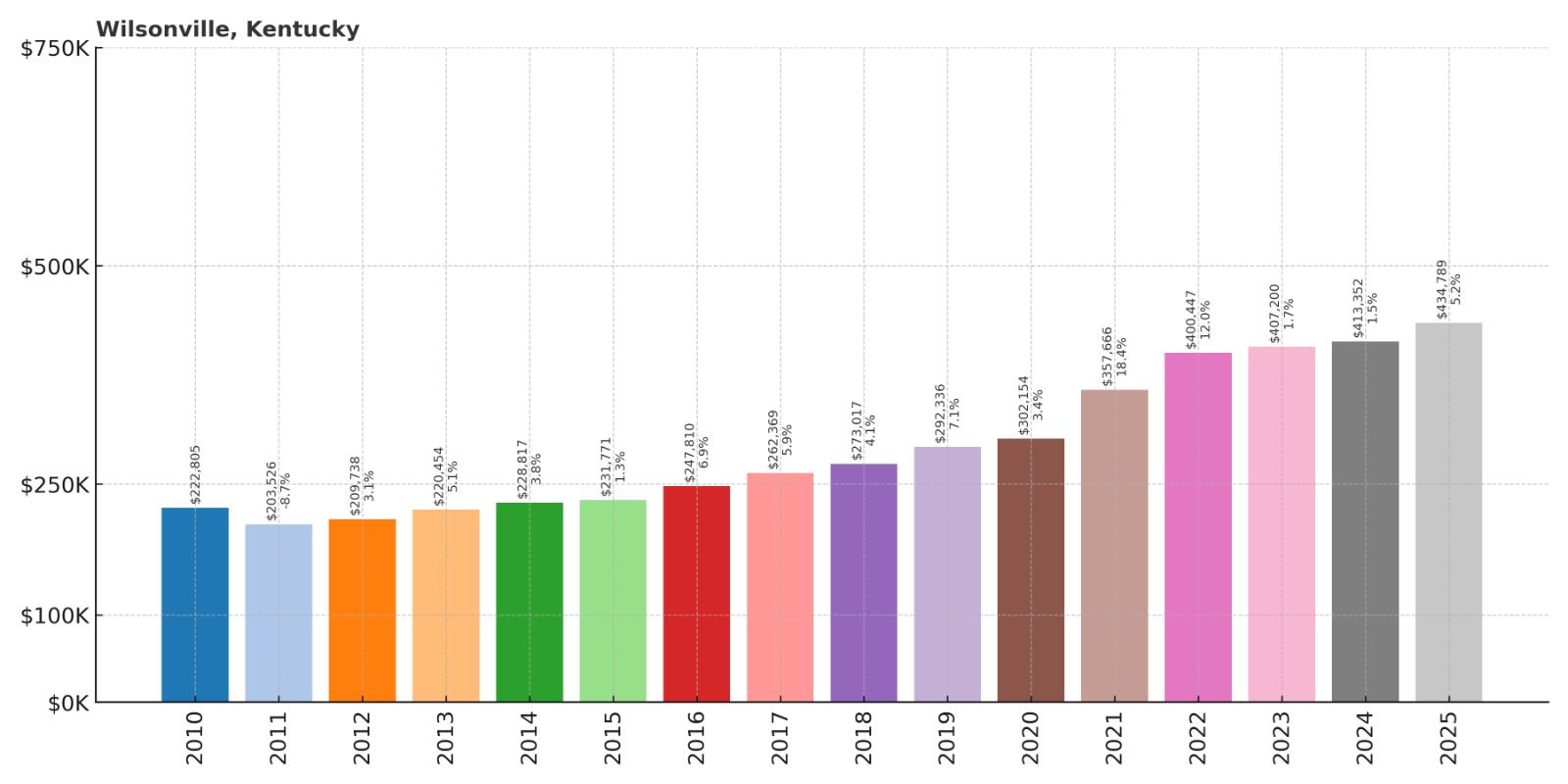
- 2010: $222,805
- 2011: $203,526
- 2012: $209,738
- 2013: $220,454
- 2014: $228,817
- 2015: $231,771
- 2016: $247,810
- 2017: $262,369
- 2018: $273,017
- 2019: $292,336
- 2020: $302,154
- 2021: $357,666
- 2022: $400,447
- 2023: $407,200
- 2024: $413,352
- 2025: $434,789
Wilsonville has nearly doubled in value with a 95% increase since 2010, climbing from $222,805 to $434,789. After early-decade volatility, the community found consistent momentum with dramatic acceleration during 2021-2022 when values jumped from $302,154 to over $400,000. This Spencer County community demonstrates exceptional appreciation potential in Kentucky’s rural markets.
Why Wilsonville?
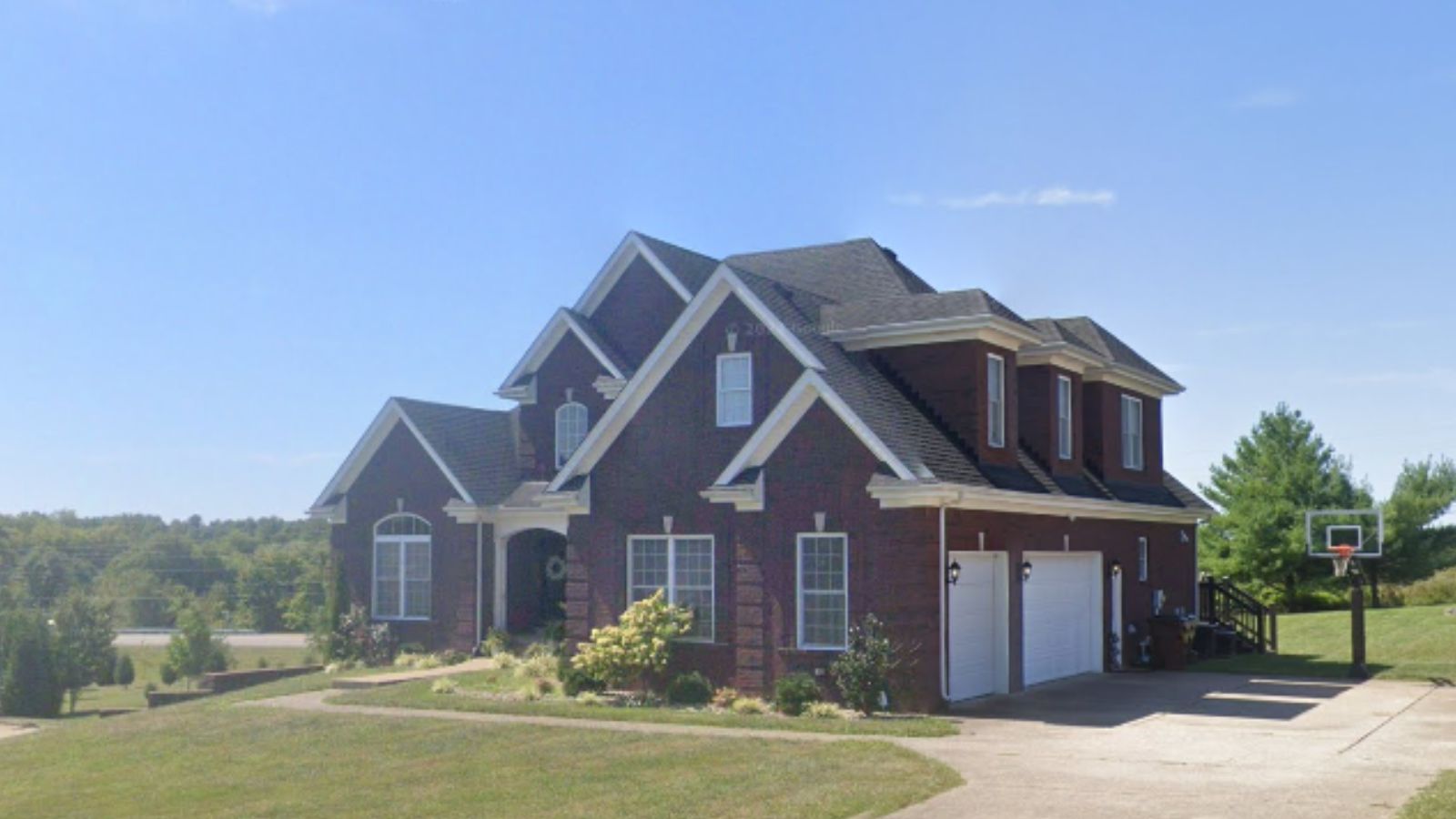
Why Are People Willing to Pay So Much to Live Here? What’s Special About It?
Wilsonville offers rural charm and country living with reasonable access to both Louisville and Lexington metropolitan areas, appealing to buyers seeking peaceful settings without complete isolation from urban amenities. The community provides larger properties and agricultural opportunities while maintaining connectivity to employment centers. Residents enjoy the natural beauty and outdoor recreation opportunities of rural Kentucky.
The area attracts those seeking alternatives to suburban density, with properties that offer space for horses, farming, and outdoor activities. Wilsonville’s appreciation reflects growing demand for rural properties as remote work makes country living more viable. The community’s strategic location and natural advantages create appeal for buyers seeking authentic Kentucky countryside experiences.
How Wilsonville Rose to Prominence
Originally a small farming community in Spencer County, Wilsonville remained primarily agricultural through most of its history. The area’s fertile land and rural character attracted those seeking farming opportunities and country living. Recent decades have seen growing interest from buyers seeking rural alternatives to suburban and urban living.
The community has benefited from broader trends toward rural living and the growth of remote work opportunities that allow professionals to live in countryside settings. Strategic infrastructure improvements have maintained accessibility while preserving rural character. Wilsonville’s success demonstrates the appreciation potential in Kentucky’s rural communities as lifestyle preferences shift toward country living.
3 Interesting Tidbits
1. Agricultural Heritage – Wilsonville maintains active farming and agricultural traditions that define the community’s rural character.
2. Country Estates – Many properties offer acreage suitable for horses, farming, and rural lifestyle pursuits.
3. Strategic Access – The community provides rural living while maintaining reasonable access to Louisville and Lexington employment markets.
7. Union – 65% Home Price Increase Since 2010
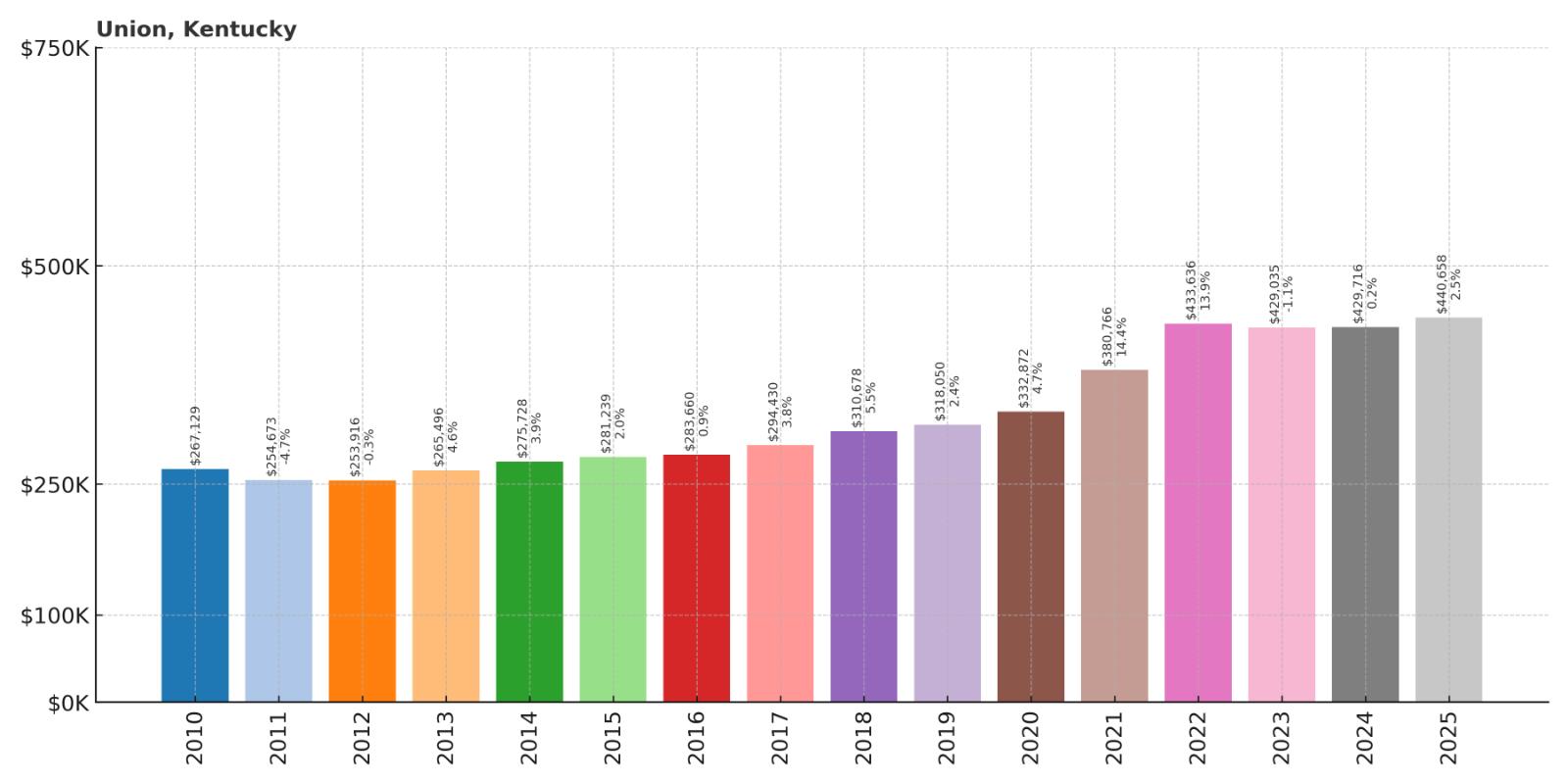
- 2010: $267,129
- 2011: $254,673
- 2012: $253,916
- 2013: $265,496
- 2014: $275,728
- 2015: $281,239
- 2016: $283,660
- 2017: $294,430
- 2018: $310,678
- 2019: $318,050
- 2020: $332,872
- 2021: $380,766
- 2022: $433,636
- 2023: $429,035
- 2024: $429,716
- 2025: $440,658
Union has delivered solid returns with a 65% increase since 2010, climbing from $267,129 to $440,658. Starting from a higher base than many communities, Union showed steady appreciation with acceleration during 2021-2022 when values jumped significantly. This Boone County community has transformed from rural crossroads to upscale suburb while maintaining steady demand and property appreciation.
Why Union?

Why Are People Willing to Pay So Much to Live Here? What’s Special About It?
Union represents a rapidly growing community in Boone County that has transformed from rural crossroads to upscale suburb, strategically positioned near Cincinnati/Northern Kentucky International Airport. The area offers newer construction and family-friendly amenities while providing access to Cincinnati employment centers. Residents appreciate the modern infrastructure, quality schools, and recreational facilities that support contemporary suburban living.
The community provides excellent value for buyers seeking new construction and modern amenities while maintaining reasonable commute times to major employment centers. Union’s planned development includes shopping centers, parks, and services that create a comprehensive suburban environment. The area’s growth reflects successful planning that balances residential development with commercial amenities and transportation access.
How Union Rose to Prominence
Originally a small crossroads community in Boone County, Union remained largely rural until airport development and highway construction transformed the area’s economic prospects. The proximity to Cincinnati/Northern Kentucky International Airport and major transportation corridors attracted residential and commercial development. Strategic planning during rapid growth helped maintain community character while providing modern amenities.
The community’s development accelerated during the 1990s and 2000s as Cincinnati’s suburban expansion reached the area. The addition of shopping centers, schools, and recreational facilities created a comprehensive suburban environment. Union’s success reflects strategic location advantages and quality development standards that attracted residents seeking modern suburban living with airport and highway access.
3 Interesting Tidbits
1. Airport Proximity – Union sits near Cincinnati/Northern Kentucky International Airport, making it popular with frequent travelers and aviation industry employees.
2. Rapid Transformation – The community has evolved from rural farmland to upscale suburb in just a few decades of strategic development.
3. Modern Amenities – Union features contemporary shopping centers, recreational facilities, and services designed for modern suburban living.
6. Buckner – 59% Home Price Increase Since 2017
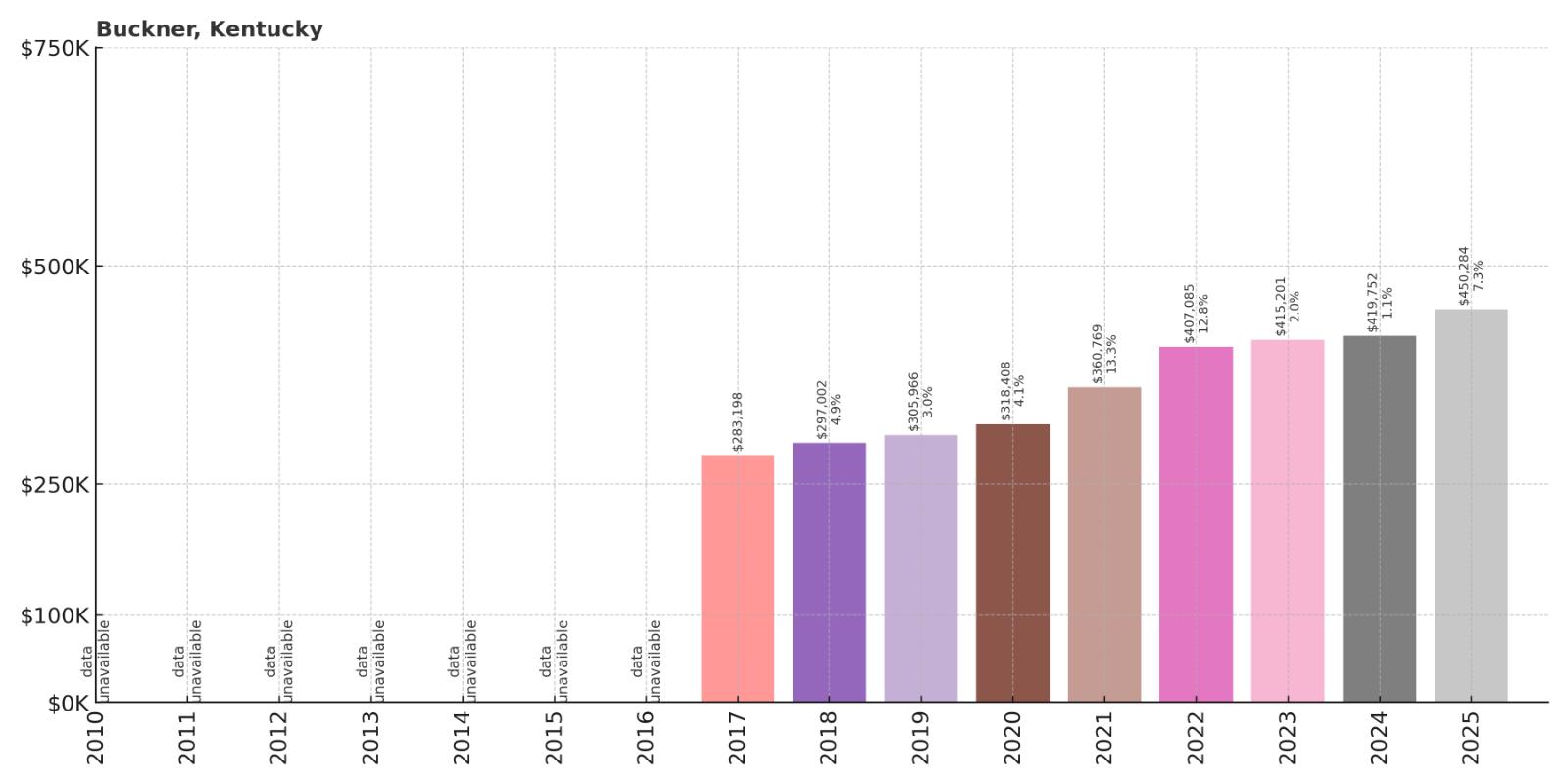
- 2010: N/A
- 2011: N/A
- 2012: N/A
- 2013: N/A
- 2014: N/A
- 2015: N/A
- 2016: N/A
- 2017: $283,198
- 2018: $297,002
- 2019: $305,966
- 2020: $318,408
- 2021: $360,769
- 2022: $407,085
- 2023: $415,201
- 2024: $419,752
- 2025: $450,284
Buckner has shown impressive growth with a 59% increase since 2017 when data became available, climbing from $283,198 to $450,284. The community demonstrated consistent momentum with acceleration during pandemic years when values jumped significantly. This Oldham County community represents successful suburban development in one of Kentucky’s most prestigious counties.
Why Buckner?
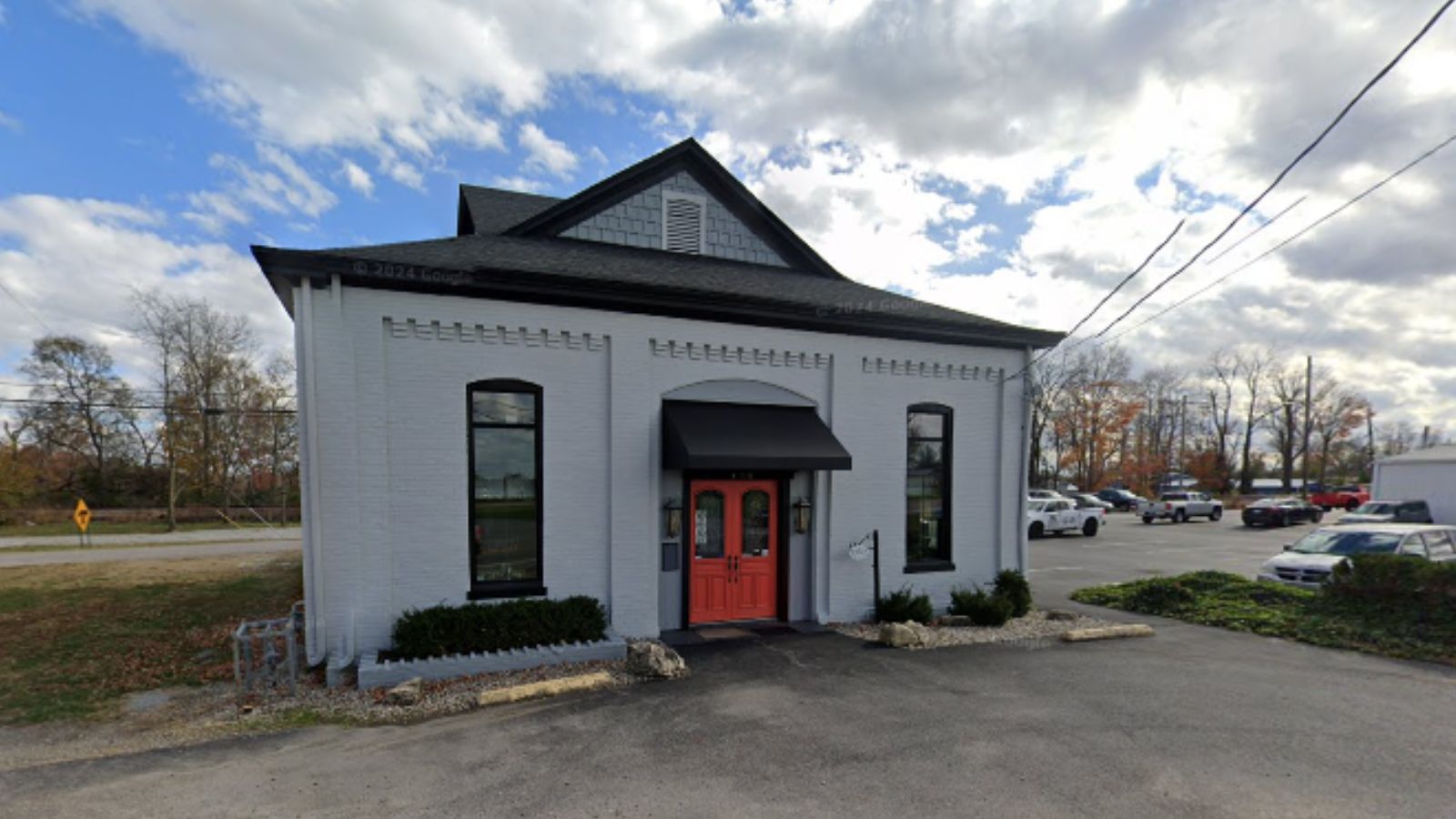
Why Are People Willing to Pay So Much to Live Here? What’s Special About It?
Buckner offers upscale suburban living in prestigious Oldham County with excellent schools, newer developments, and convenient access to Louisville employment centers. The community features quality construction, larger lots, and modern amenities that appeal to affluent families. Residents enjoy the combination of suburban convenience and small-town character with access to Louisville’s cultural and economic opportunities.
The area provides premium suburban living with emphasis on quality development and community amenities. Buckner’s location in Oldham County adds prestige and ensures strong property values through association with one of Kentucky’s most affluent areas. The community’s growth reflects successful planning that attracts educated professionals and growing families seeking quality suburban alternatives.
How Buckner Rose to Prominence
Buckner developed as part of Oldham County’s suburban expansion, representing planned residential development designed to meet growing demand for upscale suburban housing. The community’s strategic location and quality development standards attracted affluent residents seeking alternatives to urban living. Careful planning ensured that growth maintained community character while providing modern amenities.
The development incorporated quality schools, recreational facilities, and services needed by affluent families. Buckner’s success reflects broader trends in Oldham County toward planned communities that provide comprehensive residential environments. The community’s continued growth and appreciation demonstrate the strength of Kentucky’s premium suburban markets.
3 Interesting Tidbits
1. Oldham County Prestige – Buckner benefits from its location in Oldham County, one of Kentucky’s most affluent and desirable areas.
2. Quality Development – The community features newer construction with modern amenities and quality building standards.
3. Educational Excellence – Buckner is served by highly rated Oldham County schools that attract families seeking educational quality.
5. Finchville – 101% Home Price Increase Since 2010
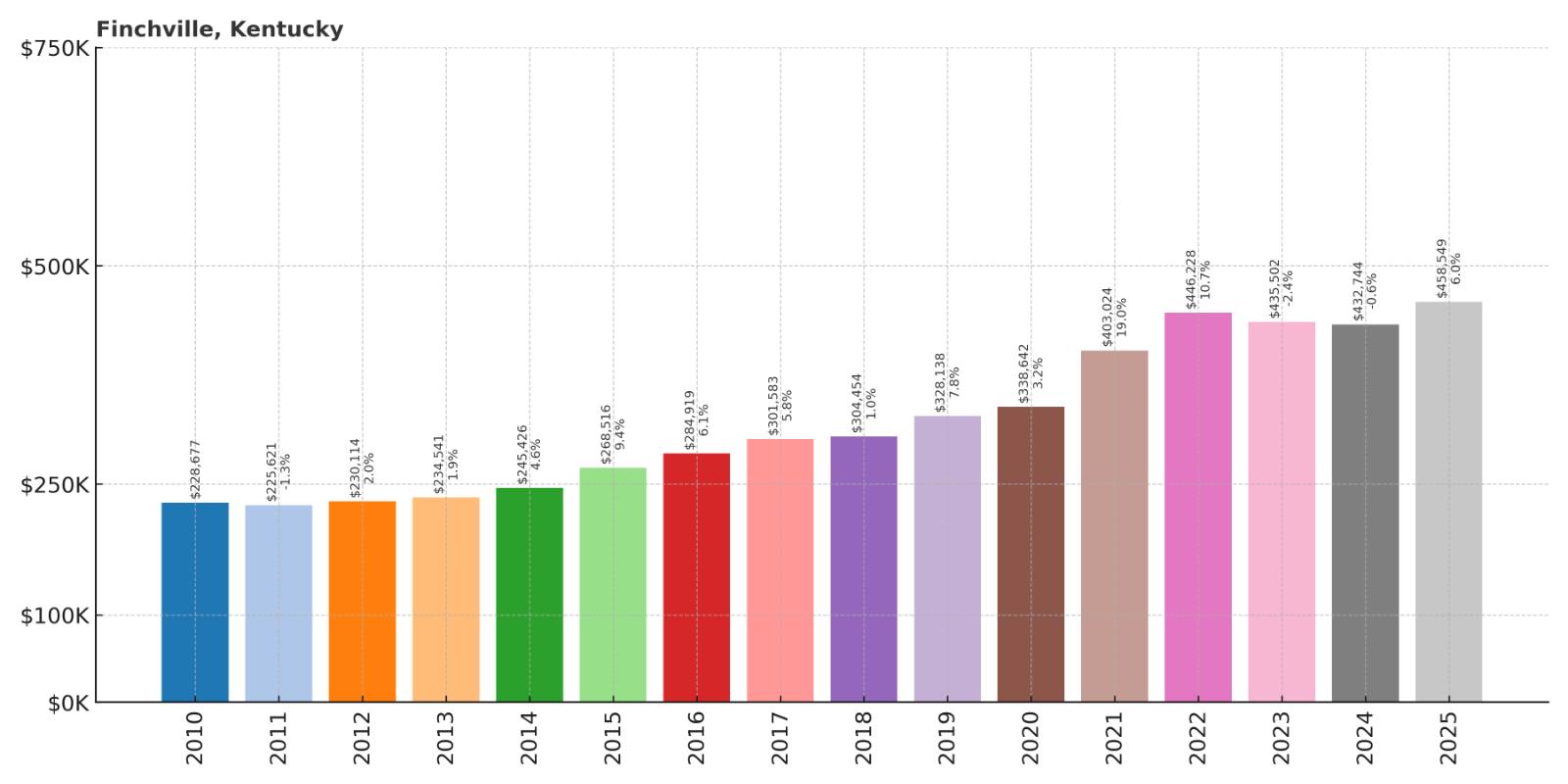
- 2010: $228,677
- 2011: $225,621
- 2012: $230,114
- 2013: $234,541
- 2014: $245,426
- 2015: $268,516
- 2016: $284,919
- 2017: $301,583
- 2018: $304,454
- 2019: $328,138
- 2020: $338,642
- 2021: $403,024
- 2022: $446,228
- 2023: $435,502
- 2024: $432,744
- 2025: $458,549
Finchville has exactly doubled in value with a precise 101% increase since 2010, climbing from $228,677 to $458,549. The community showed consistent growth momentum with dramatic acceleration during 2021 when values jumped over $64,000 in one year. This Shelby County community demonstrates the appreciation potential in Kentucky’s rural markets near metropolitan areas.
Why Finchville?
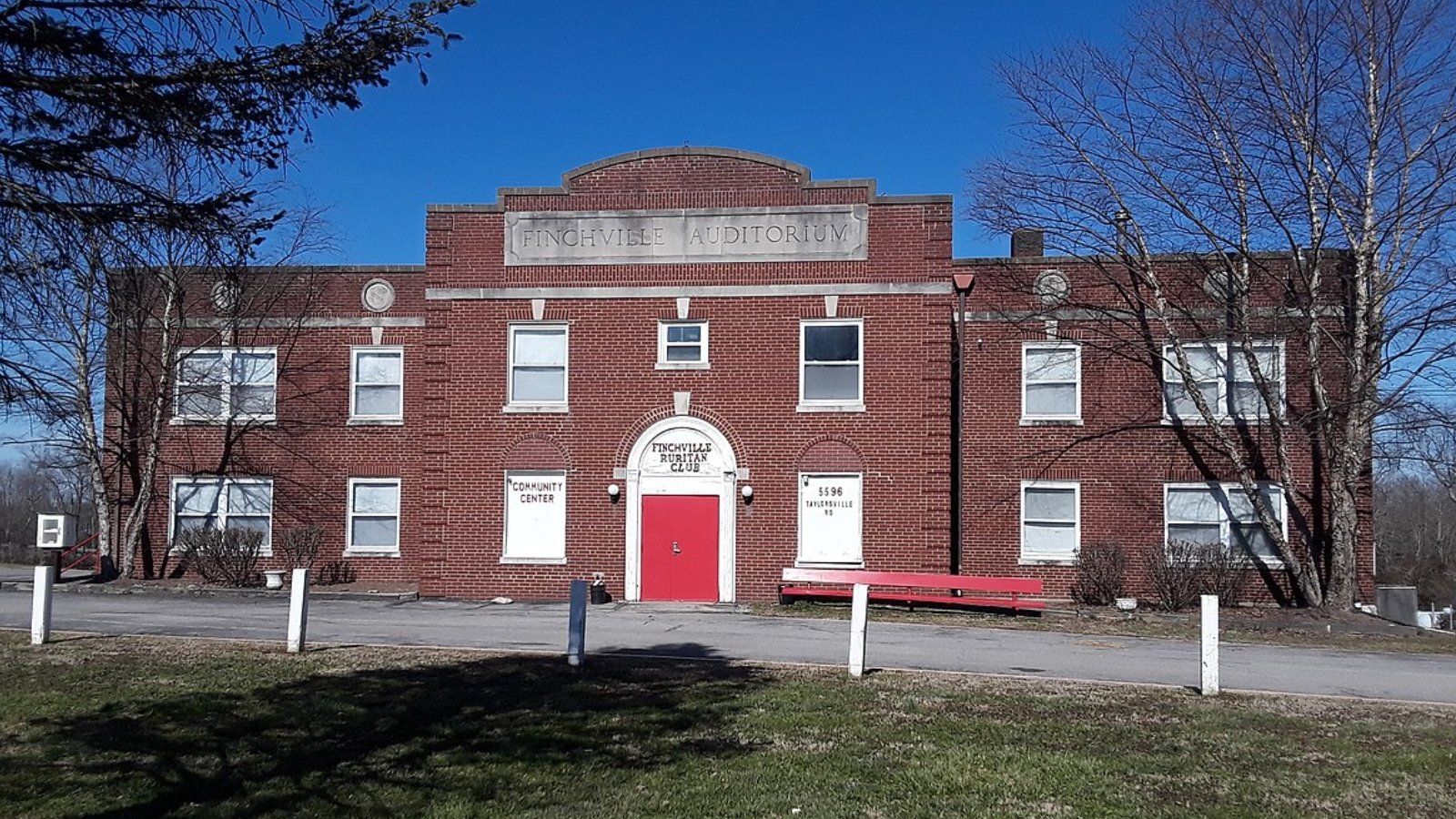
Why Are People Willing to Pay So Much to Live Here? What’s Special About It?
Finchville offers rural charm in eastern Shelby County with larger properties and country estates while maintaining reasonable commuting access to both Louisville and Frankfort. The community provides a unique lifestyle centered around horse properties and rural living that appeals to affluent buyers seeking authentic Kentucky countryside experiences. Residents enjoy privacy, natural beauty, and outdoor recreation opportunities.
The area creates a niche market for upscale rural properties that offer space for horses, farming, and country pursuits while staying within commuting distance of urban employment centers. Finchville’s appreciation reflects growing demand for rural alternatives as buyers seek larger properties and peaceful settings. The community’s strategic location and natural advantages command premium pricing from those seeking genuine country living.
How Finchville Rose to Prominence
Originally a small farming community in eastern Shelby County, Finchville remained primarily agricultural through most of its history. The area’s fertile land and rural character attracted farming families and those seeking country living. Recent decades have seen growing interest from affluent buyers seeking rural estates and horse properties within reasonable distance of Louisville.
The community has increasingly attracted luxury homebuyers seeking larger properties and country estates while maintaining access to urban amenities and employment. Strategic location between Louisville and Frankfort provides flexibility for residents with varying career needs. Finchville’s success demonstrates the strength of Kentucky’s rural luxury market as lifestyle preferences shift toward country living.
3 Interesting Tidbits
1. Horse Country – Finchville features numerous horse farms and properties suitable for equestrian activities and livestock.
2. Rural Estates – Many properties offer significant acreage and custom homes that create country estate environments.
3. Strategic Location – The community provides rural living while maintaining access to both Louisville and Frankfort employment markets.
4. River Bluff – 62% Home Price Increase Since 2017
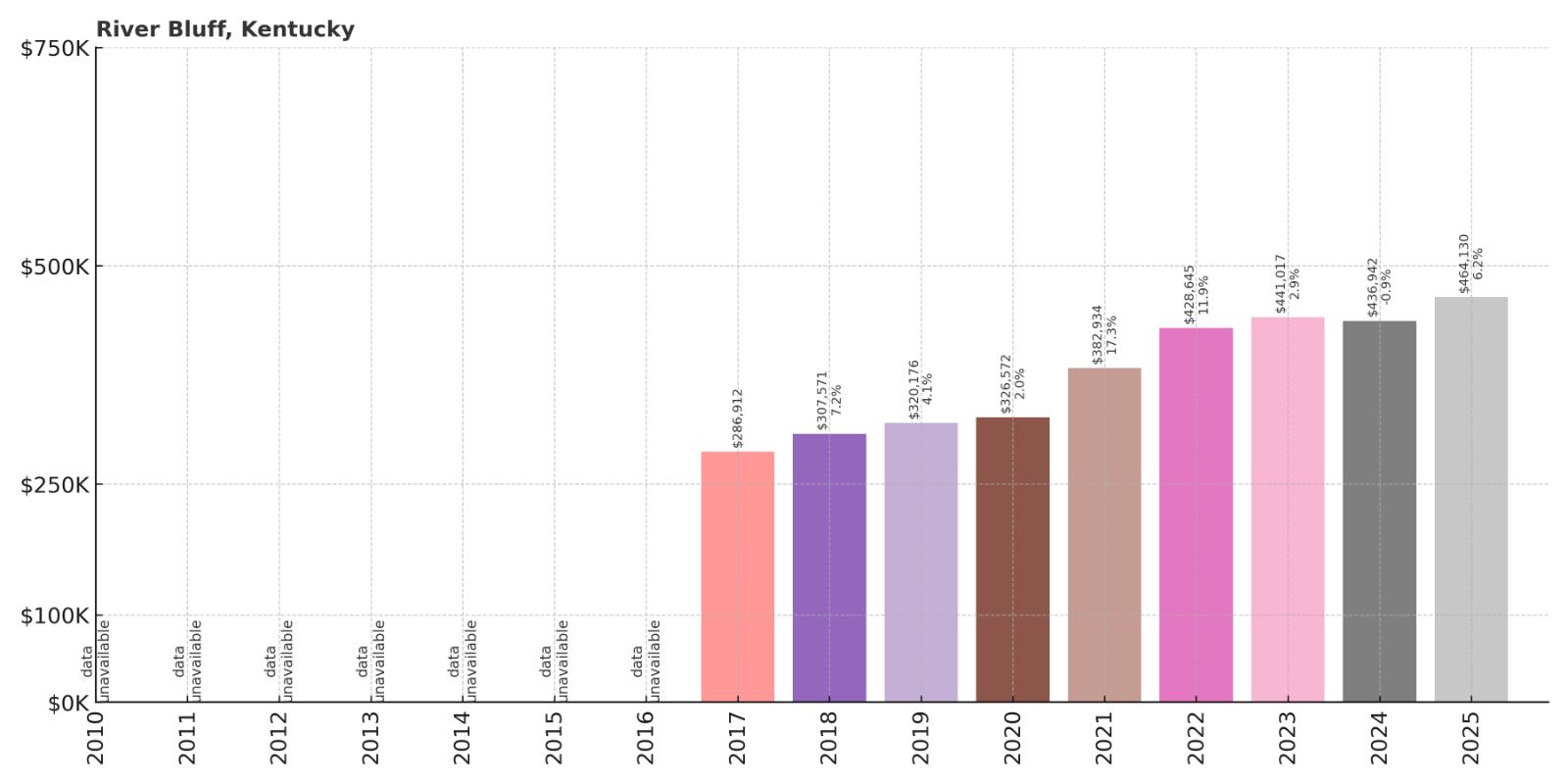
- 2010: N/A
- 2011: N/A
- 2012: N/A
- 2013: N/A
- 2014: N/A
- 2015: N/A
- 2016: N/A
- 2017: $286,912
- 2018: $307,571
- 2019: $320,176
- 2020: $326,572
- 2021: $382,934
- 2022: $428,645
- 2023: $441,017
- 2024: $436,942
- 2025: $464,130
River Bluff has achieved solid growth with a 62% increase since 2017 when data became available, climbing from $286,912 to $464,130. The community showed consistent appreciation with strong momentum during 2021-2022 when values jumped significantly. This newer development represents successful upscale residential planning in Kentucky’s competitive housing market.
Why River Bluff?
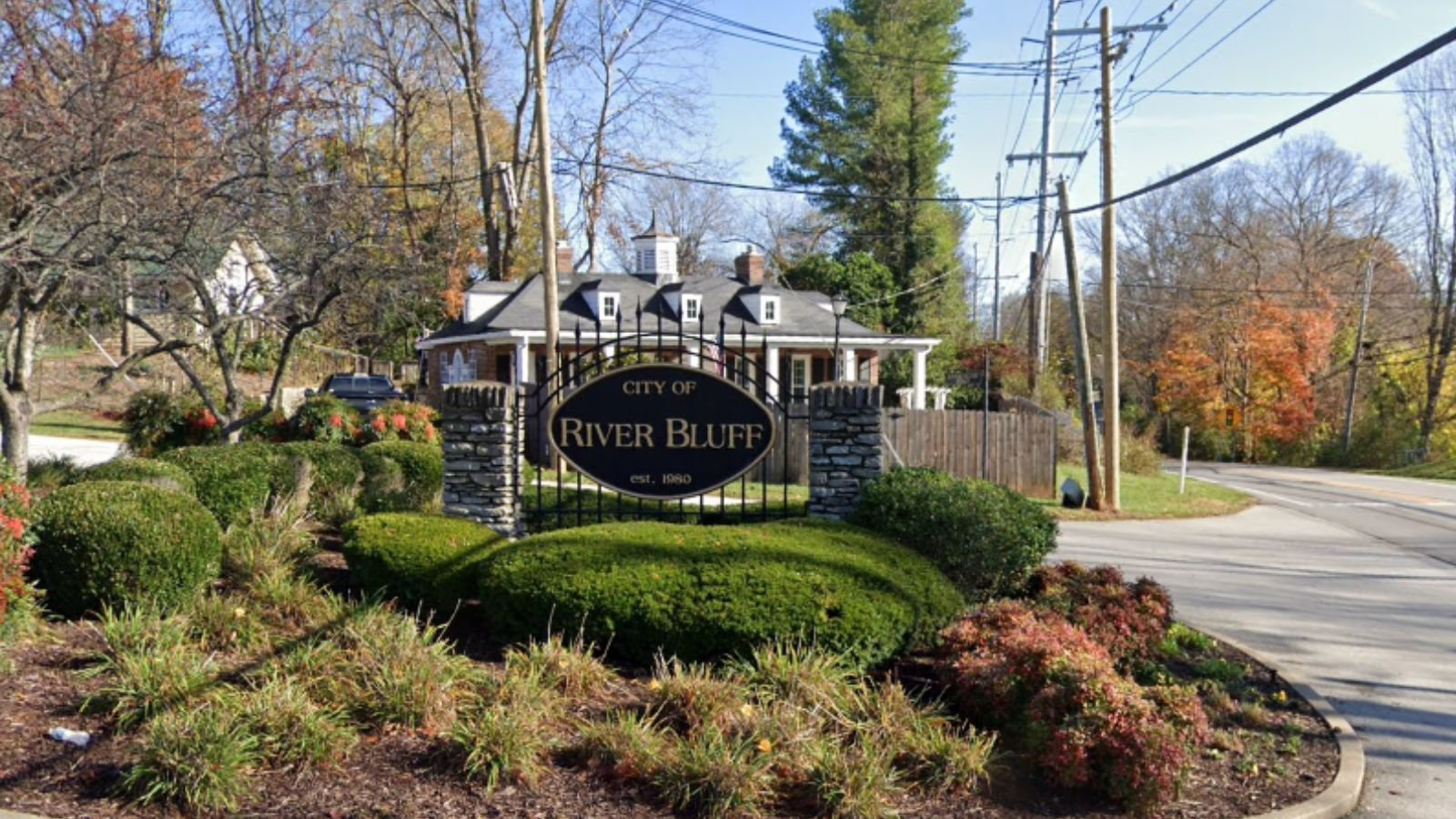
Why Are People Willing to Pay So Much to Live Here? What’s Special About It?
River Bluff offers premium residential living with scenic water views and upscale amenities that create an exclusive community atmosphere. The development features custom homes, quality construction, and recreational facilities that appeal to affluent buyers seeking luxury residential environments. Residents enjoy waterfront access and natural beauty combined with modern suburban conveniences.
The community provides a distinctive lifestyle centered around water recreation and upscale living that commands premium pricing. River Bluff’s planned development includes parks, trails, and community facilities that enhance quality of life and property values. The area’s exclusive character and natural advantages create strong appeal among buyers seeking luxury residential alternatives.
How River Bluff Rose to Prominence
River Bluff emerged as a planned luxury residential development designed to take advantage of scenic waterfront locations and natural beauty. The community was developed with emphasis on quality construction, environmental sensitivity, and exclusive residential character. Strategic planning ensured that development preserved natural features while creating upscale residential opportunities.
The development incorporated luxury amenities and recreational facilities that appeal to affluent homebuyers seeking premium residential experiences. River Bluff’s success reflects demand for exclusive residential communities that offer natural beauty, recreational opportunities, and luxury living. The community’s continued appreciation demonstrates the strength of Kentucky’s luxury residential market.
3 Interesting Tidbits
1. Waterfront Living – River Bluff offers scenic water views and access to recreational boating and water sports.
2. Luxury Development – The community features custom homes and upscale amenities designed for affluent residents.
3. Natural Beauty – River Bluff preserves natural features and landscapes that enhance property values and quality of life.
3. Crestwood – 95% Home Price Increase Since 2010
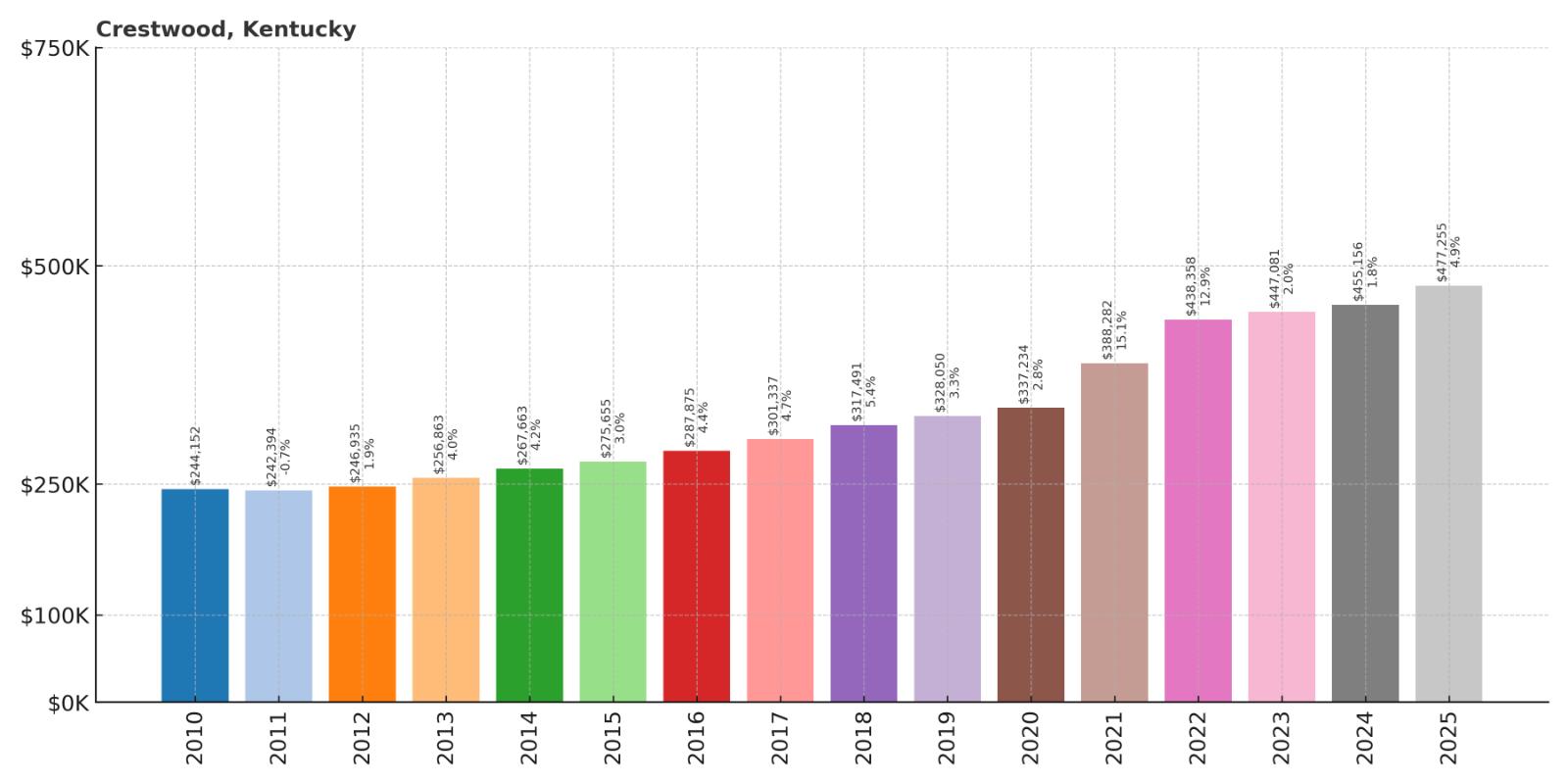
- 2010: $244,152
- 2011: $242,394
- 2012: $246,935
- 2013: $256,863
- 2014: $267,663
- 2015: $275,655
- 2016: $287,875
- 2017: $301,337
- 2018: $317,491
- 2019: $328,050
- 2020: $337,234
- 2021: $388,282
- 2022: $438,358
- 2023: $447,081
- 2024: $455,156
- 2025: $477,255
Crestwood has nearly doubled in value with an outstanding 95% increase since 2010, climbing from $244,152 to $477,255. The community maintained steady momentum throughout the decade before explosive growth during 2021-2022 propelled values past $440,000. This Oldham County jewel now ranks among Kentucky’s elite residential markets, proving that strategic location and quality development create lasting wealth for homeowners.
Why Crestwood?
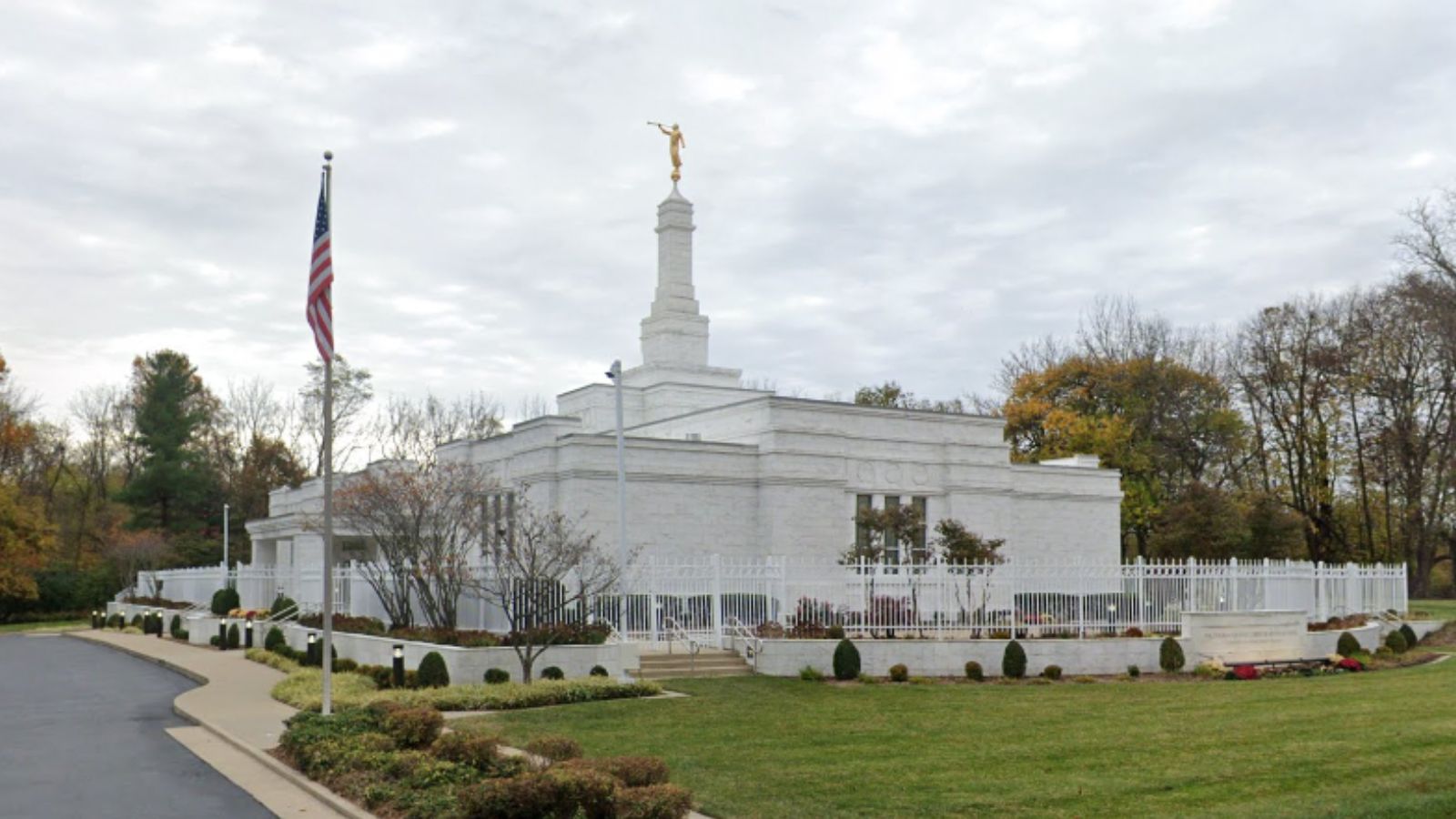
Why Are People Willing to Pay So Much to Live Here? What’s Special About It?
Crestwood delivers premium suburban living in prestigious Oldham County with top-tier schools and seamless access to Louisville’s economic powerhouse. Families treasure the mature oak-lined streets, spacious lots, and architectural diversity that creates neighborhood character impossible to replicate in newer developments. The community strikes the perfect balance between exclusivity and accessibility, offering country club amenities without the stuffiness.
Property owners here enjoy something rare in today’s housing market – genuine scarcity combined with proven demand fundamentals. Crestwood’s established infrastructure means no construction delays or special assessments, while Oldham County’s school system consistently ranks among Kentucky’s finest. Smart money recognizes this combination of lifestyle quality and investment security rarely available at these price points.
How Crestwood Rose to Prominence
Crestwood emerged during the 1960s as Louisville’s educated elite sought sophisticated alternatives to urban living, transforming rolling farmland into one of Kentucky’s first master-planned communities. The developers understood something profound about American suburbanization – location matters more than square footage, and community character trumps cookie-cutter convenience. Early residents were doctors, lawyers, and business owners who demanded excellence in every detail from street layouts to architectural standards.
The community’s founders established restrictive covenants and design guidelines that preserved large lots and prevented the commercial sprawl that degraded other suburban areas. This foresight created lasting value as Crestwood matured into a distinctive residential enclave where property values reflected both Louisville accessibility and genuine exclusivity. The strategic decision to incorporate as an independent city in 1989 ensured local control over development and maintained the community’s distinctive character.
3 Interesting Tidbits
1. Master Planning Legacy – Crestwood was among Kentucky’s first communities designed with modern planning principles, featuring curved streets that follow natural topography and preserve mature trees.
2. Corporate Executive Haven – The community has long attracted C-suite executives from Louisville’s major corporations, creating a networking environment that enhances both social and professional opportunities.
3. Architectural Preservation – Strict design guidelines prevent architectural chaos common in suburban areas, ensuring that new construction complements the community’s established character and protects property values.
2. Goshen – 94% Home Price Increase Since 2010
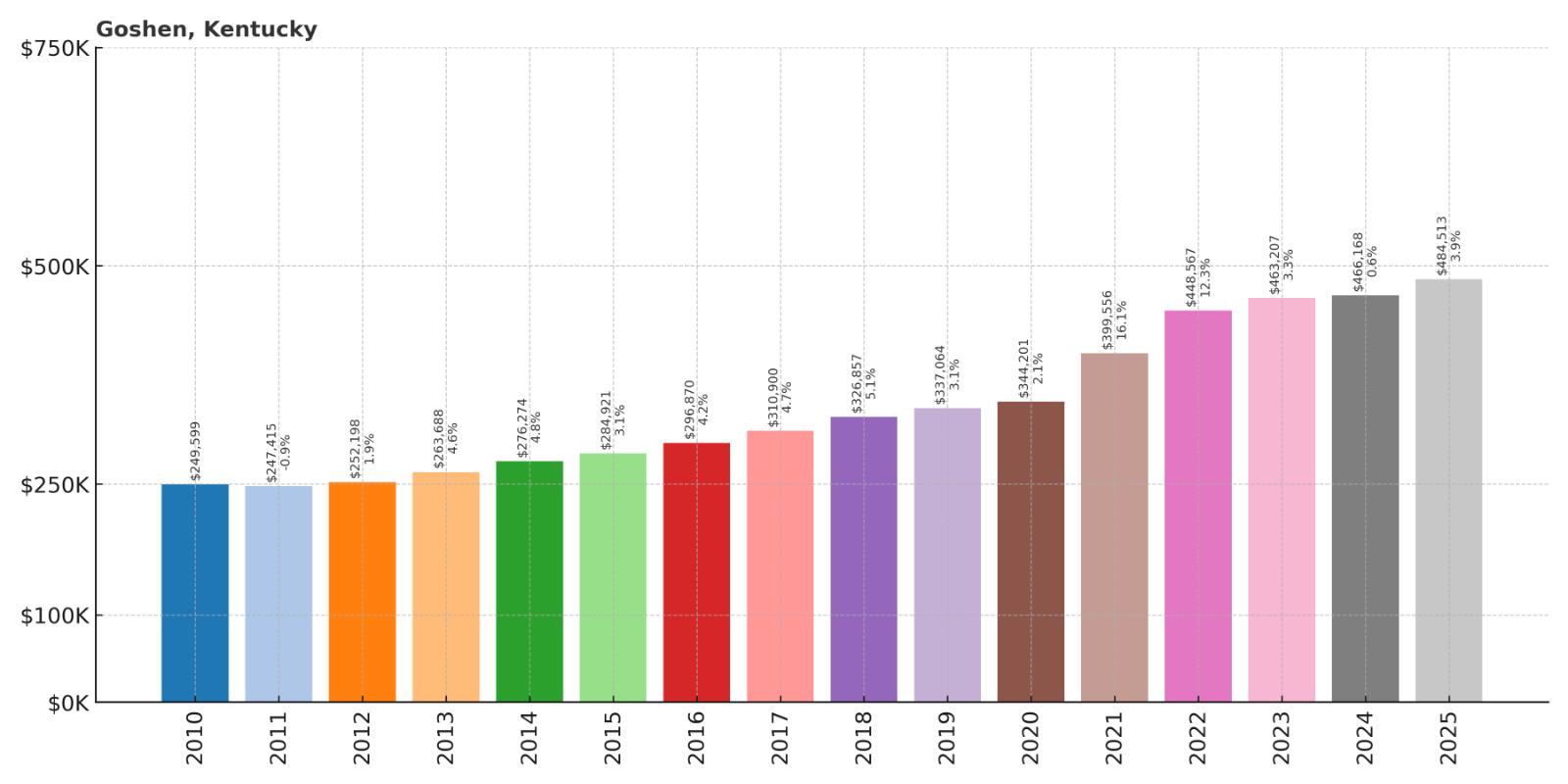
- 2010: $249,599
- 2011: $247,415
- 2012: $252,198
- 2013: $263,688
- 2014: $276,274
- 2015: $284,921
- 2016: $296,870
- 2017: $310,900
- 2018: $326,857
- 2019: $337,064
- 2020: $344,201
- 2021: $399,556
- 2022: $448,567
- 2023: $463,207
- 2024: $466,168
- 2025: $484,513
Goshen has achieved remarkable success with a 94% appreciation since 2010, soaring from $249,599 to $484,513. The historic community showed disciplined growth throughout the 2010s before pandemic-era demand sent values rocketing past $460,000. Current prices reflect Goshen’s unique position as authentic small-town Kentucky with world-class amenities, creating a lifestyle that money usually can’t buy.
Why Goshen?
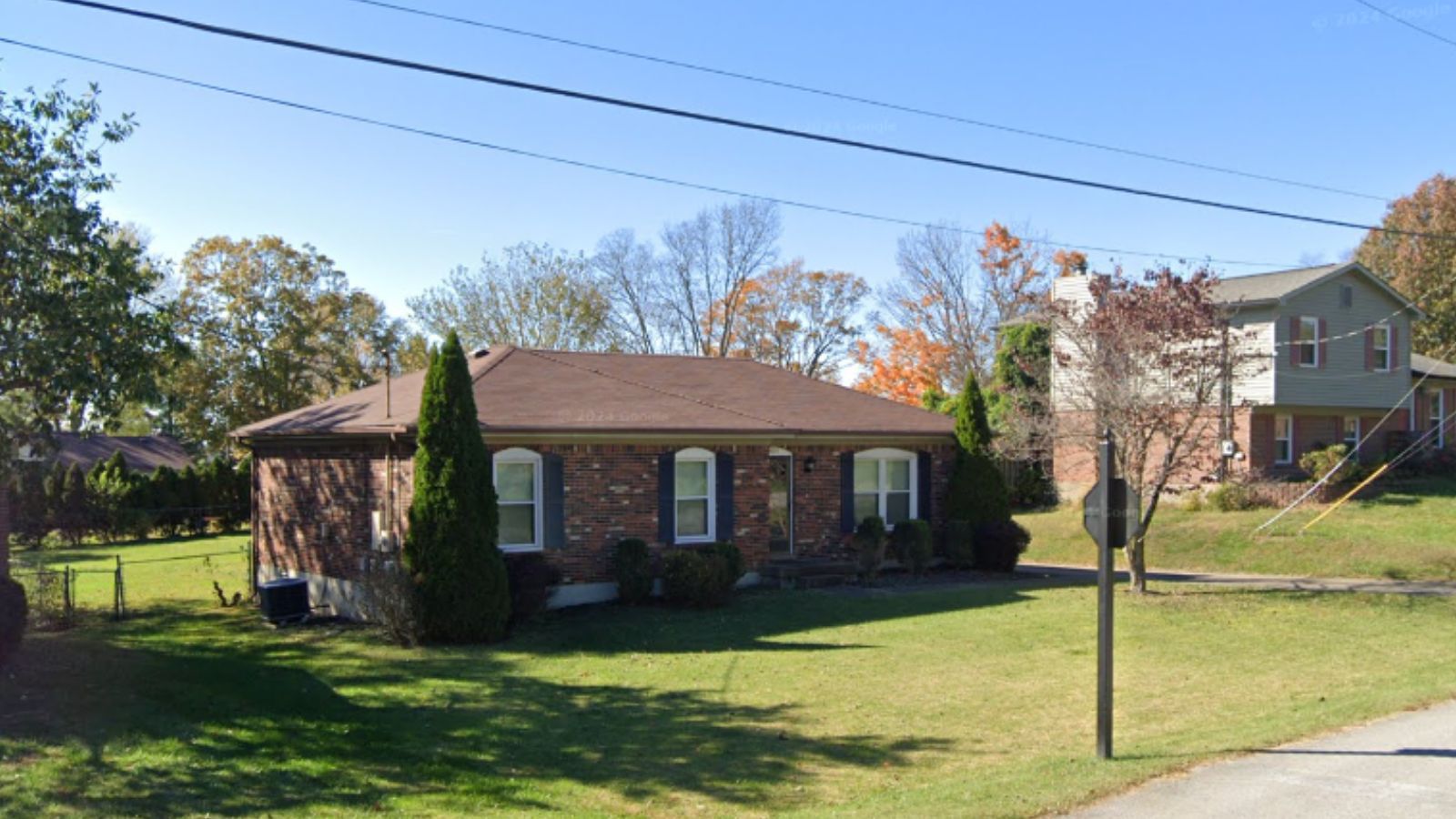
Why Are People Willing to Pay So Much to Live Here? What’s Special About It?
Goshen offers something increasingly rare in American suburbia – authentic community life where neighbors know each other and local businesses create gathering places for genuine social interaction. The historic downtown anchors daily life with walkable streets, independent shops, and restaurants that serve as neighborhood living rooms. Residents discover that premium prices buy not just housing but membership in Kentucky’s most desirable small-town community.
Beyond charm and character, Goshen delivers practical advantages that justify its premium pricing in today’s competitive market. Oldham County Schools consistently rank among Kentucky’s best, while the 20-minute drive to downtown Louisville provides access to major employment centers without urban stress. Property owners here understand they’re investing in a lifestyle that becomes more valuable as authentic communities become increasingly scarce.
How Goshen Rose to Prominence
Founded in 1793, Goshen began as a frontier trading post where pioneers gathered supplies before heading west, establishing its role as a community crossroads that continues today. The town thrived during Kentucky’s agricultural golden age, serving as county seat and commercial hub for the fertile Oldham County farmland. Victorian-era prosperity left architectural treasures that modern residents cherish as irreplaceable community assets.
The 20th century transformation from rural county seat to affluent suburb required delicate balancing between growth and preservation. Community leaders made strategic decisions to maintain downtown vitality while accommodating residential development, creating the rare suburban community with genuine urban amenities. This careful stewardship attracted discerning homebuyers who recognized Goshen’s unique combination of historic character and modern convenience.
3 Interesting Tidbits
1. Historic County Seat – Goshen served as Oldham County’s seat of government for over 50 years, leaving a legacy of civic buildings and courthouse square architecture that defines the town center.
2. Railroad Heritage – The historic Goshen depot, built in 1914, now serves as a community center and symbol of the town’s transportation legacy that connected rural Kentucky to broader markets.
3. Festival Tradition – The annual Goshen Days celebration draws thousands of visitors, showcasing the community spirit and civic engagement that make this small town feel like an extended neighborhood.
1. Prospect – 77% Home Price Increase Since 2010
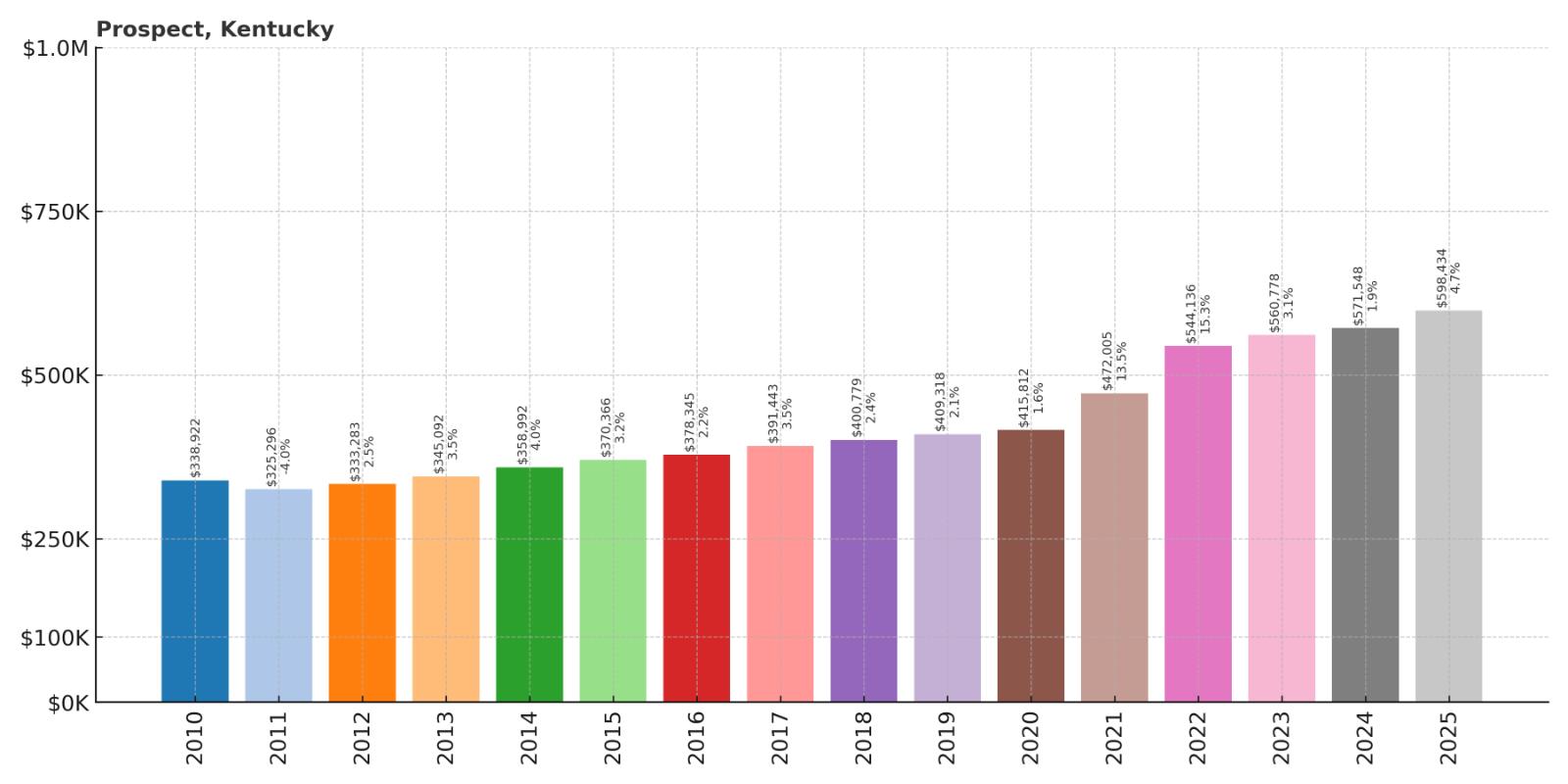
- 2010: $338,922
- 2011: $325,296
- 2012: $333,283
- 2013: $345,092
- 2014: $358,992
- 2015: $370,366
- 2016: $378,345
- 2017: $391,443
- 2018: $400,779
- 2019: $409,318
- 2020: $415,812
- 2021: $472,005
- 2022: $544,136
- 2023: $560,778
- 2024: $571,548
- 2025: $598,434
Prospect reigns as Kentucky’s most expensive residential market with a solid 77% increase since 2010, rising from $338,922 to an impressive $598,434. Starting from the state’s highest baseline, Prospect demonstrated steady appreciation before pandemic demand pushed values past the $570,000 threshold. Current pricing reflects Prospect’s unmatched combination of exclusivity, amenities, and investment performance that defines Kentucky’s luxury real estate pinnacle.
Why Prospect?
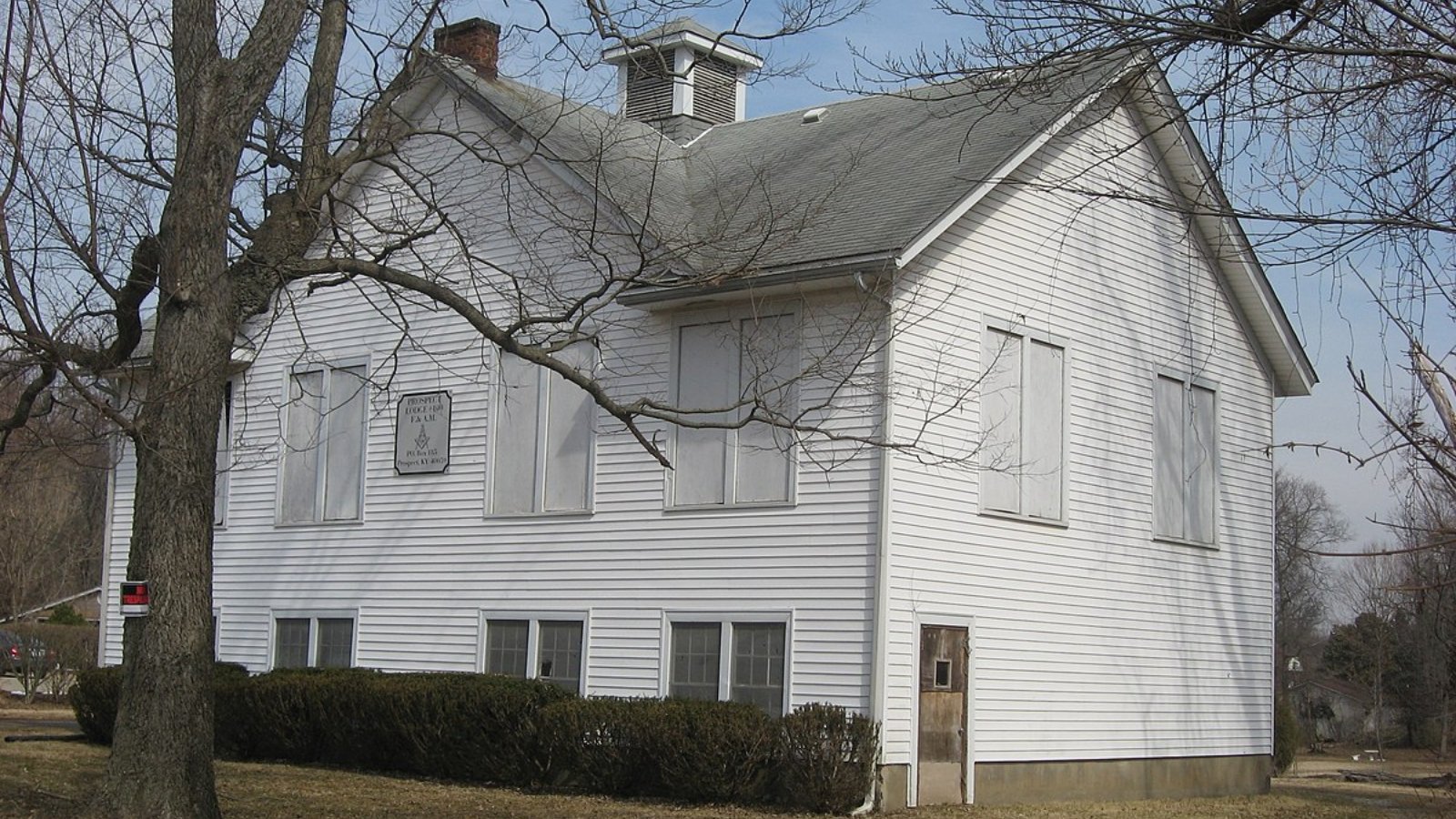
Why Are People Willing to Pay So Much to Live Here? What’s Special About It?
Prospect represents Kentucky’s ultimate residential achievement, where generational wealth meets world-class amenities in an environment designed for the state’s most successful residents. The community features custom estates, private country clubs, and exclusive recreational facilities that create a lifestyle unavailable elsewhere in Kentucky. Residents enjoy privacy and security while maintaining convenient access to Louisville’s business district and cultural venues.
Beyond luxury amenities, Prospect offers something more valuable than money alone can provide – social capital and networking opportunities that enhance both personal and professional success. The community attracts CEOs, prominent attorneys, successful entrepreneurs, and other high achievers who create an environment where excellence becomes the standard. Property ownership here provides not just housing but membership in Kentucky’s most influential residential community.
How Prospect Rose to Prominence
Prospect’s story begins in the 1850s when wealthy Louisville merchants built summer estates along the newly completed Louisville & Frankfort Railroad, seeking respite from city heat in the scenic countryside. These early residents established the pattern of large lots and quality construction that continues to define the community today. The railroad connection allowed residents to maintain city business interests while enjoying country estate living.
The 20th century brought transformation from seasonal retreat to year-round residential community as improved transportation made daily commuting practical. Strategic planning preserved large lots and estate-style development while adding modern amenities including country clubs and private schools. The community’s evolution from railroad suburb to exclusive enclave created Kentucky’s most prestigious address through careful stewardship of its unique character and natural advantages.
3 Interesting Tidbits
1. Railroad Aristocracy – Prospect began as a retreat for Louisville’s railroad barons and industrial leaders, establishing traditions of wealth and exclusivity that continue today.
2. Country Club Culture – The community features multiple private clubs including Harmony Landing Country Club and Big Spring Country Club, creating recreational and social opportunities unavailable elsewhere in Kentucky.
3. Educational Excellence – Many residents choose private schools including Louisville Collegiate and Kentucky Country Day, reinforcing the community’s commitment to educational achievement and social distinction.
